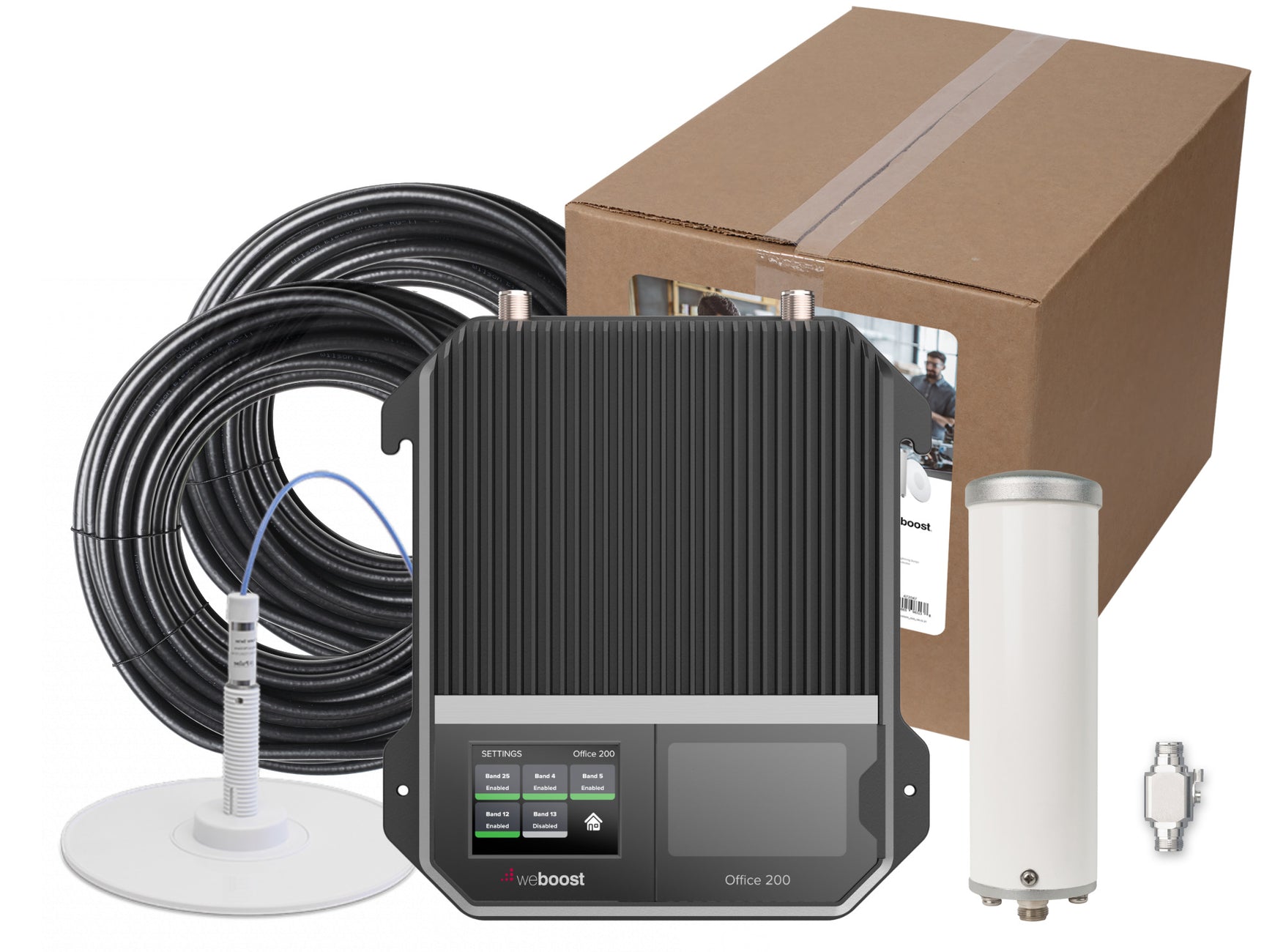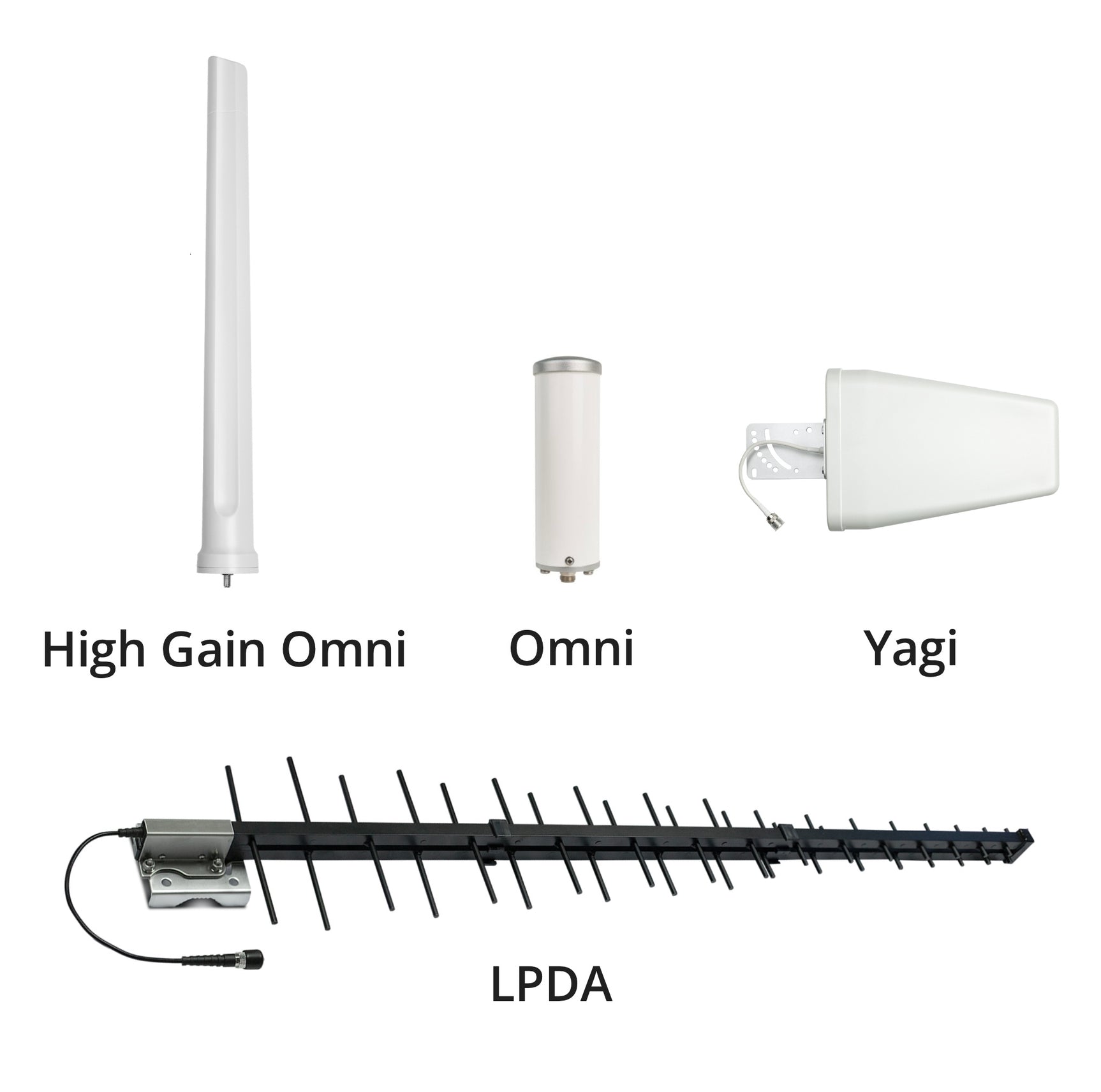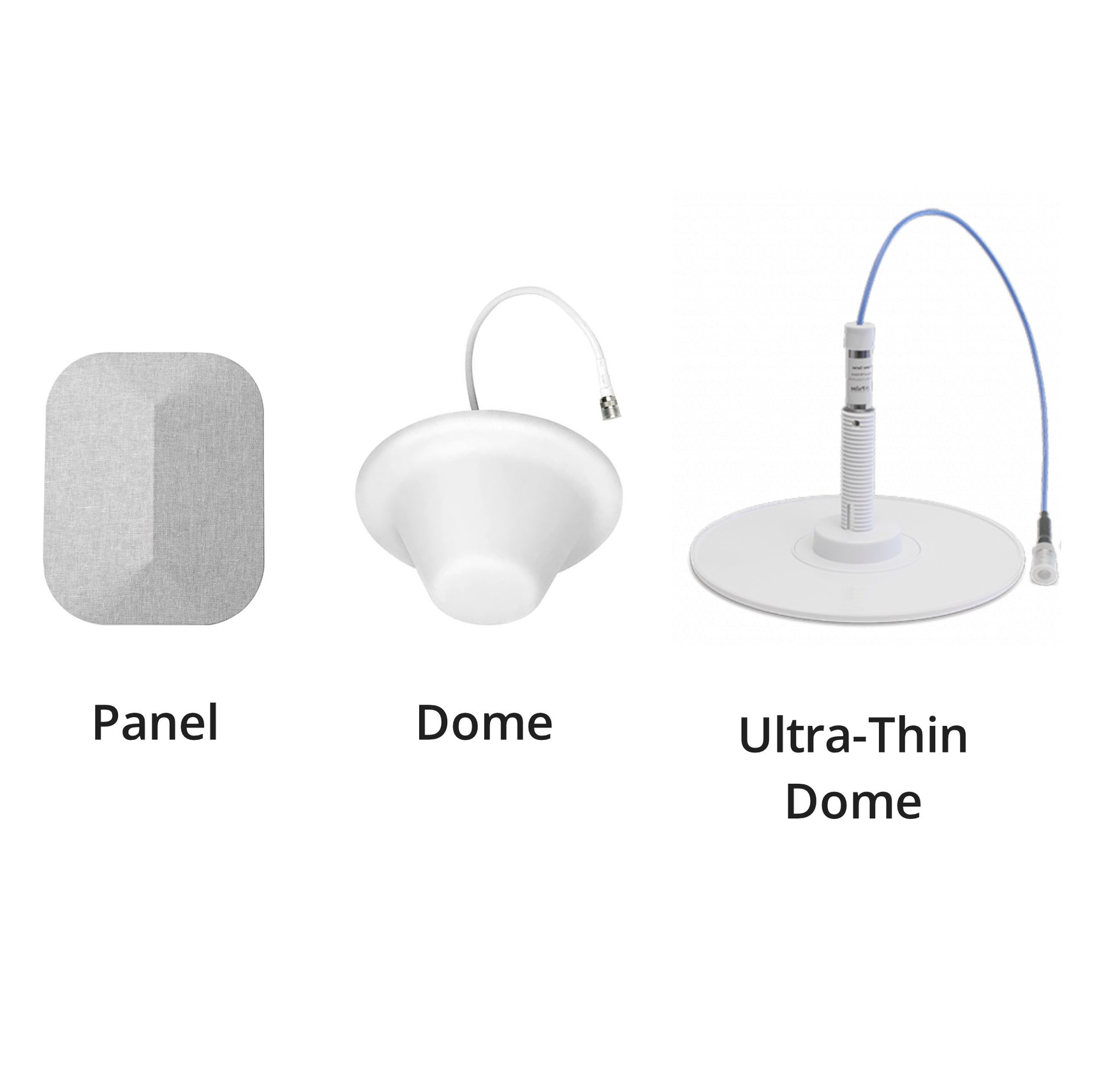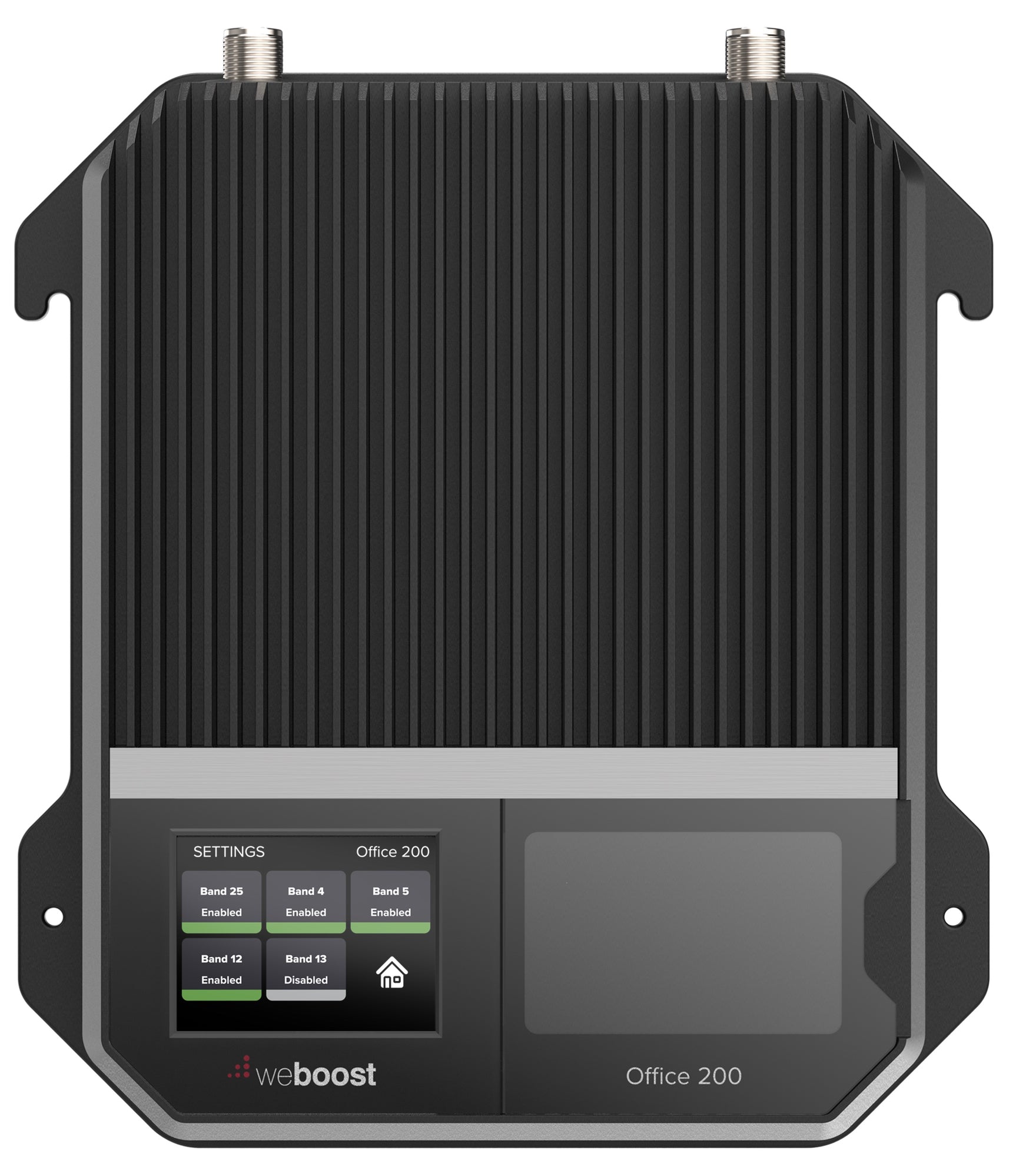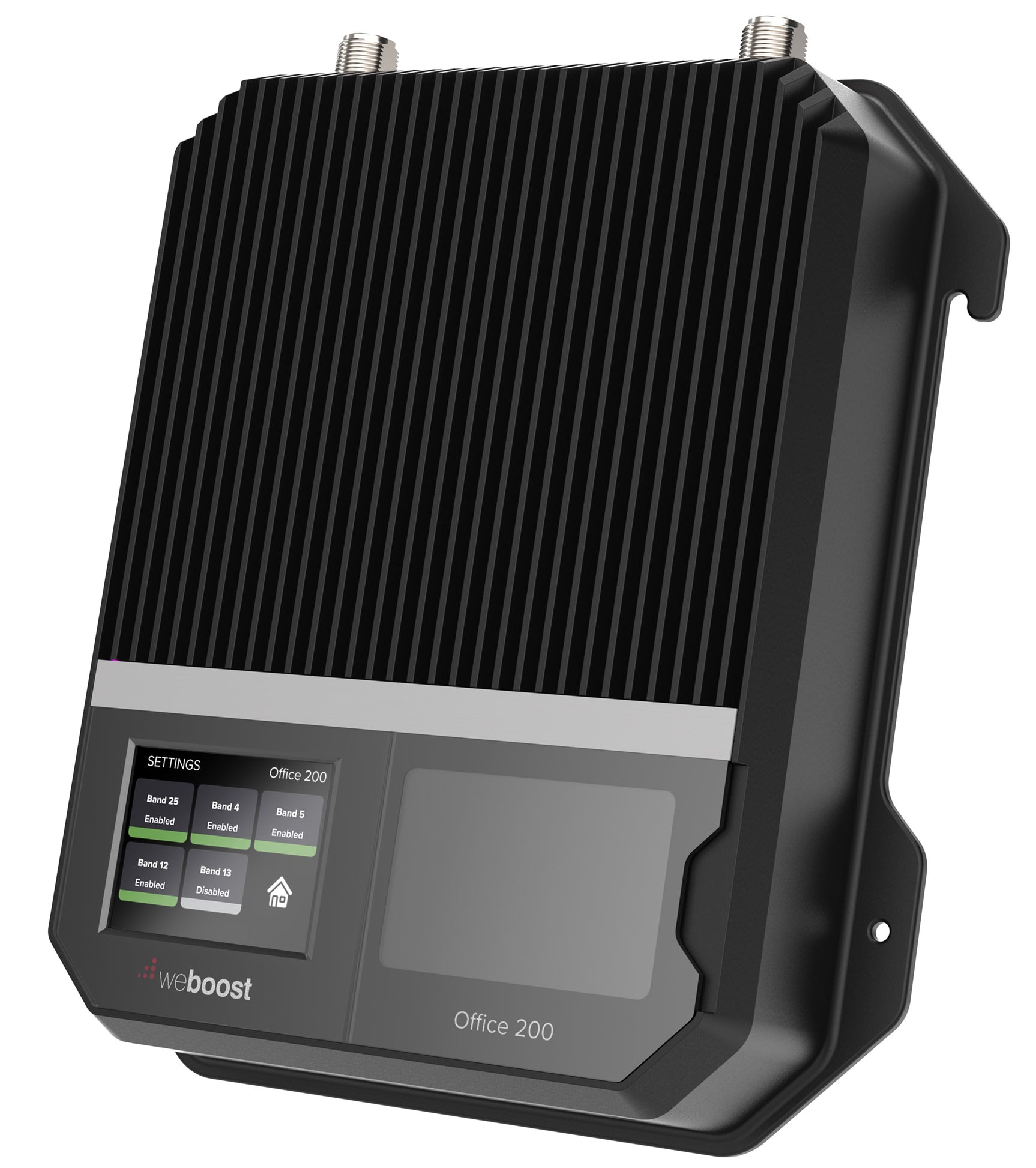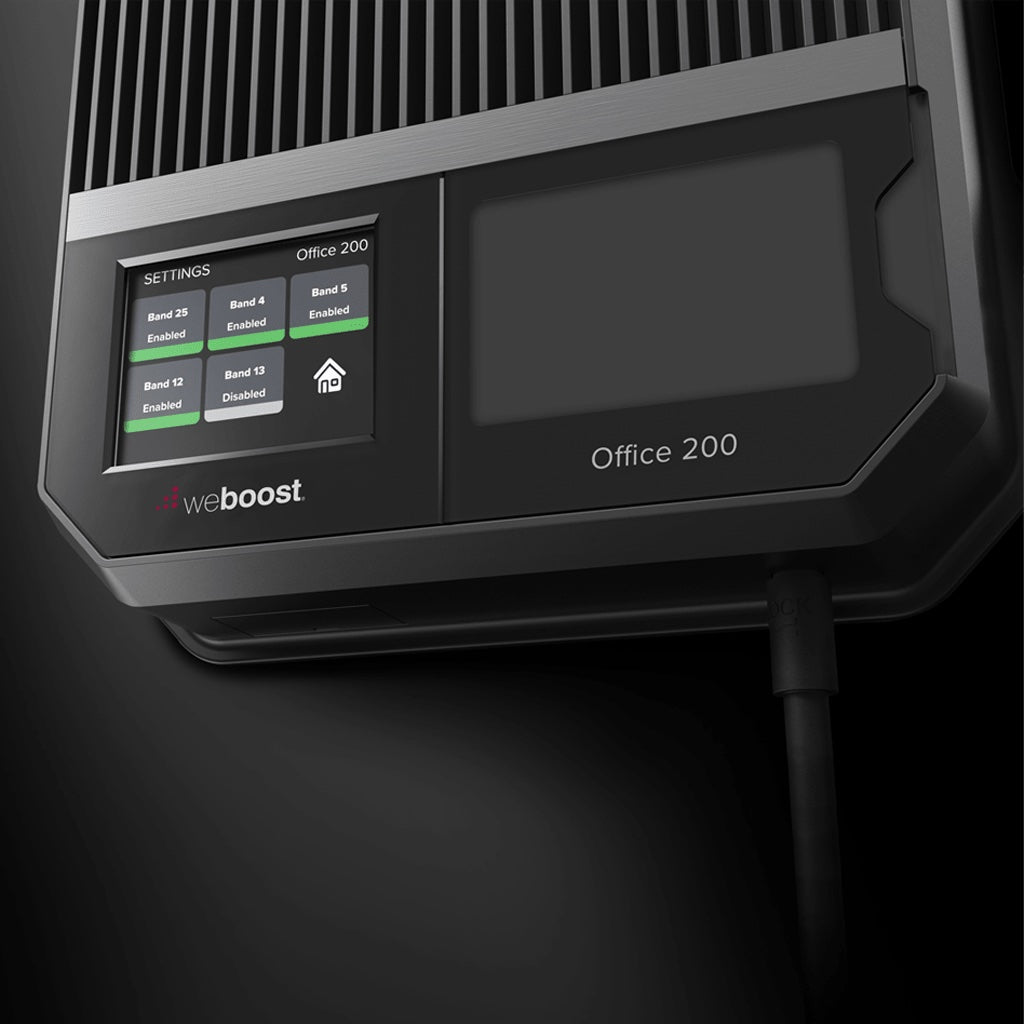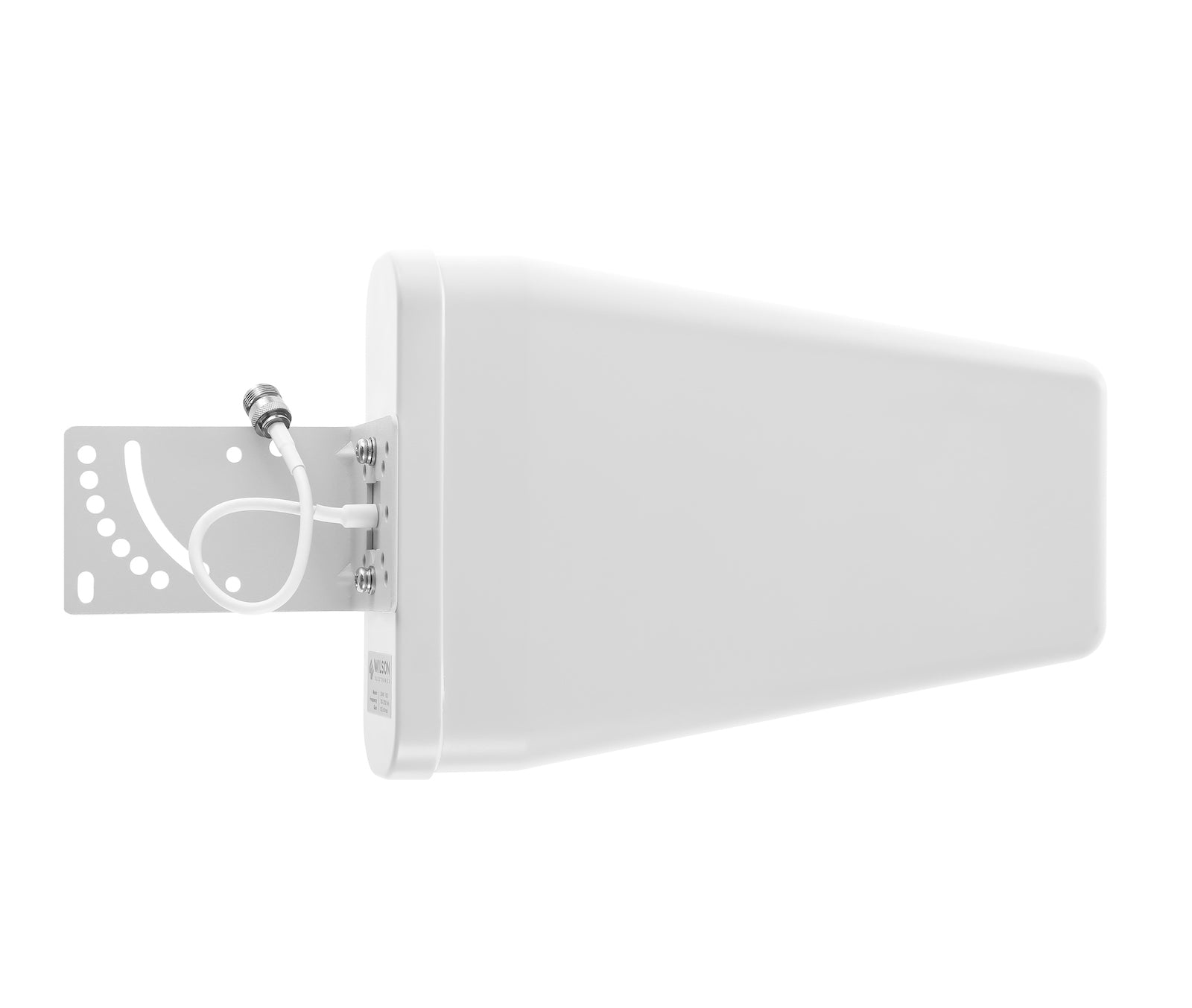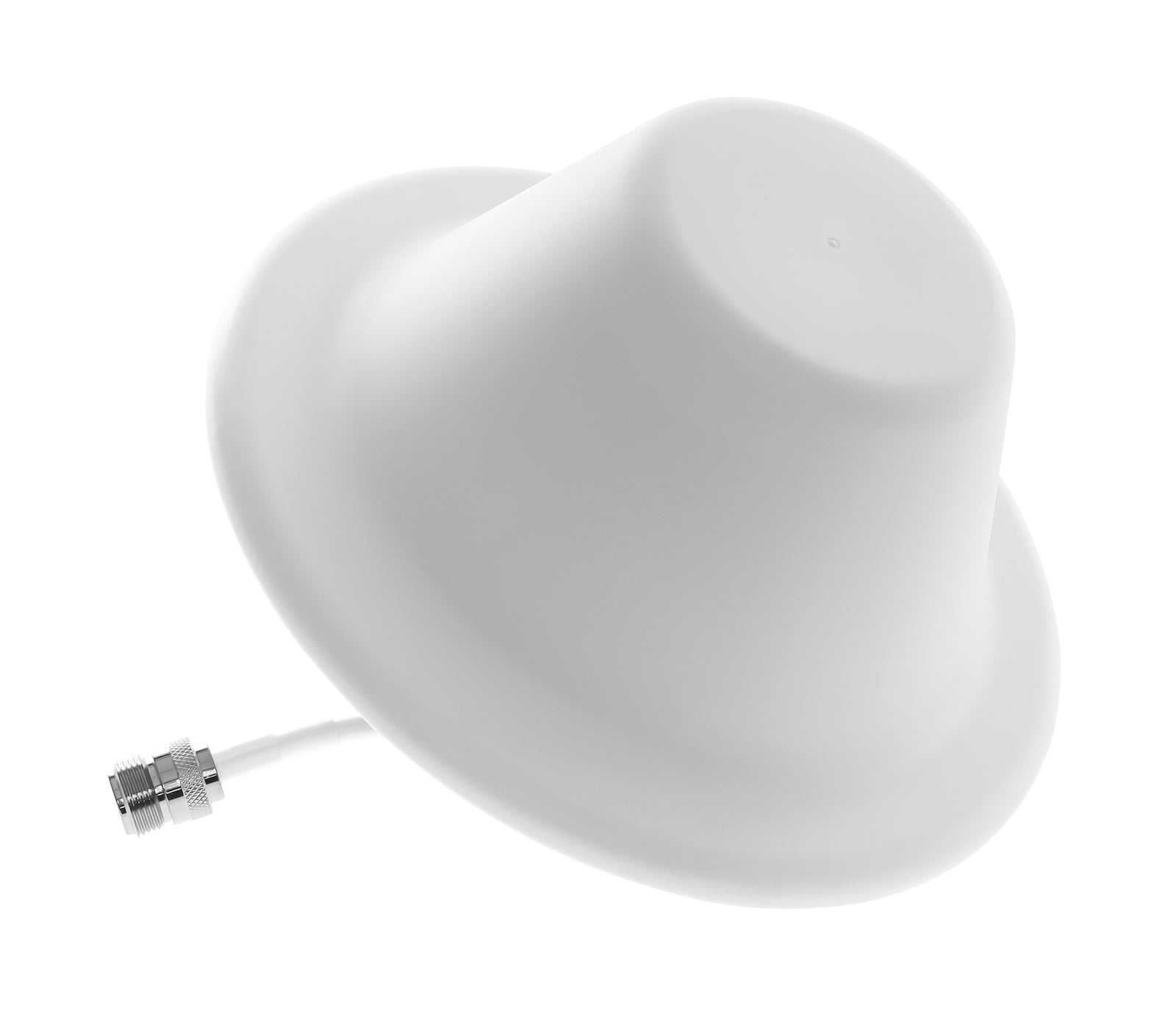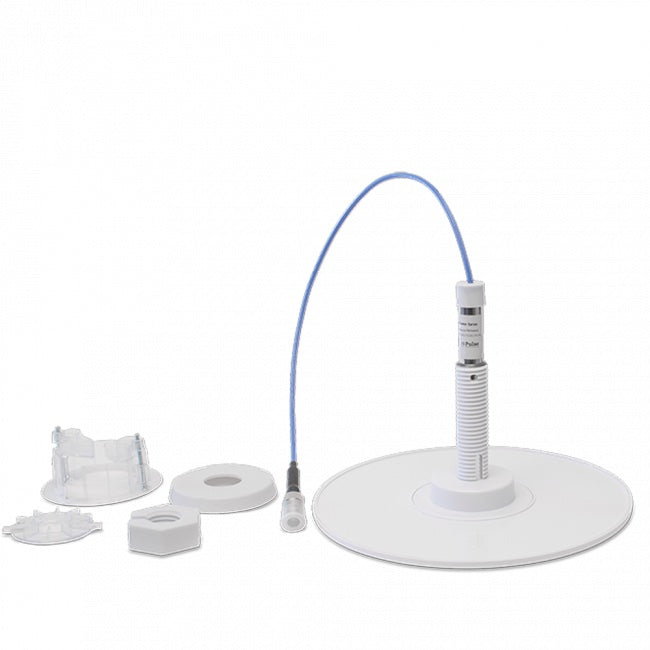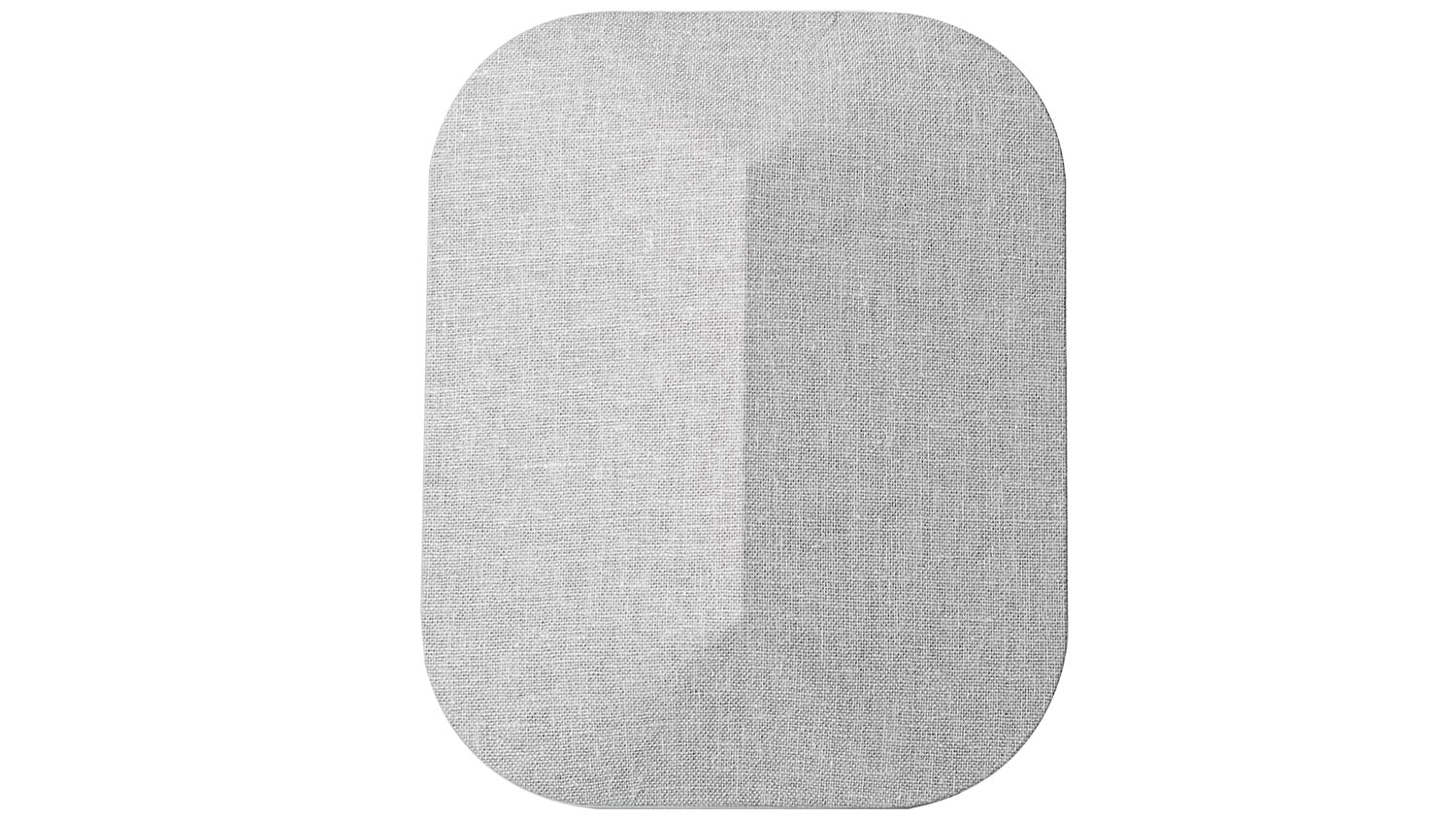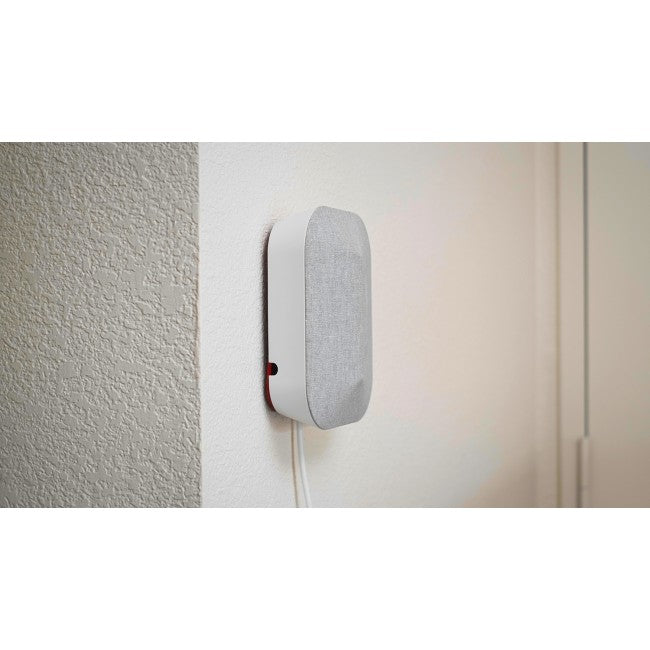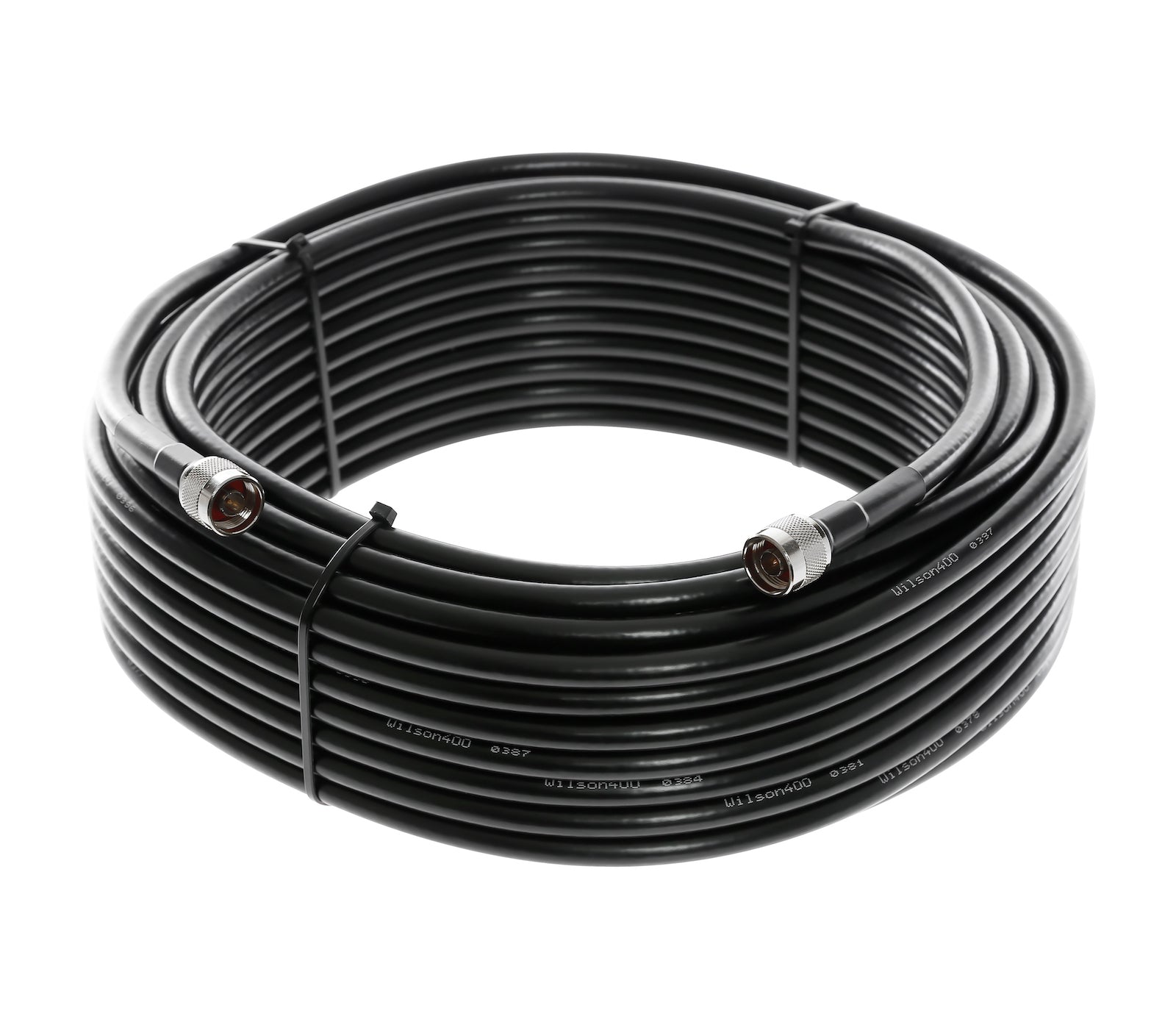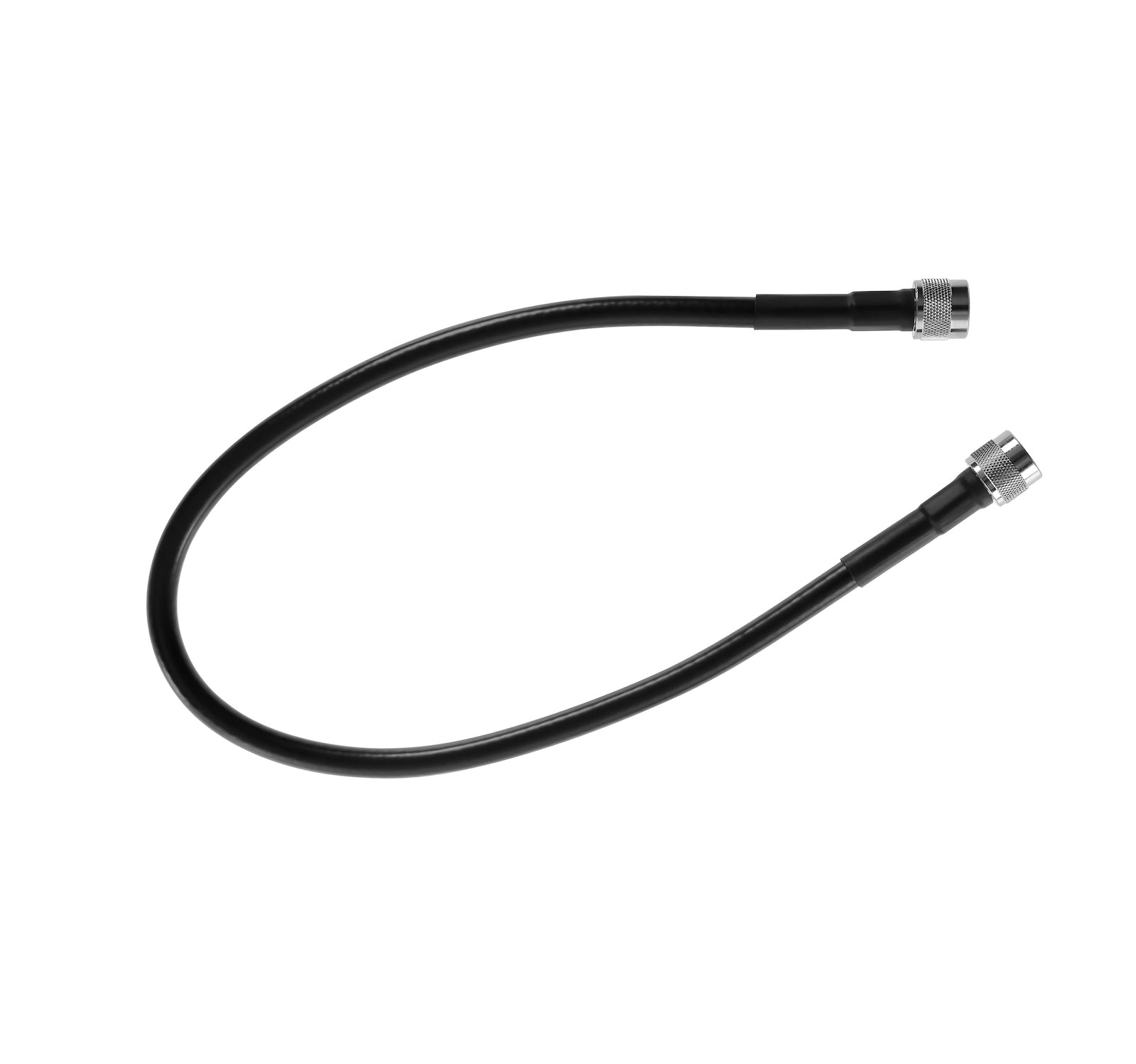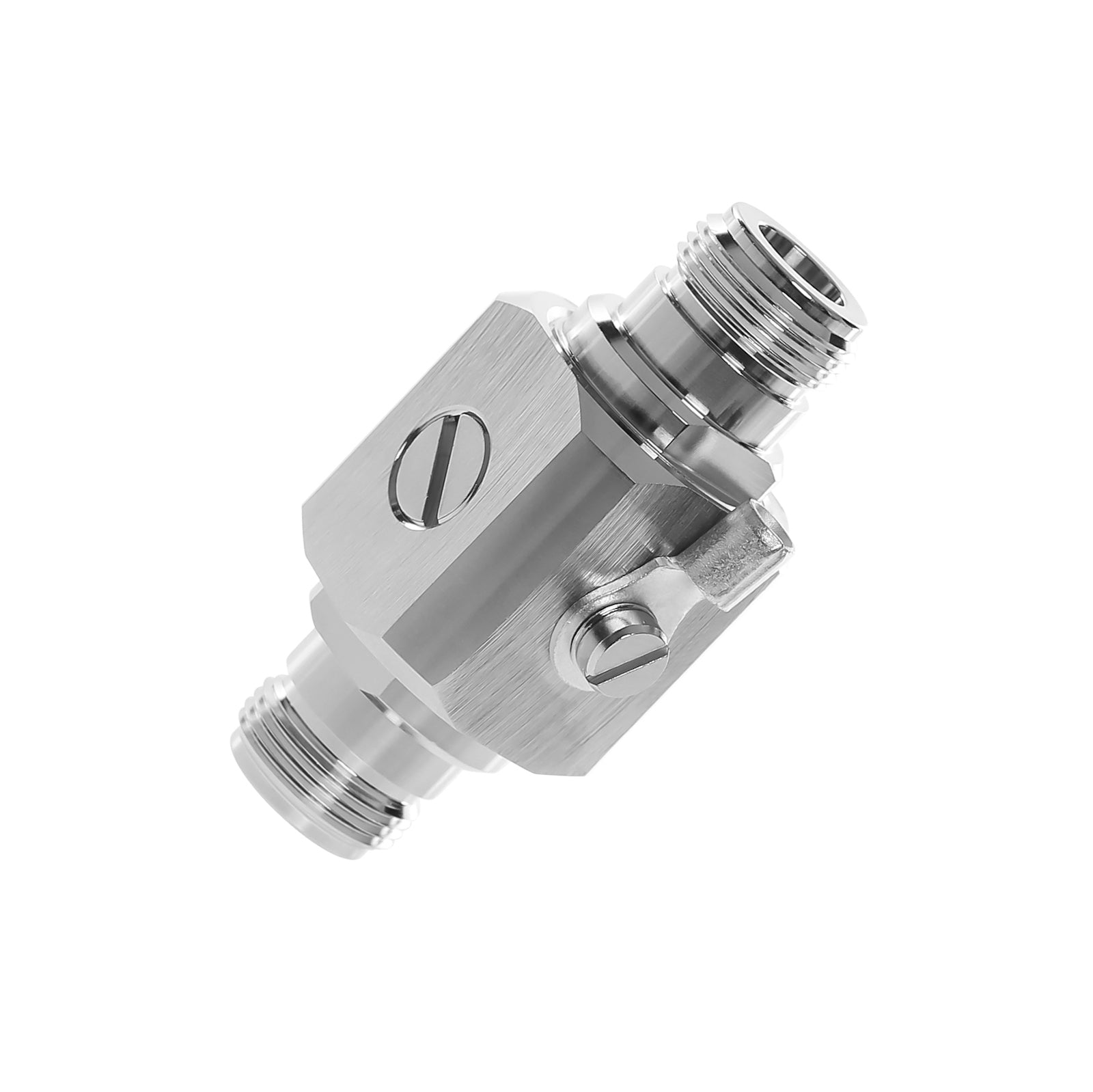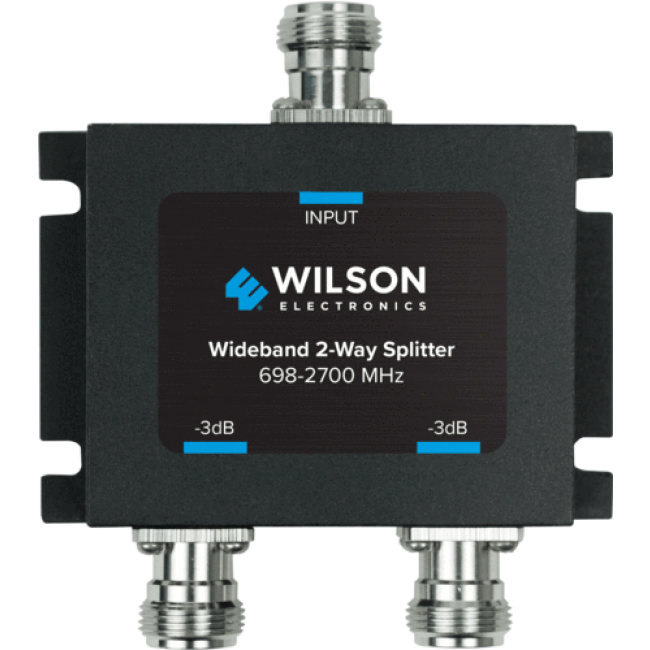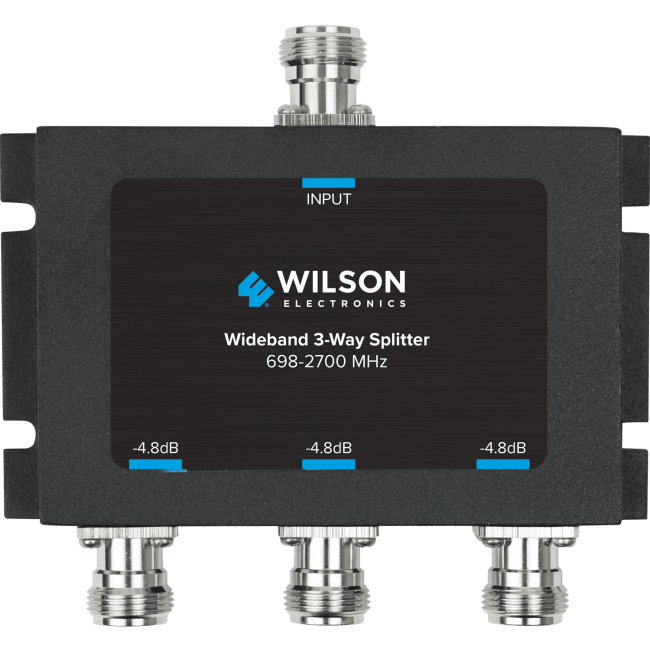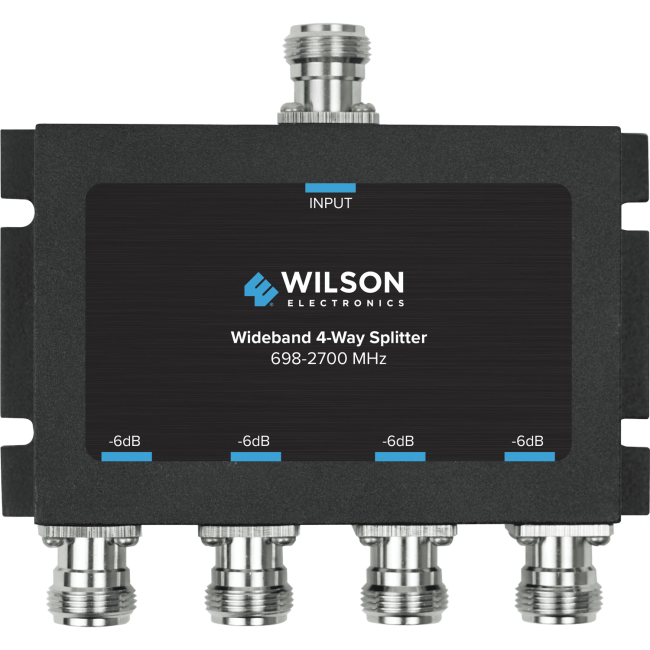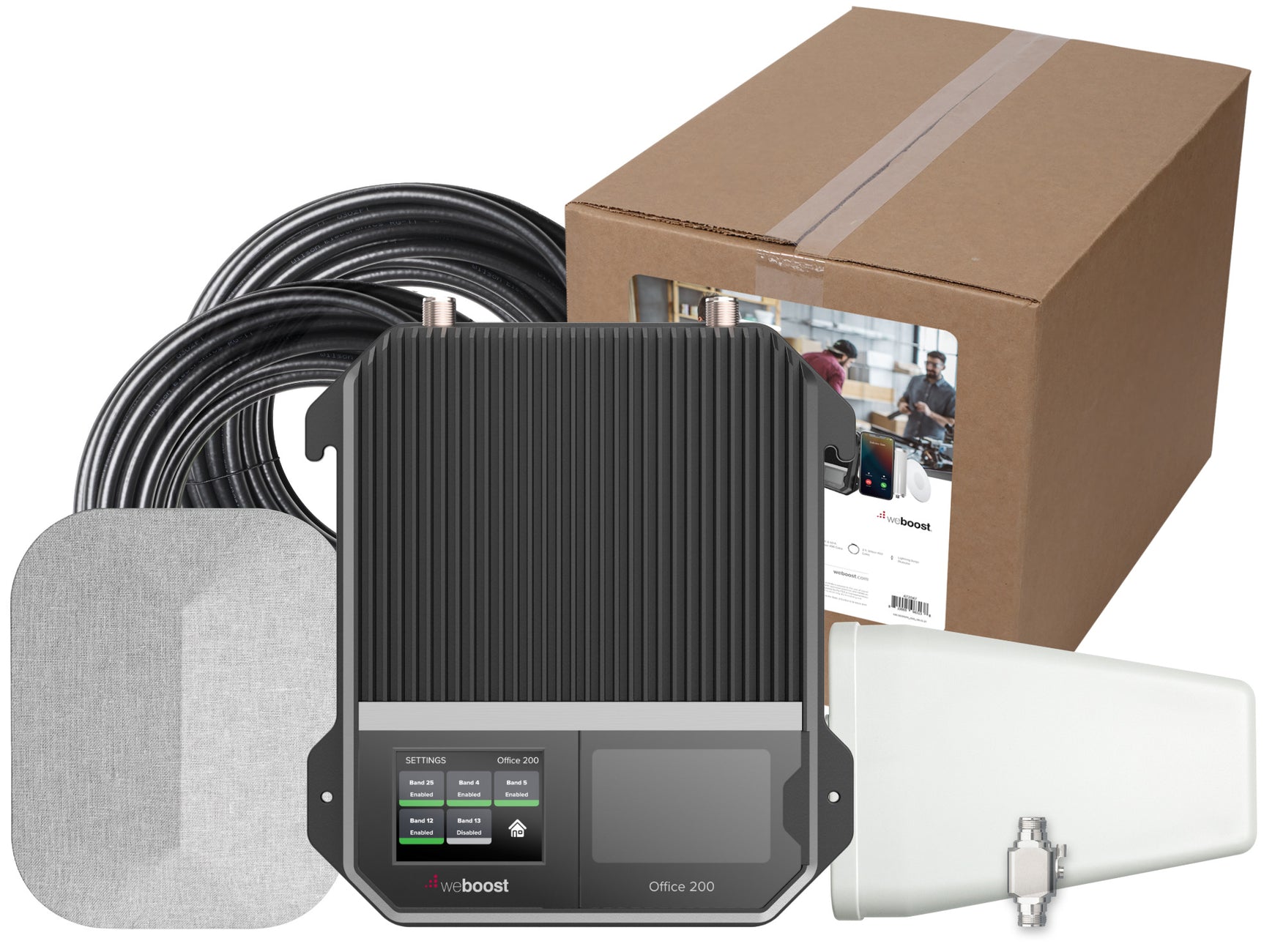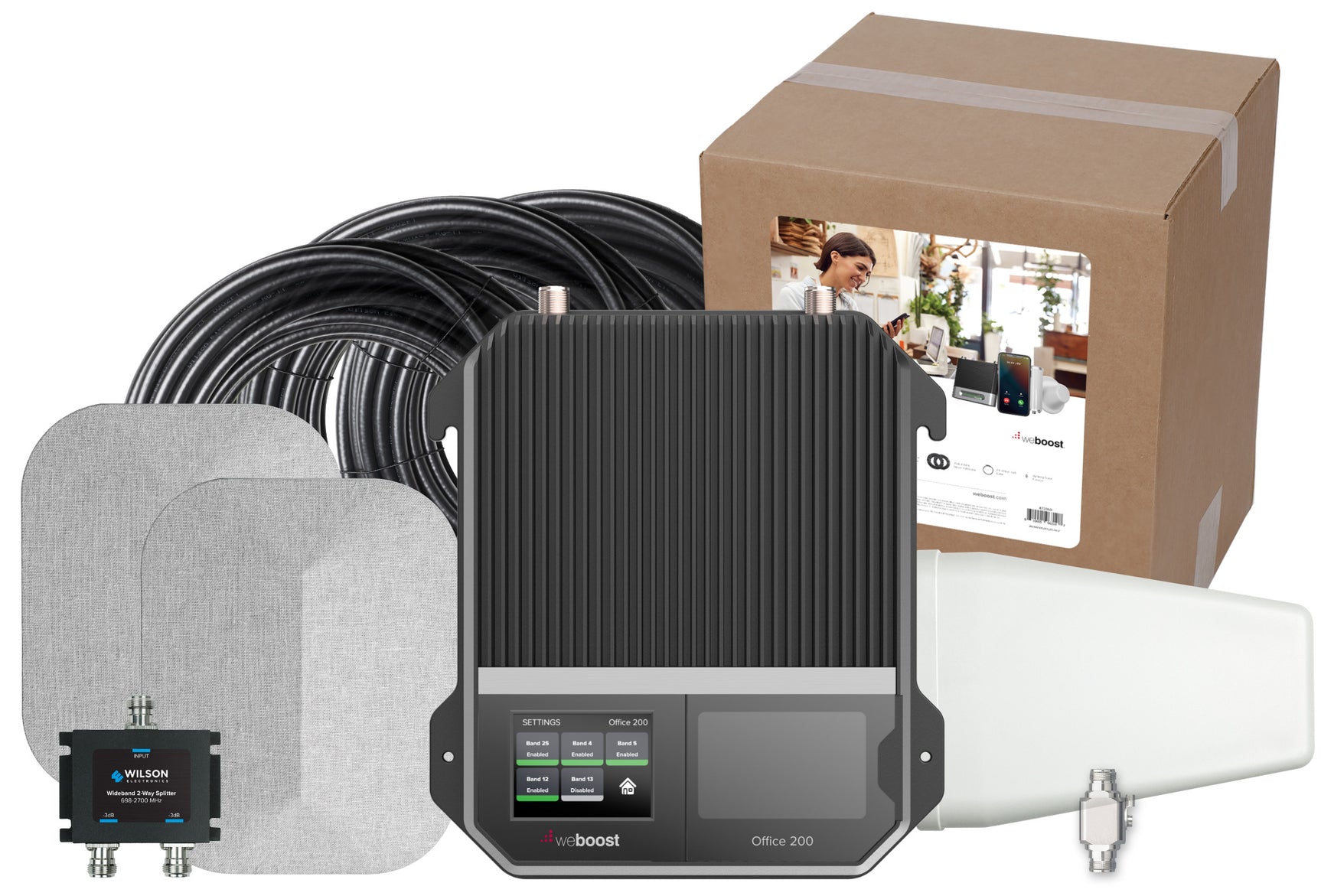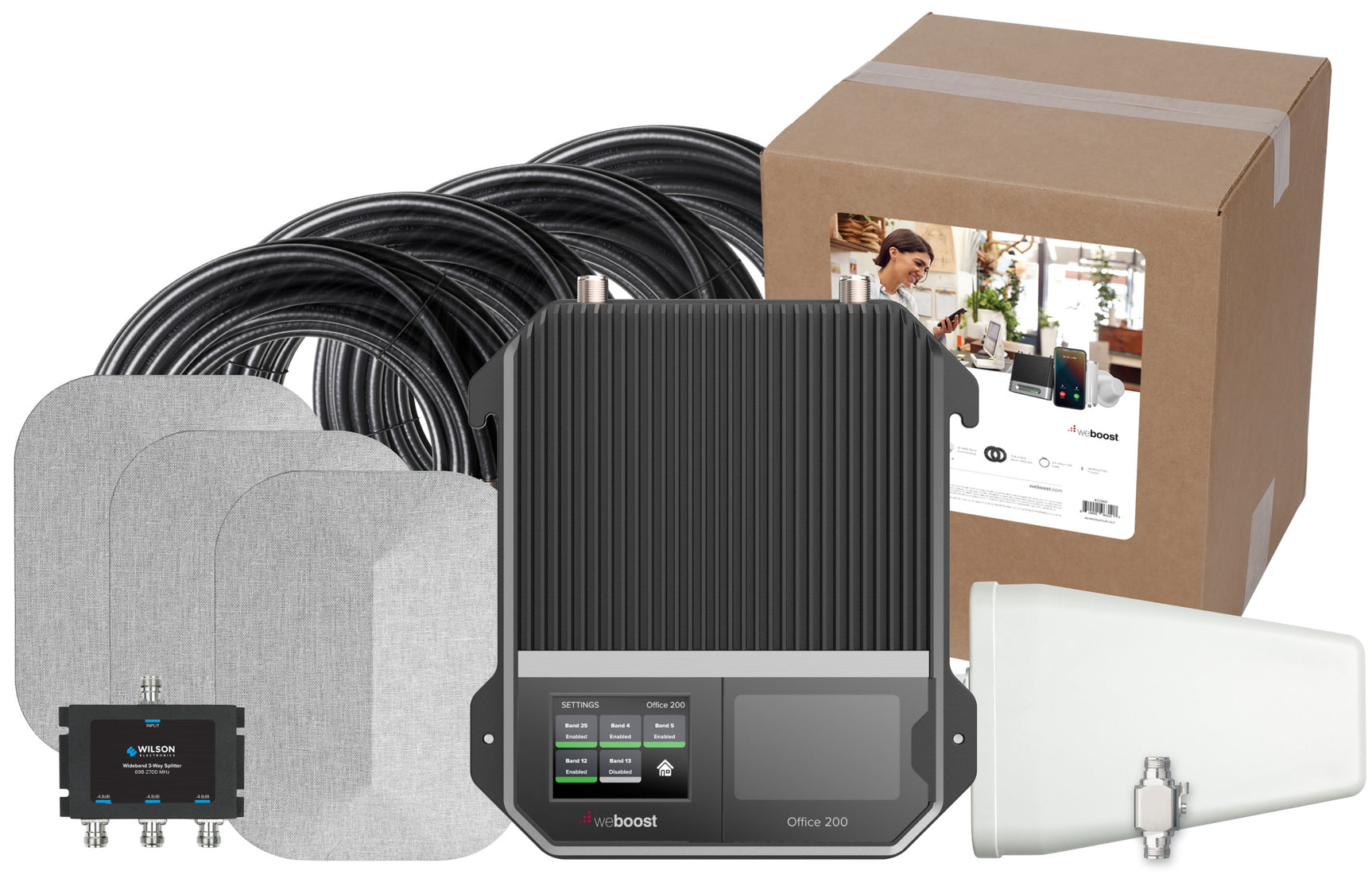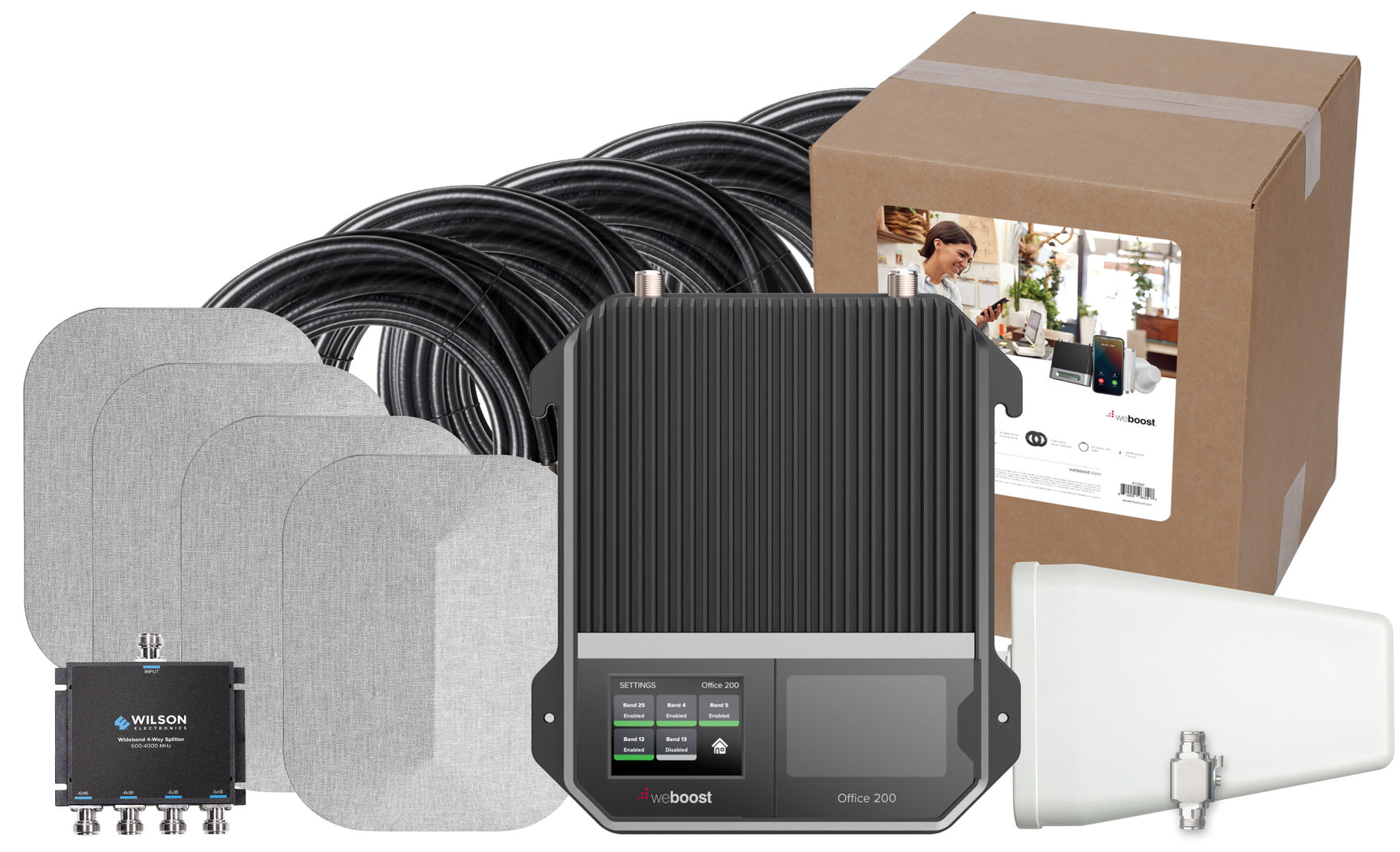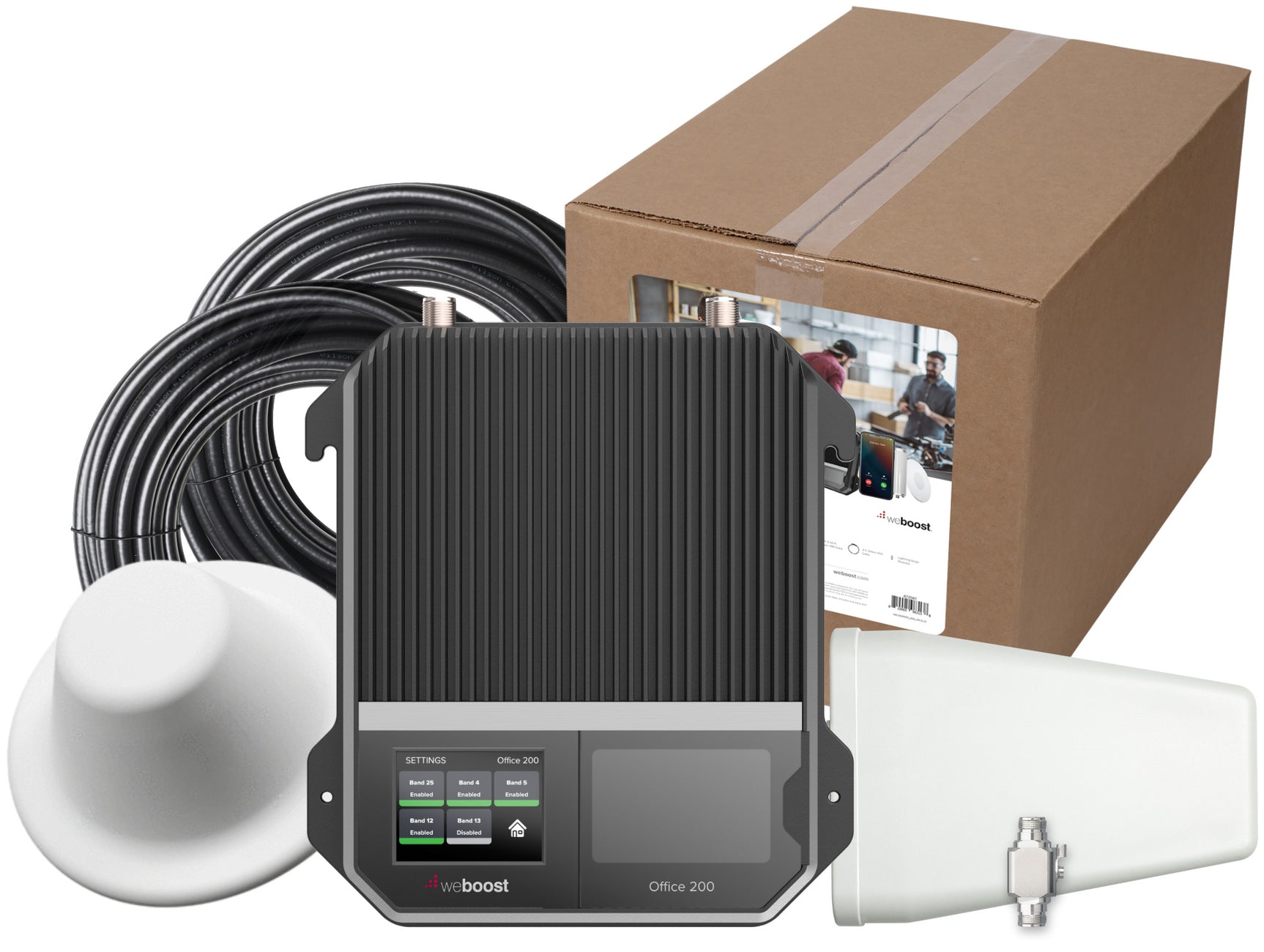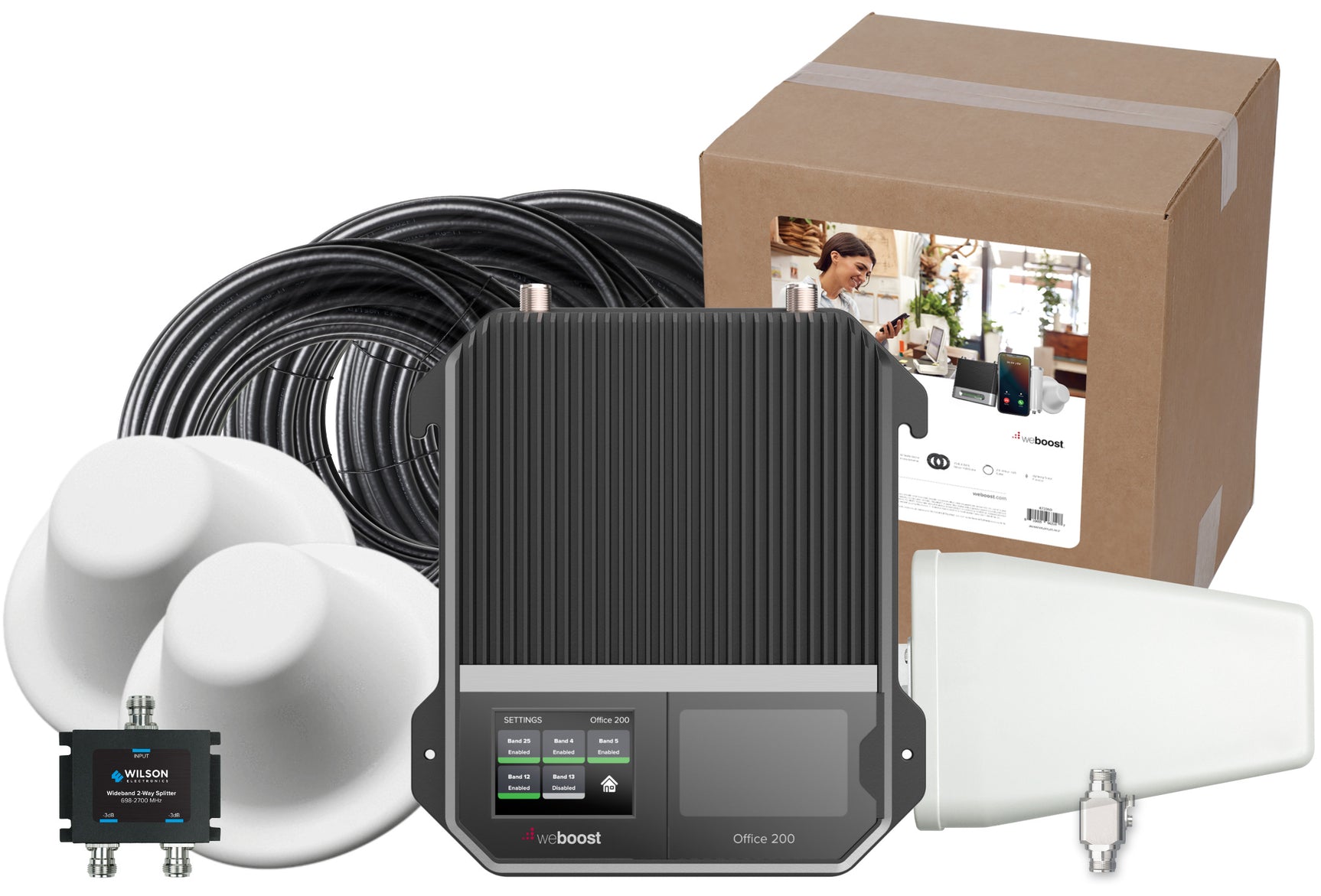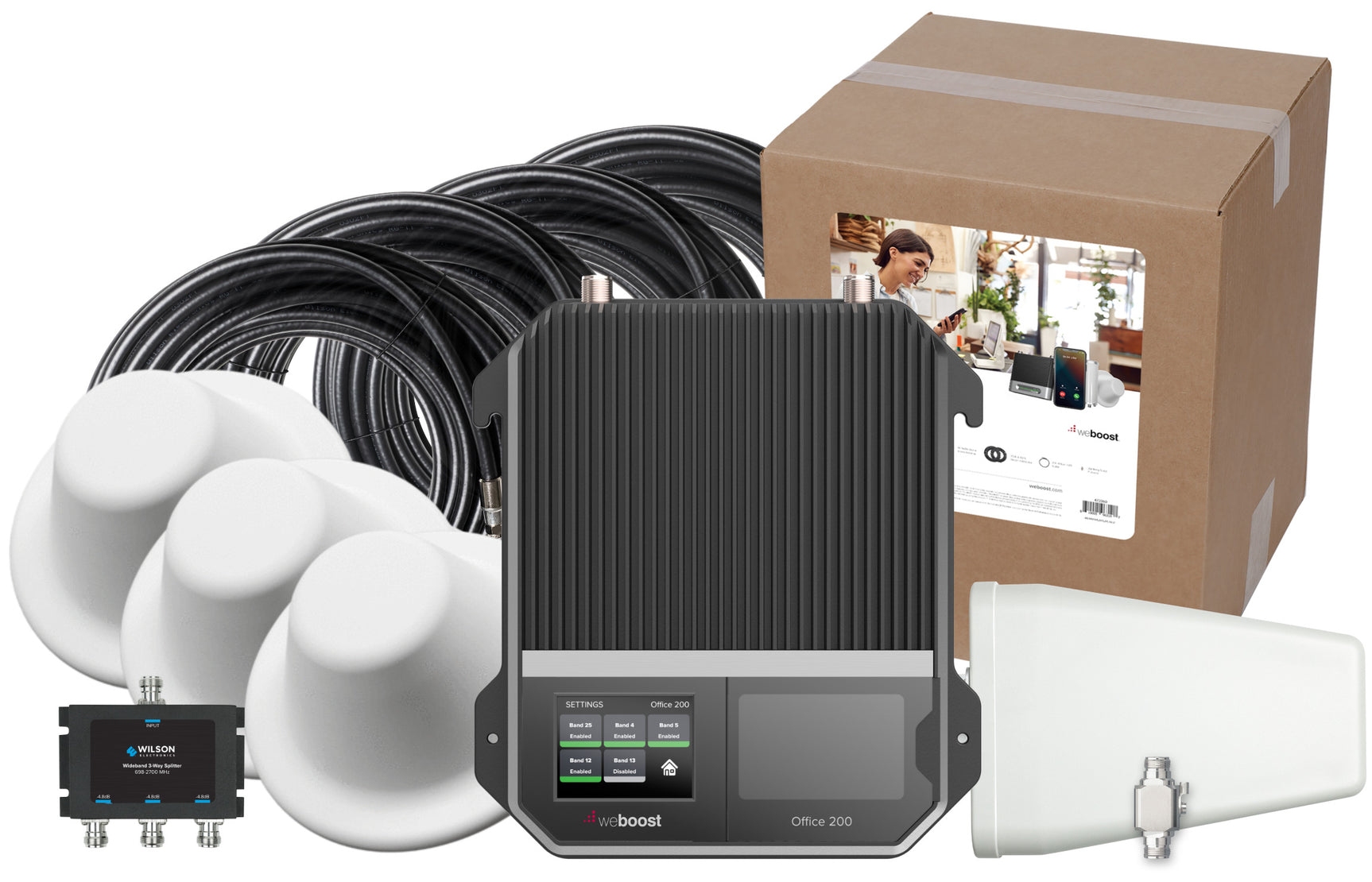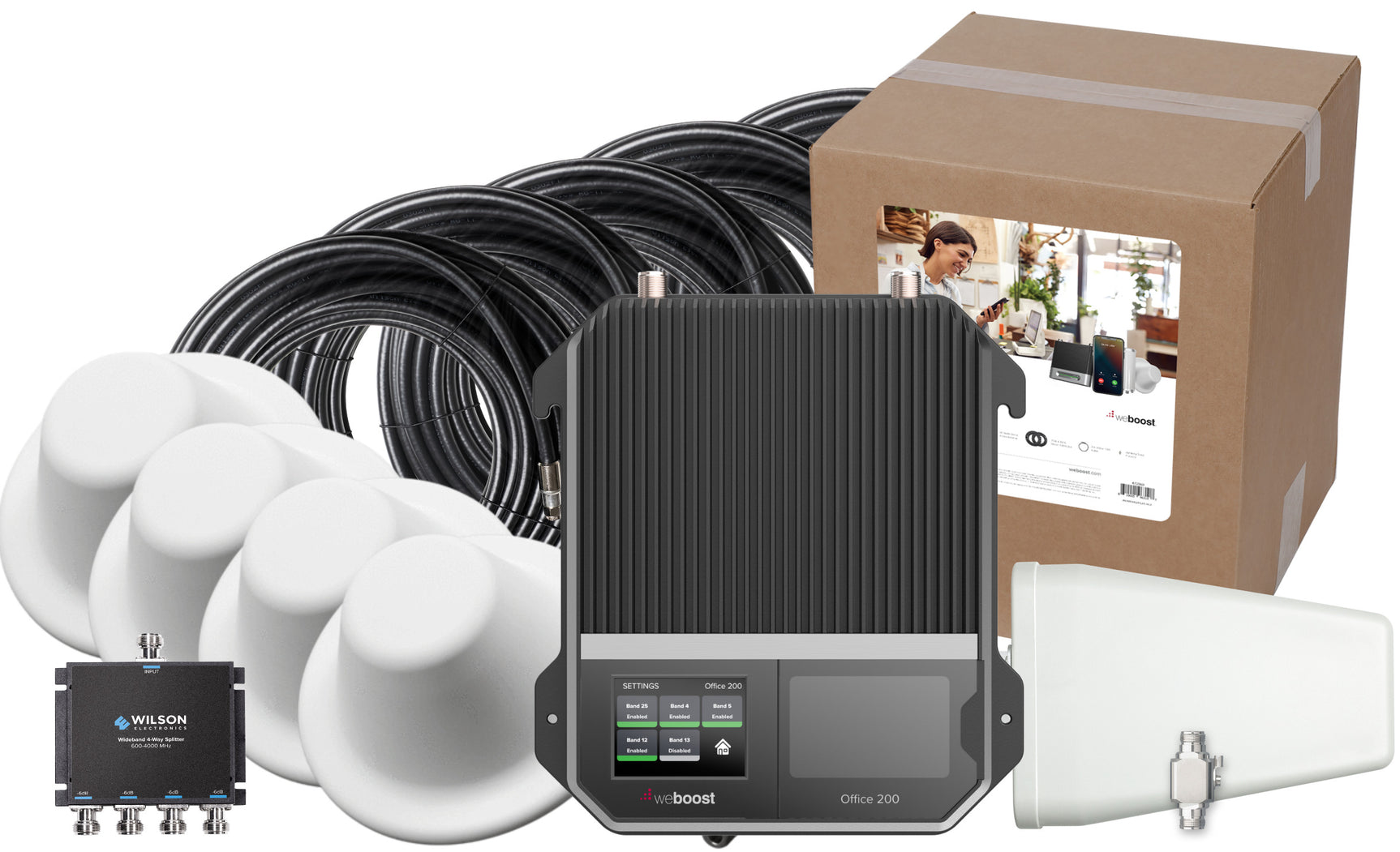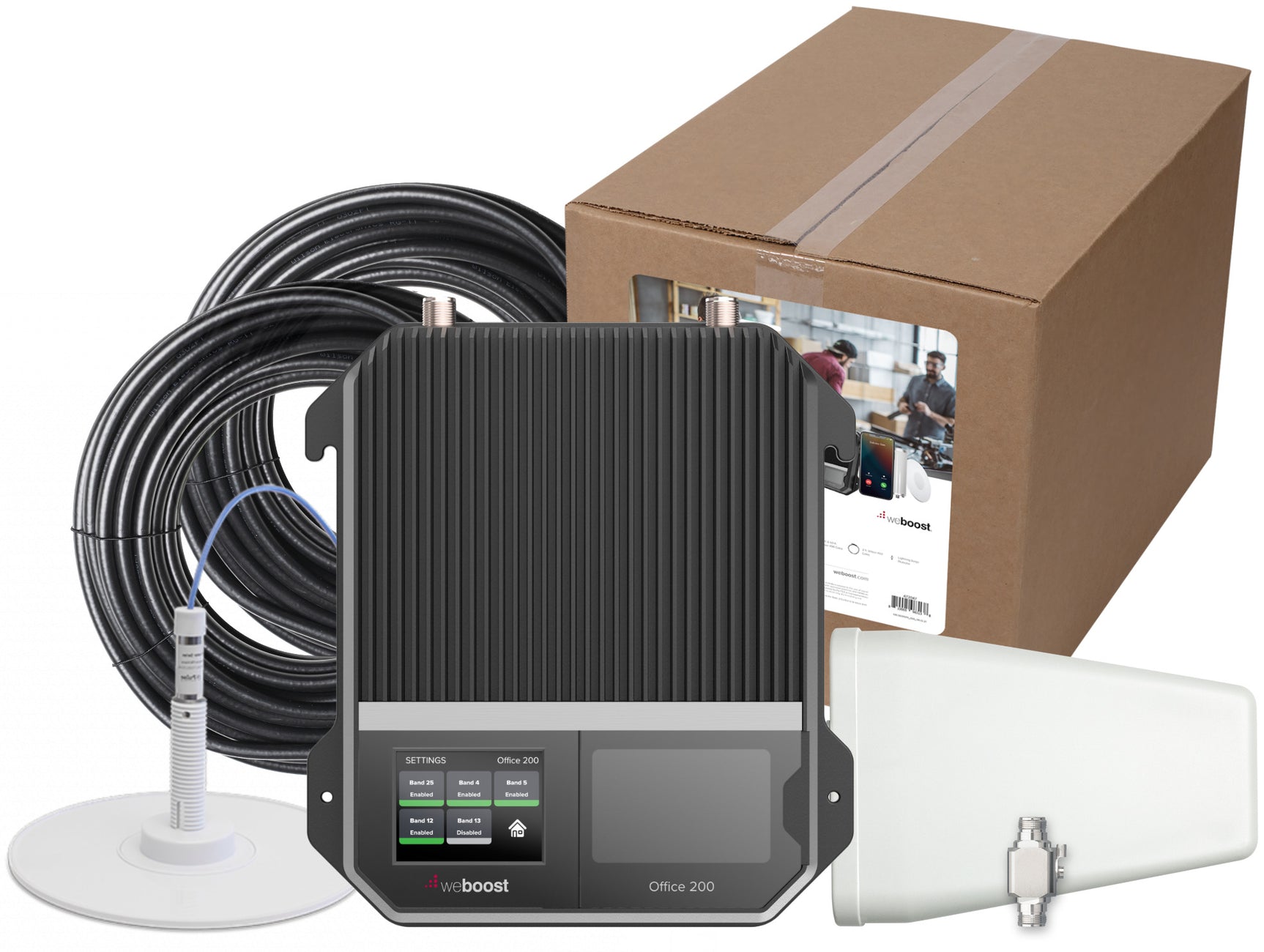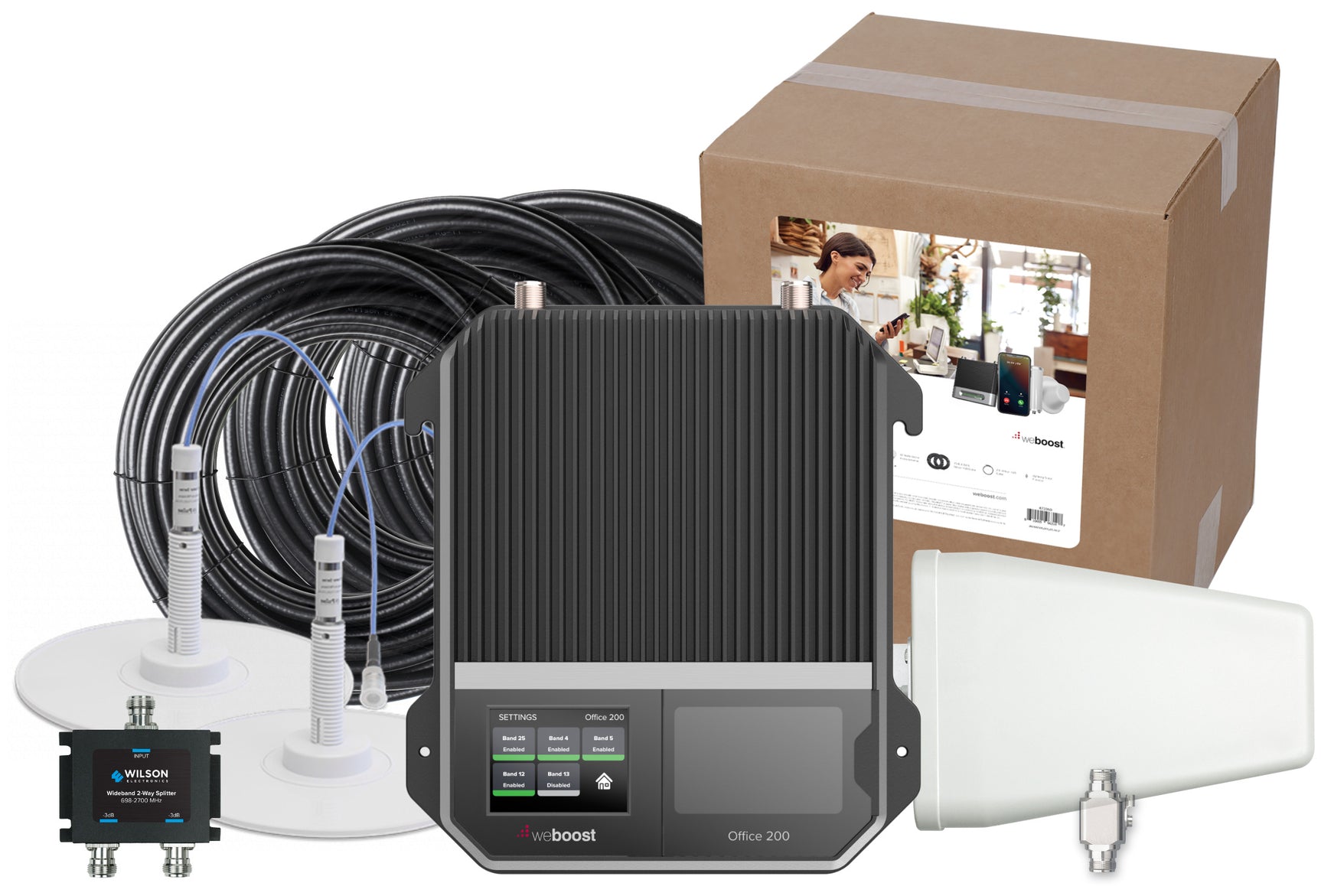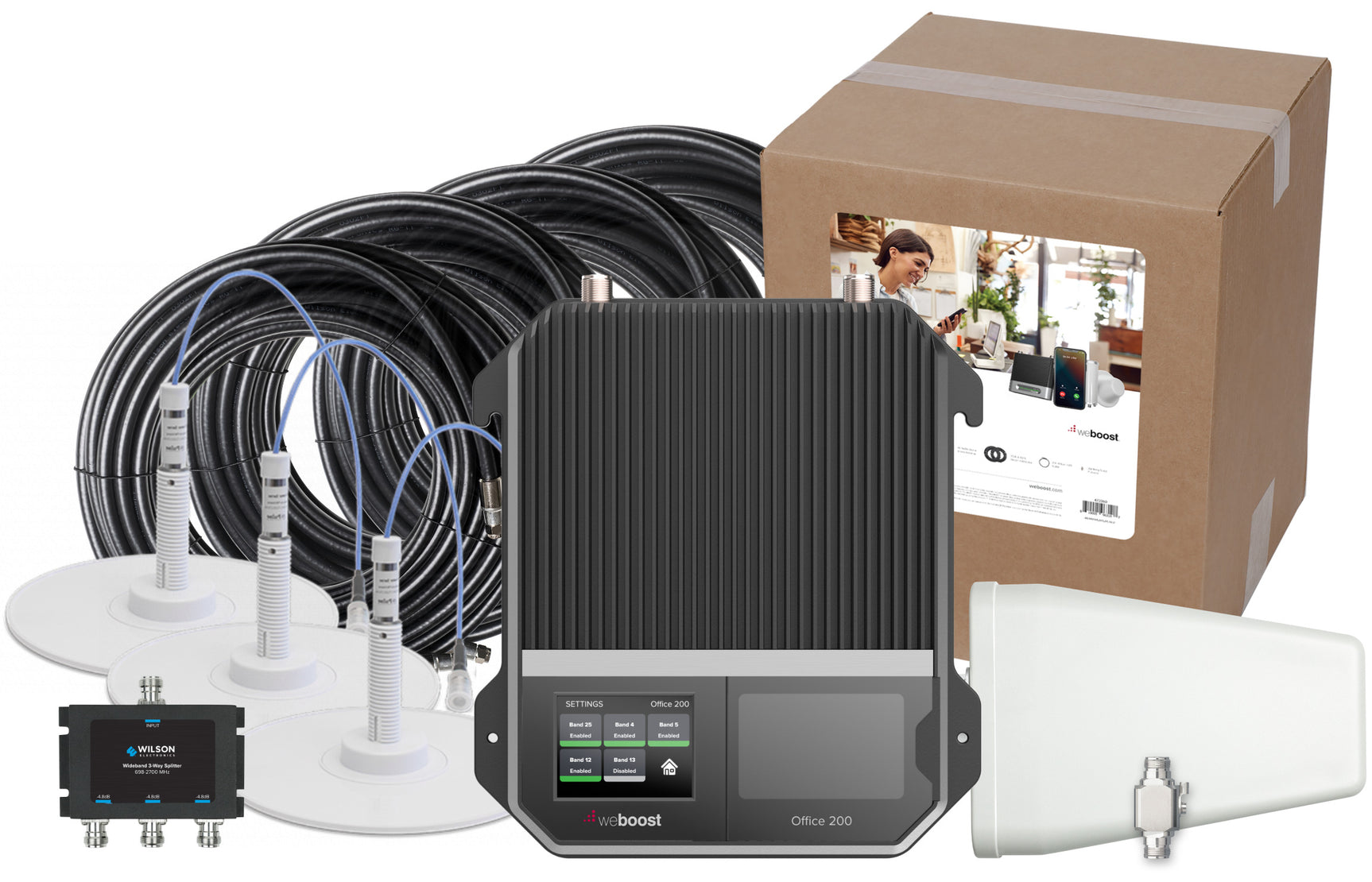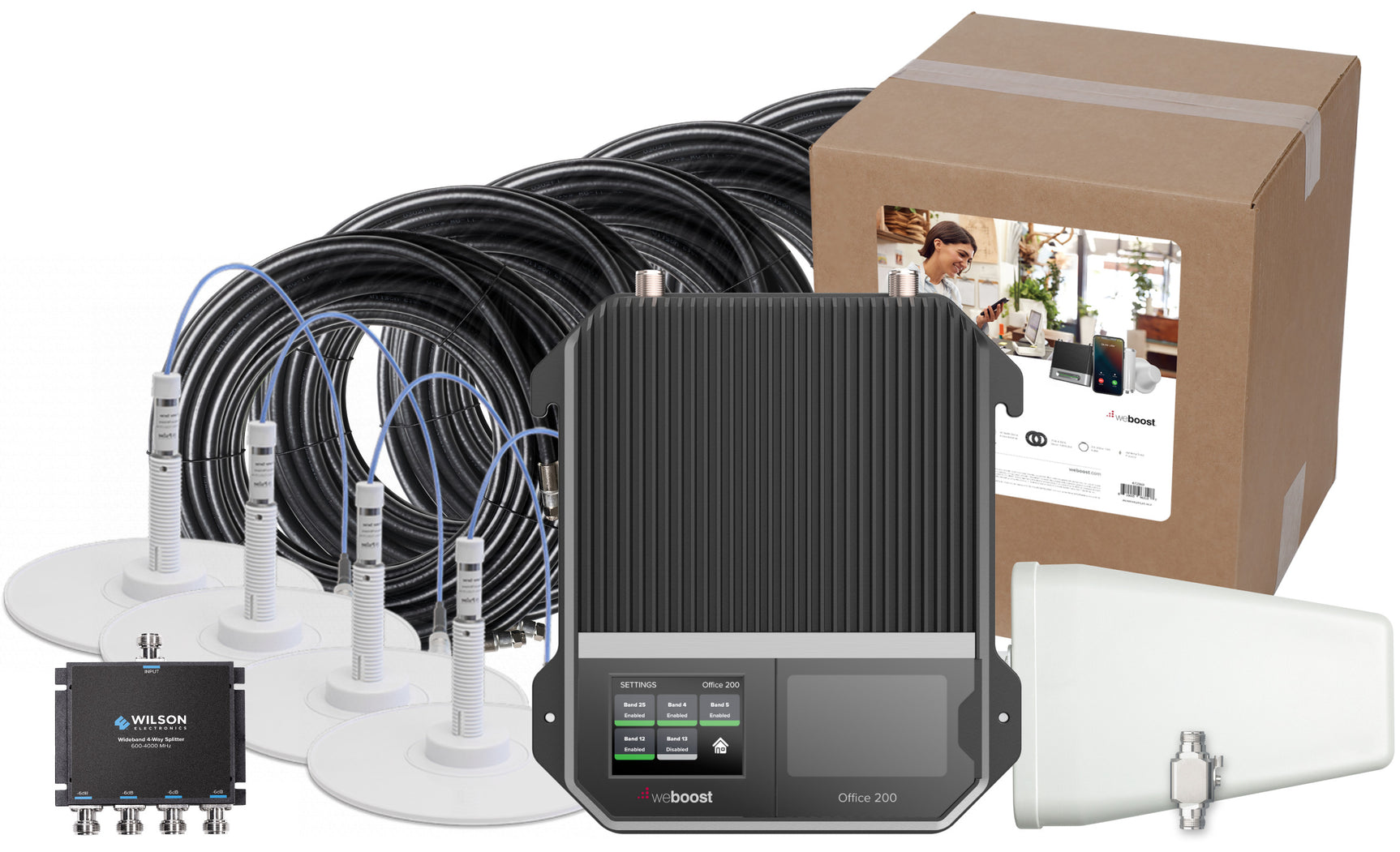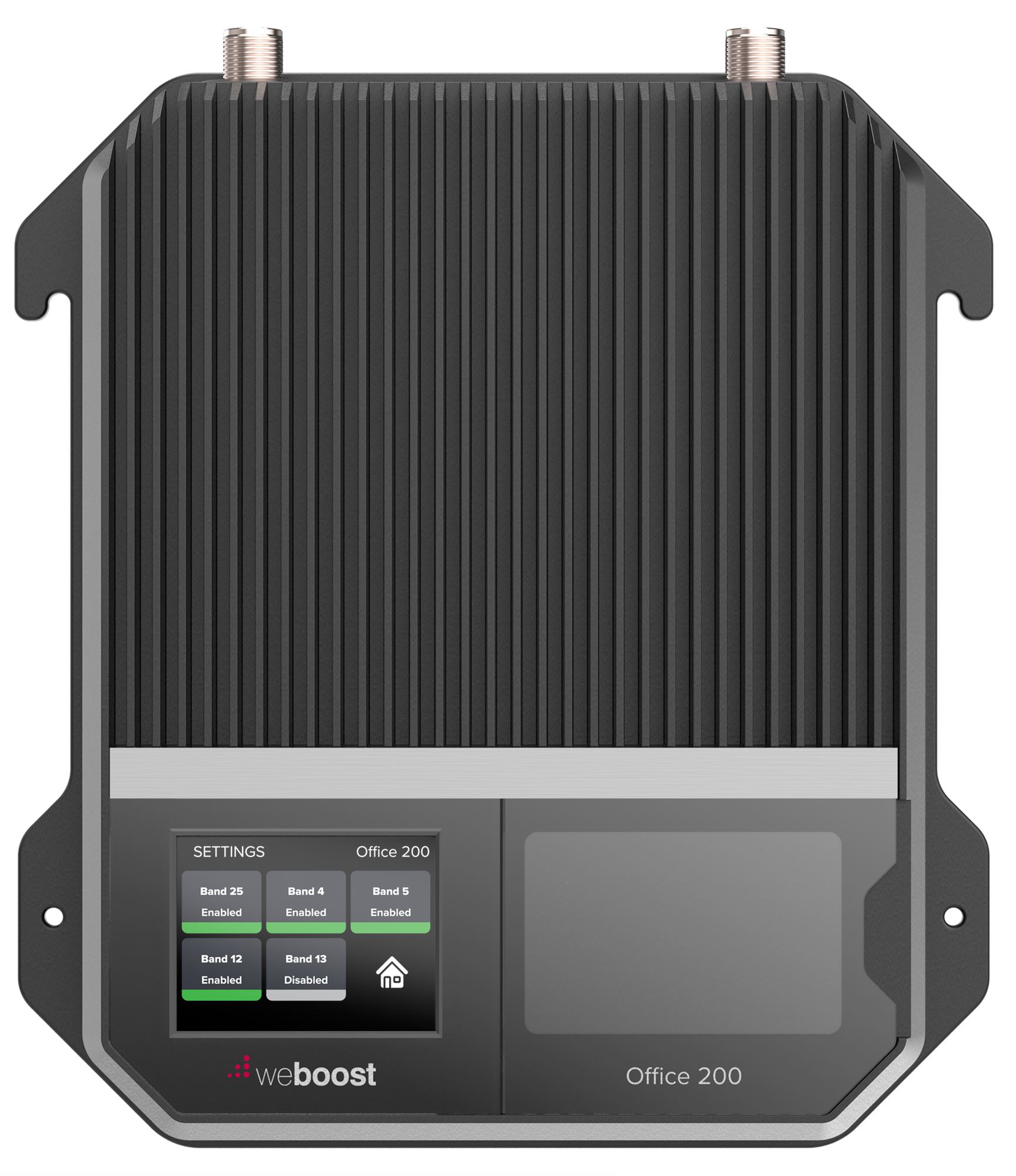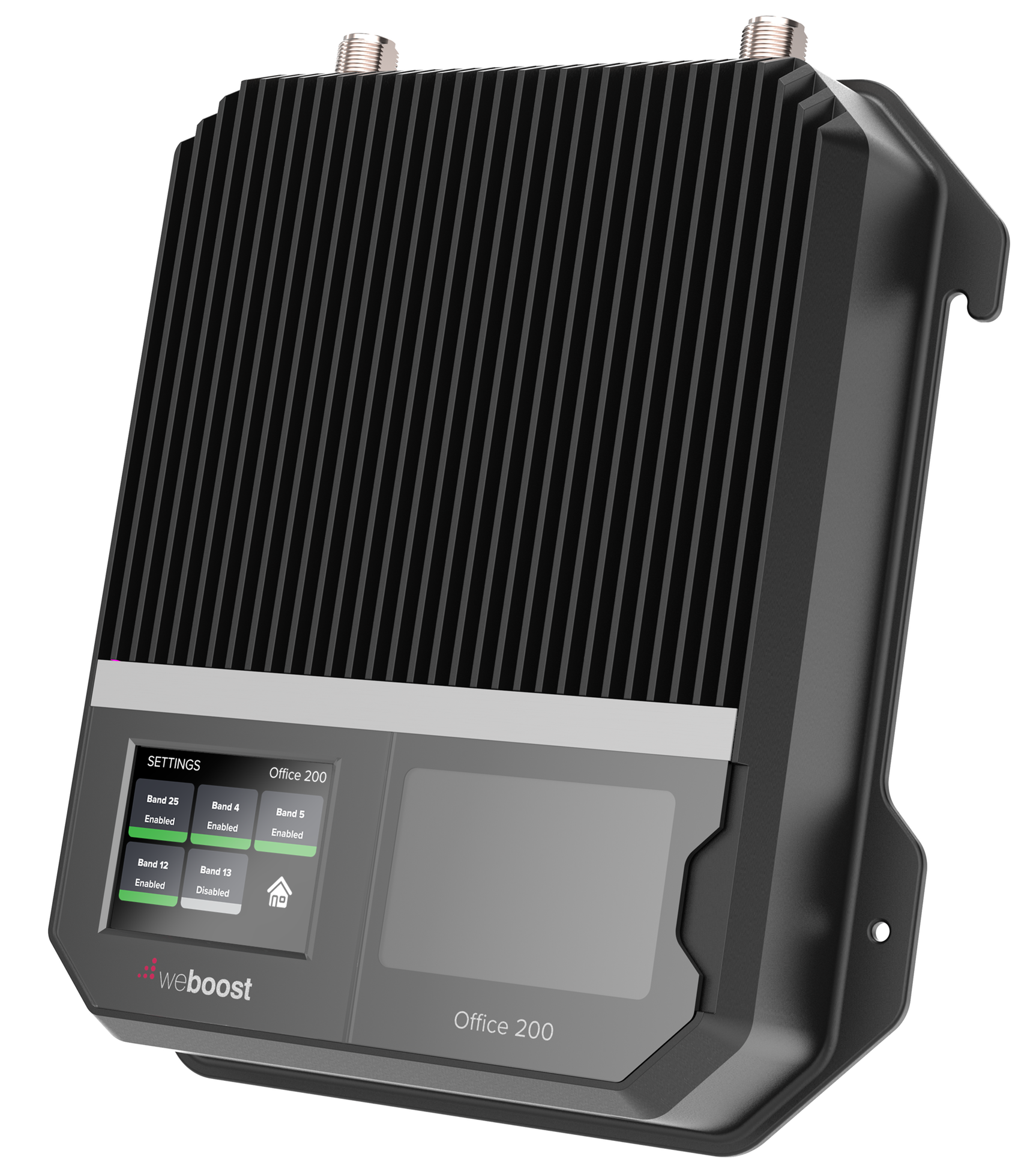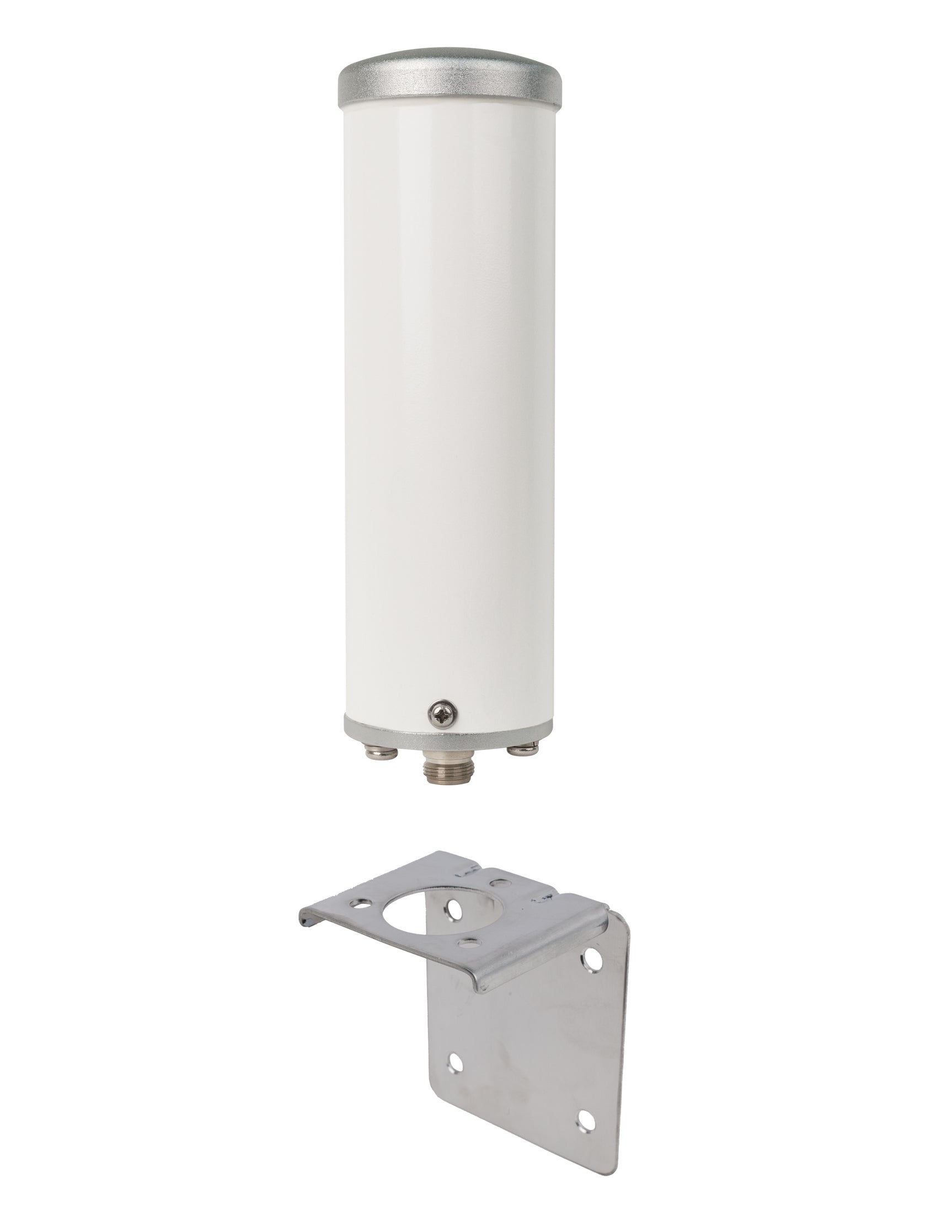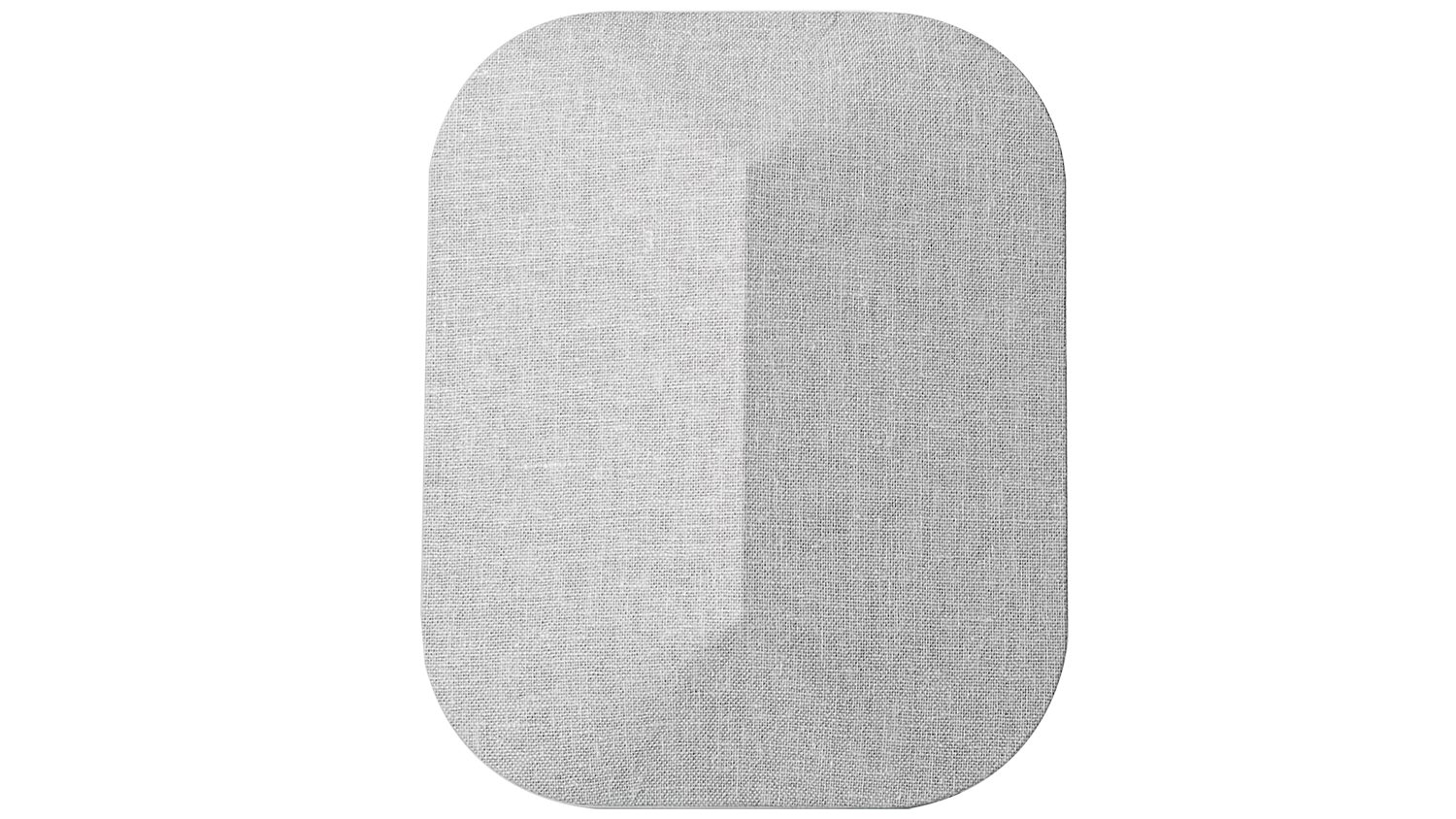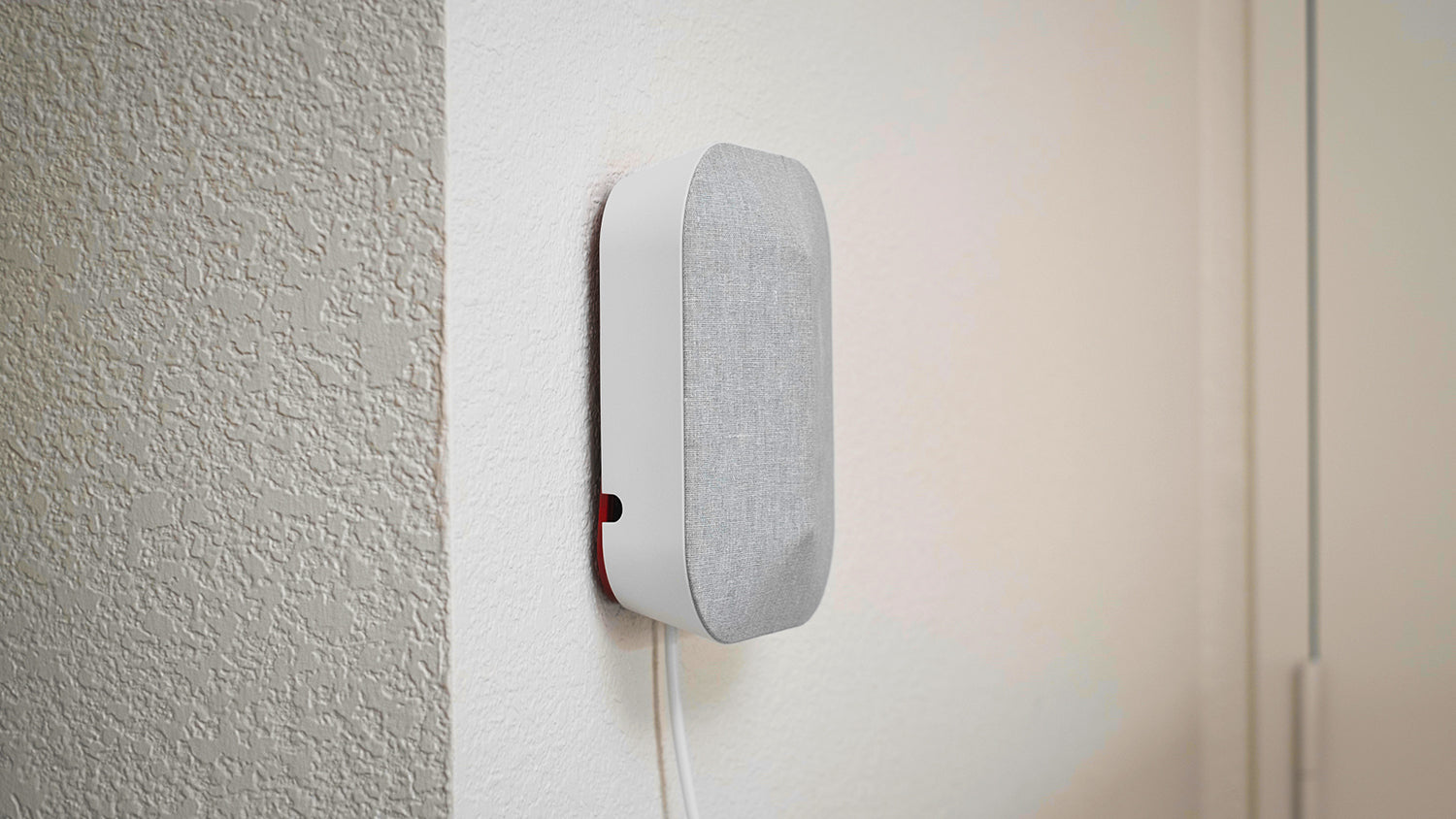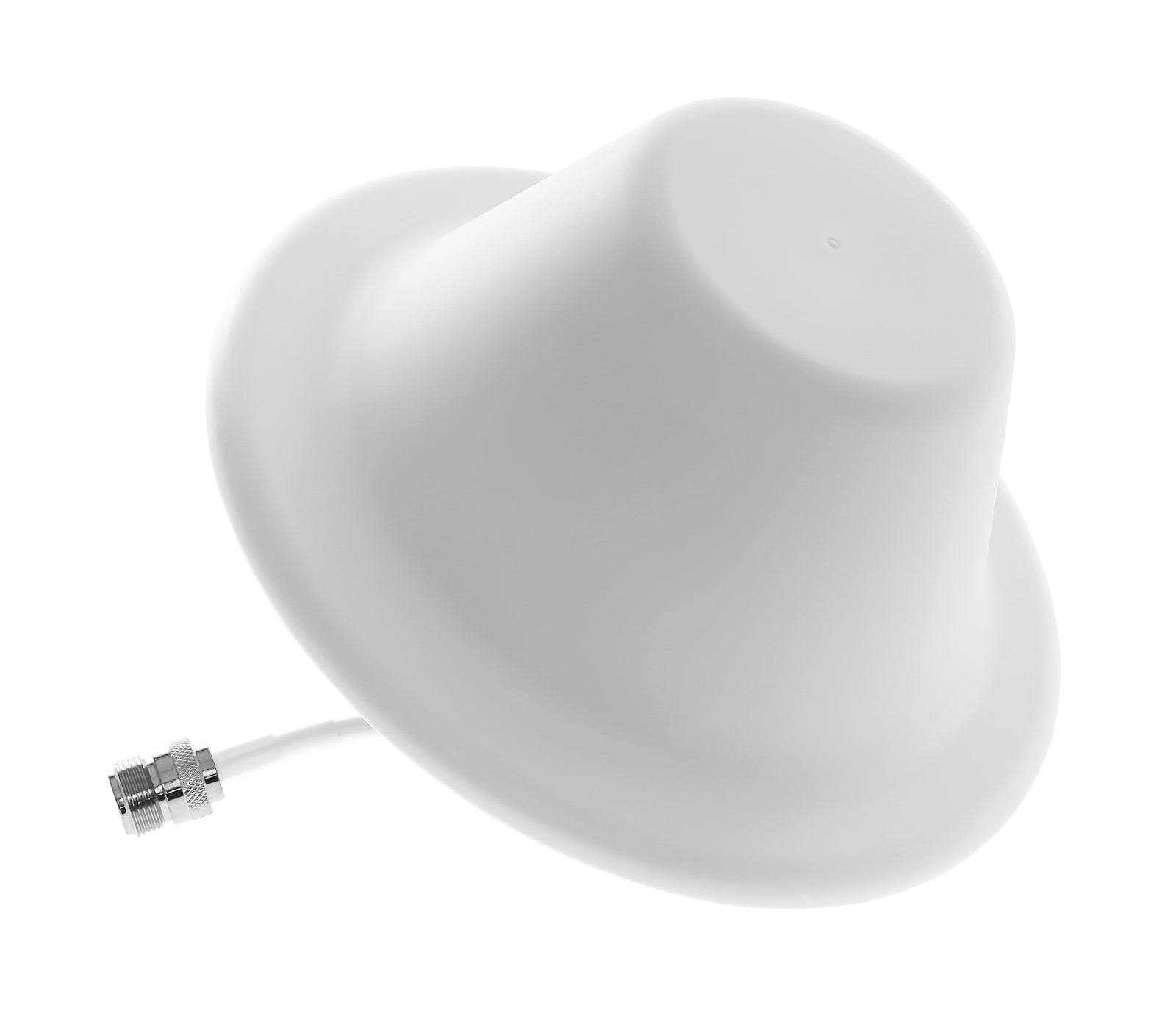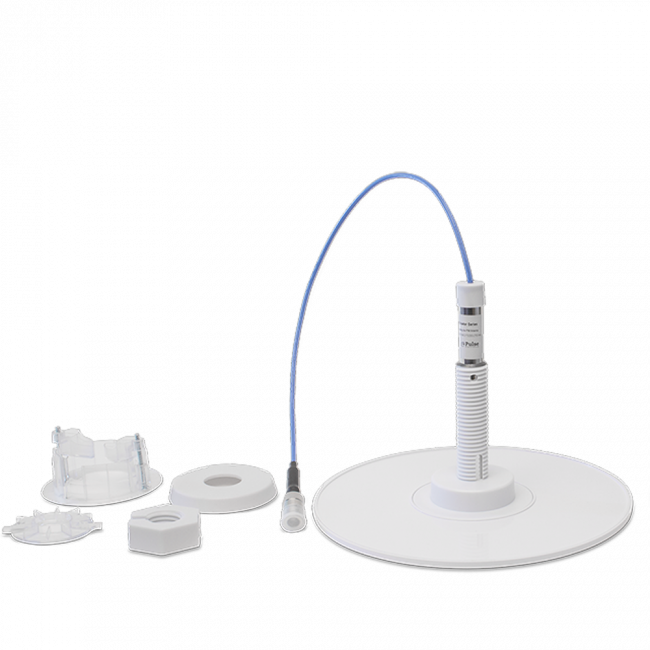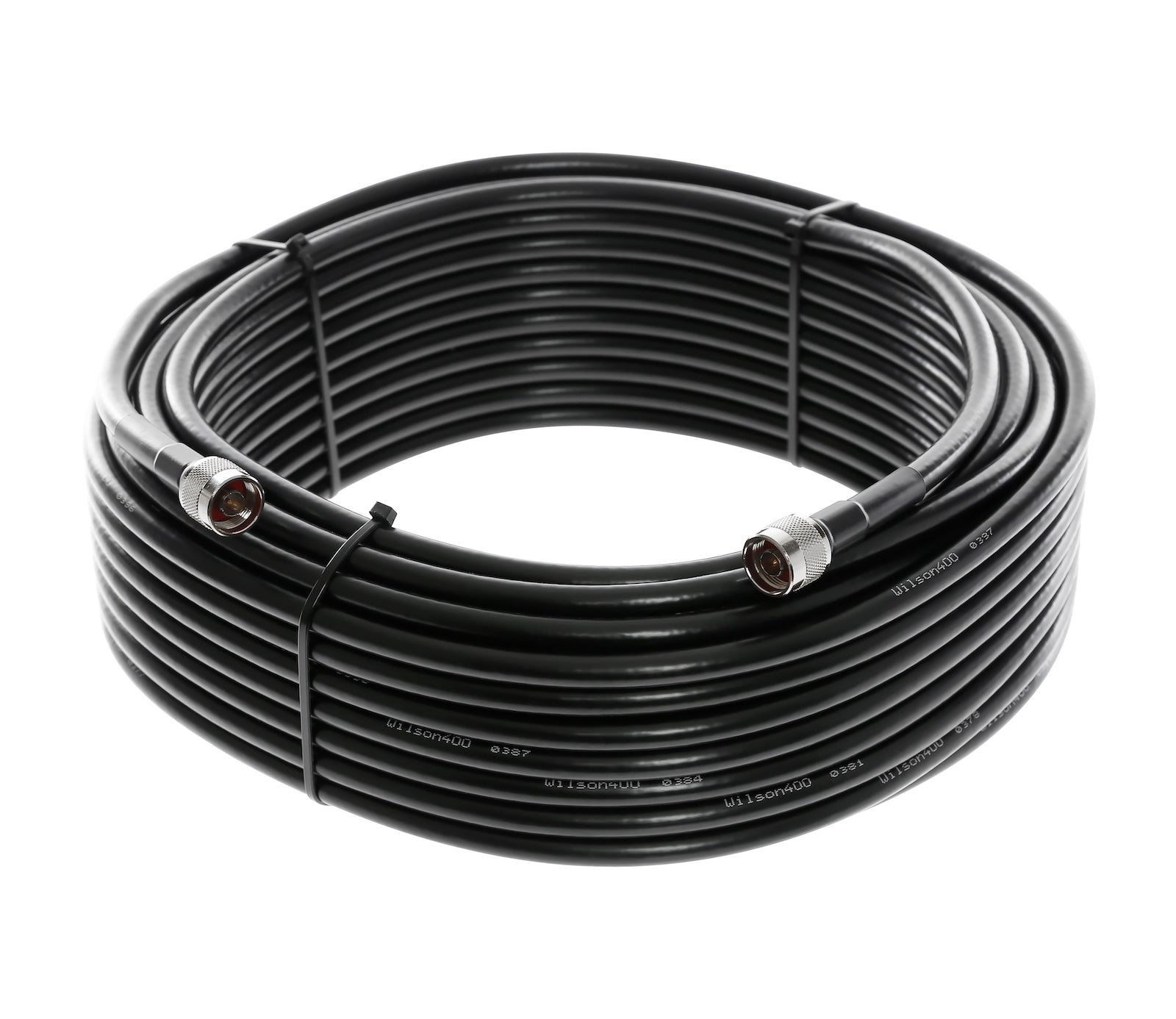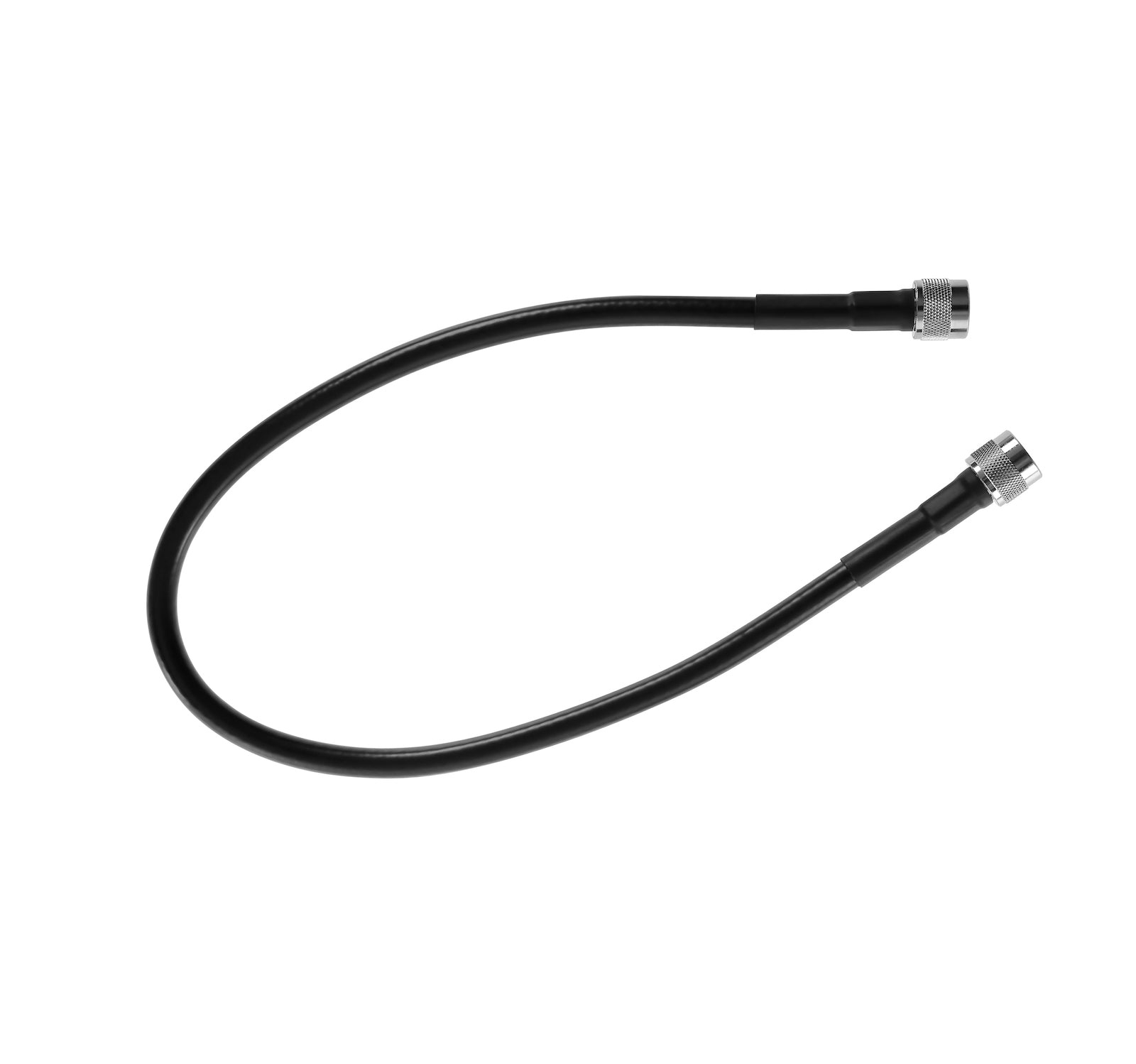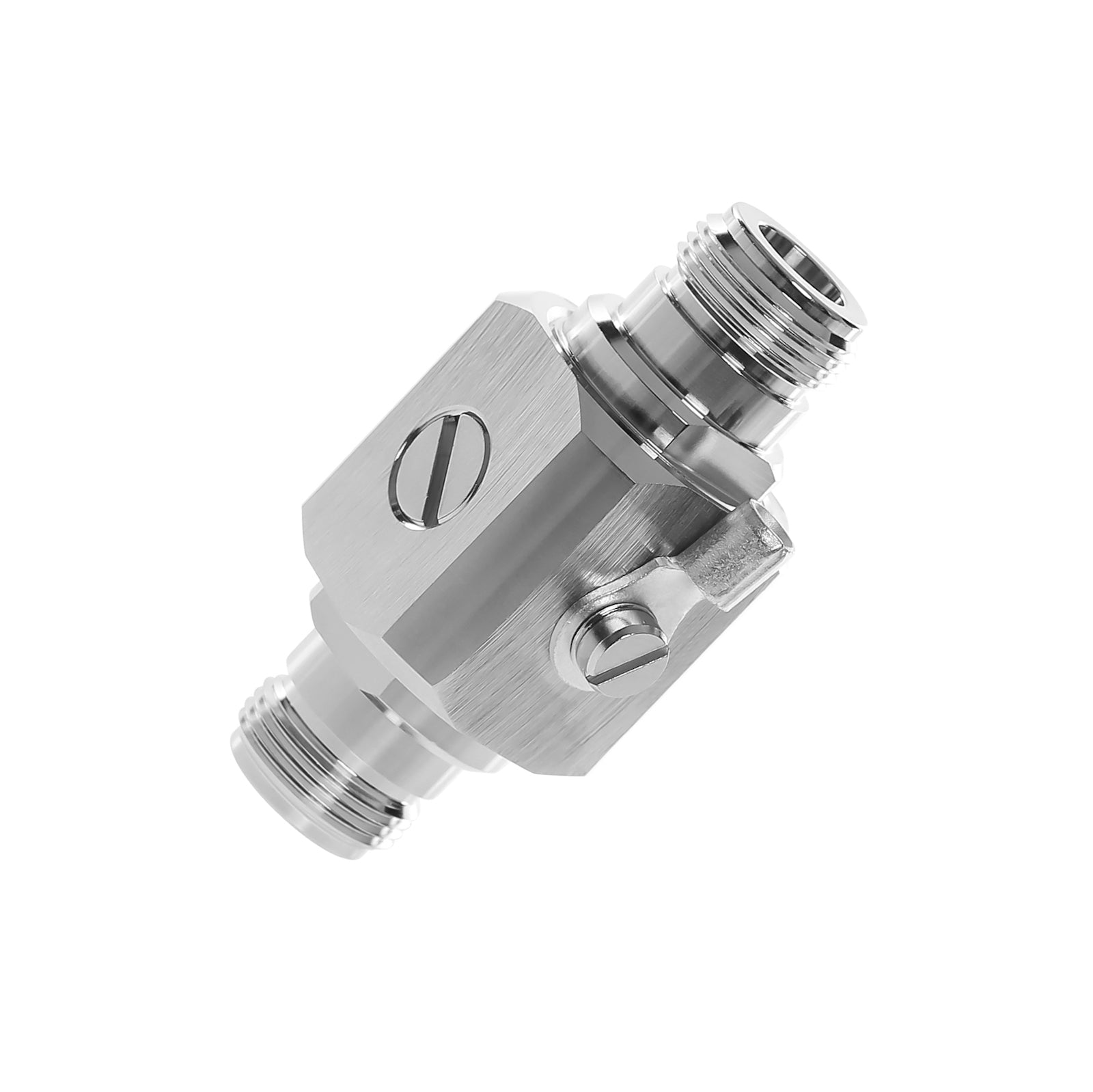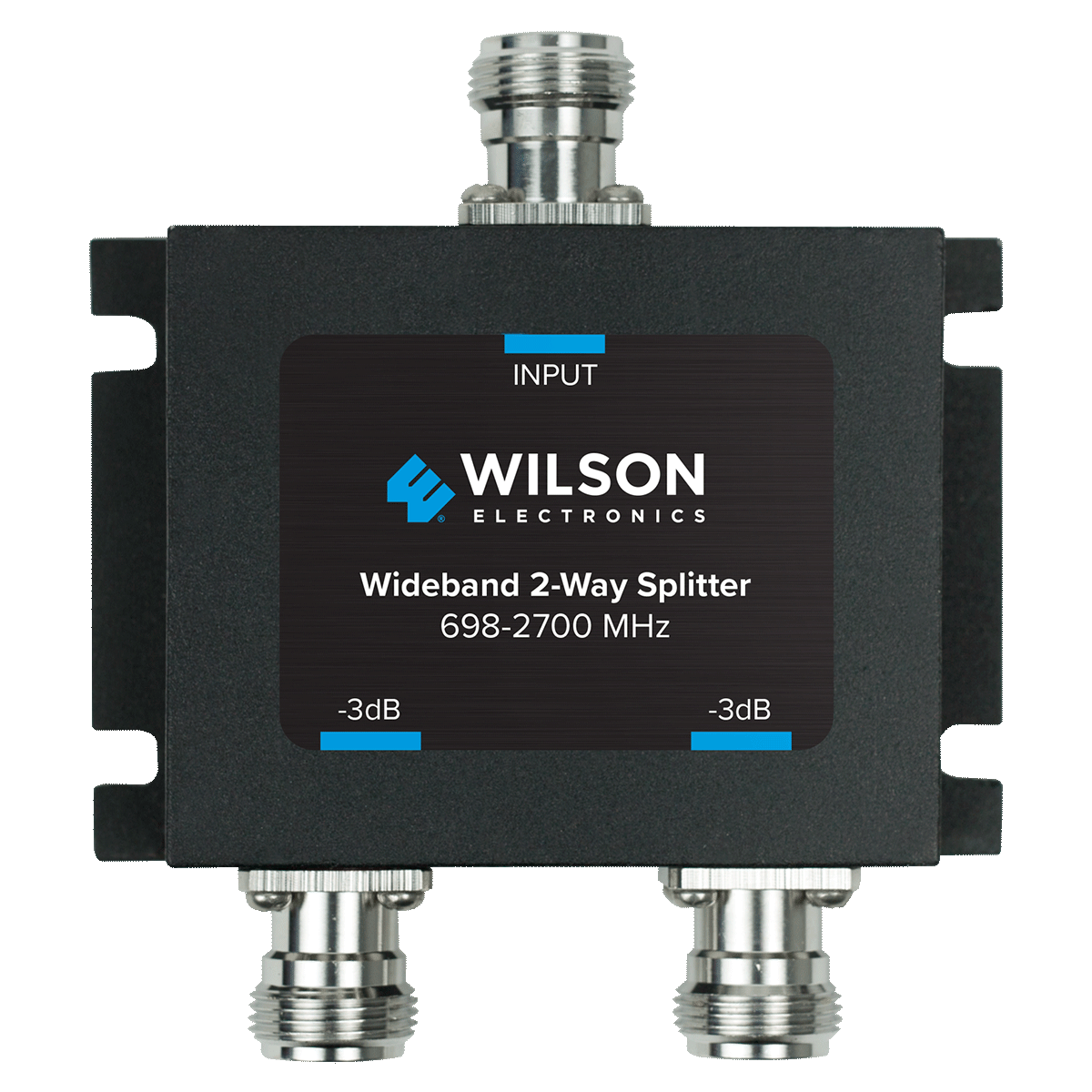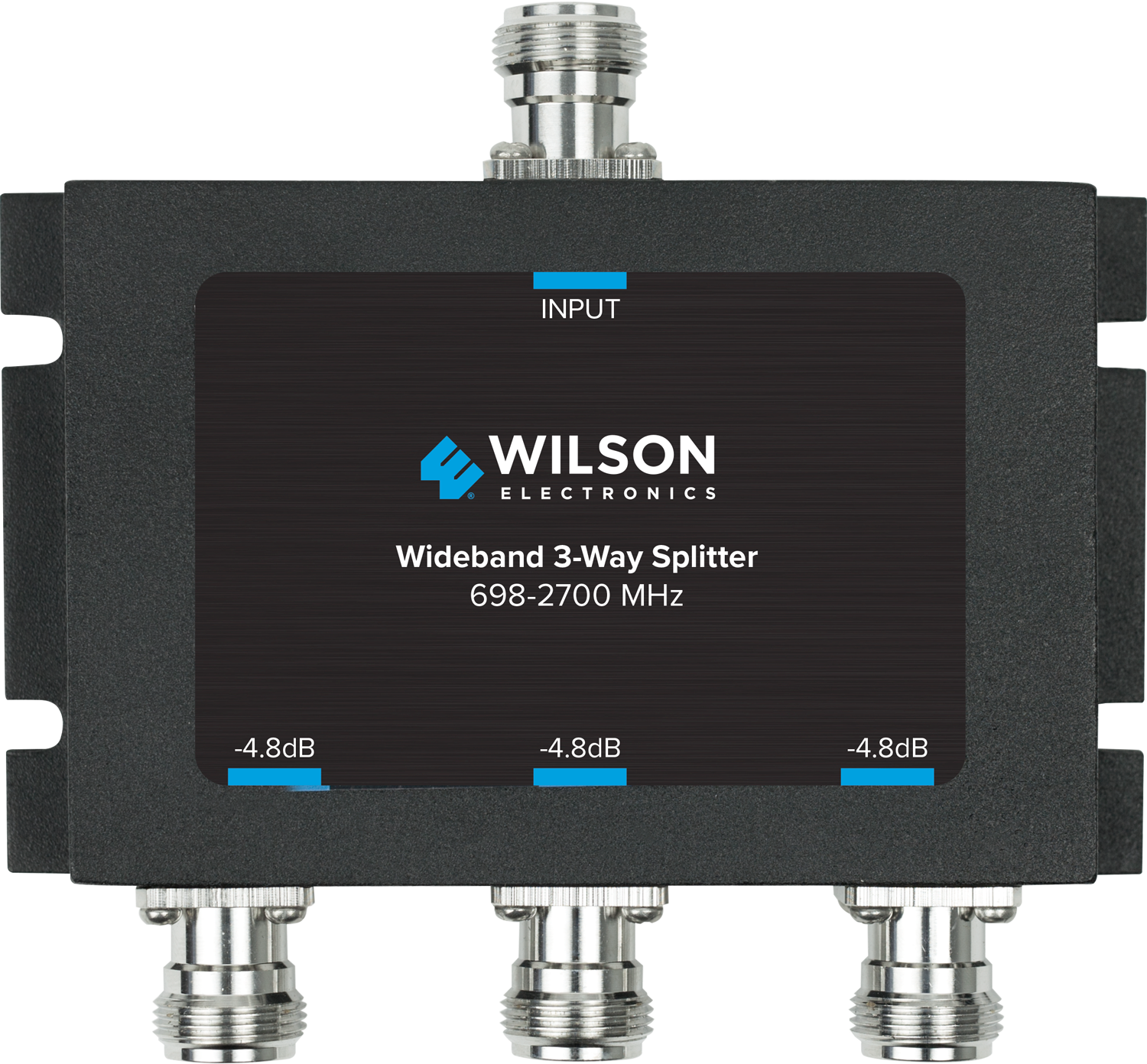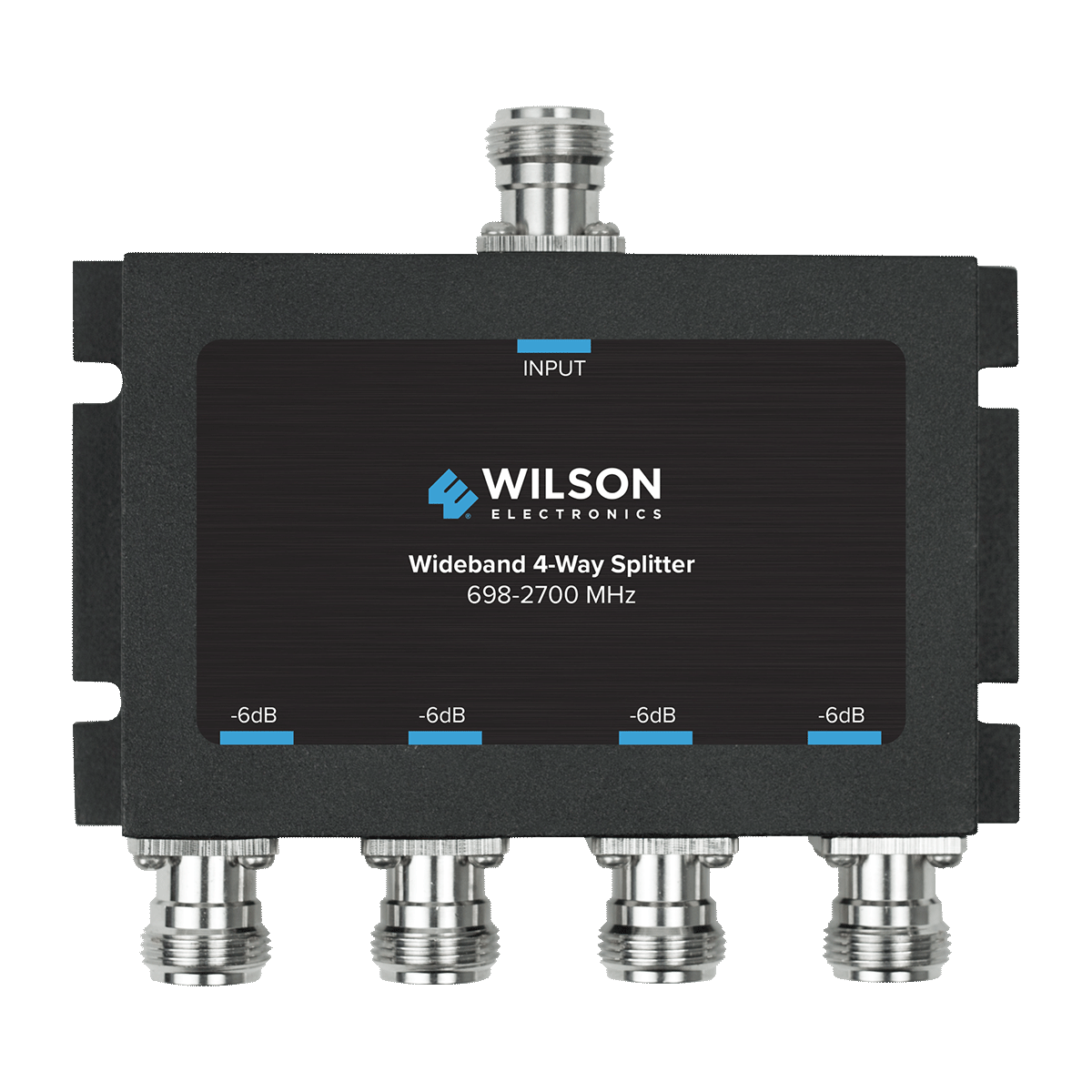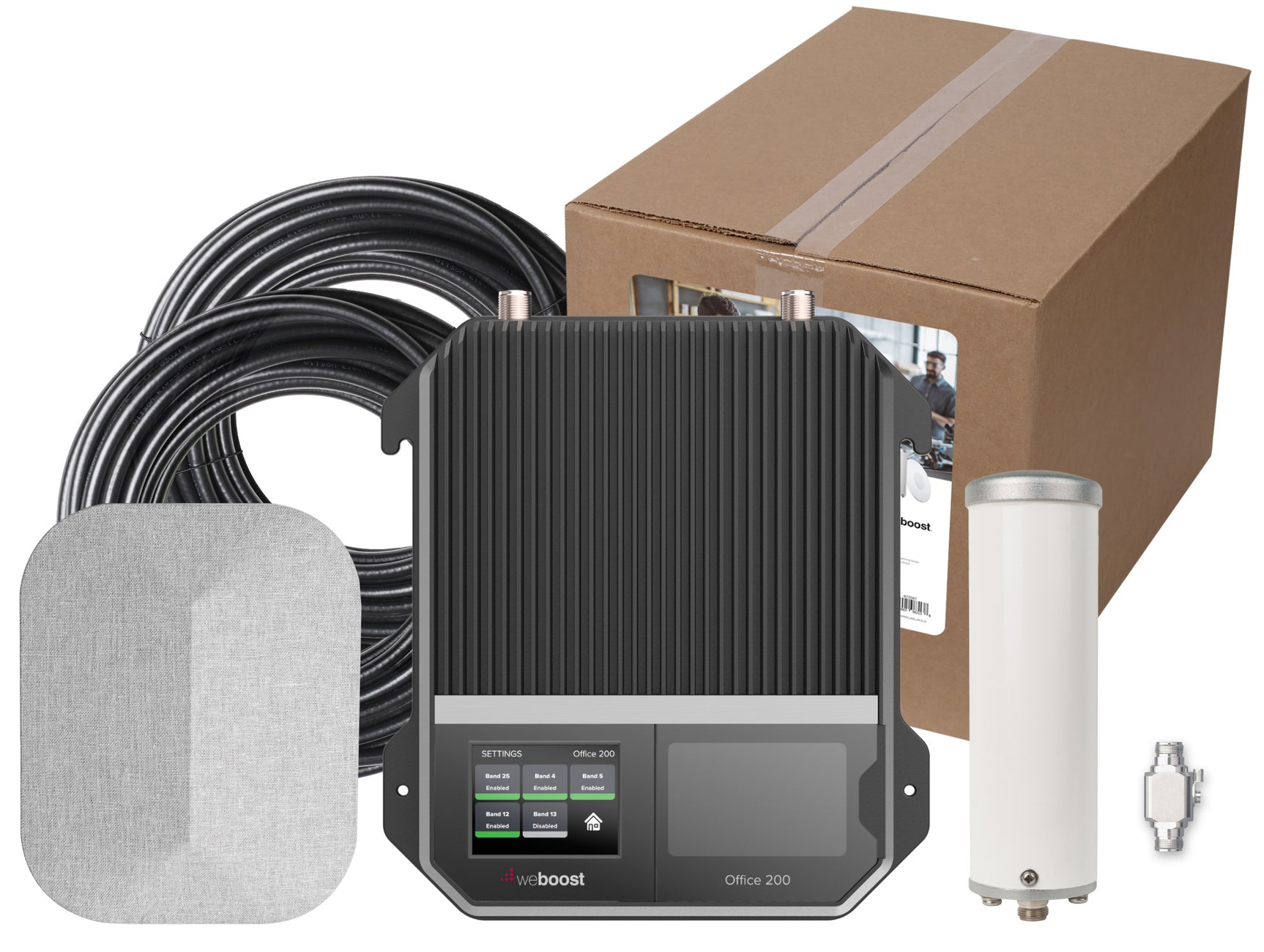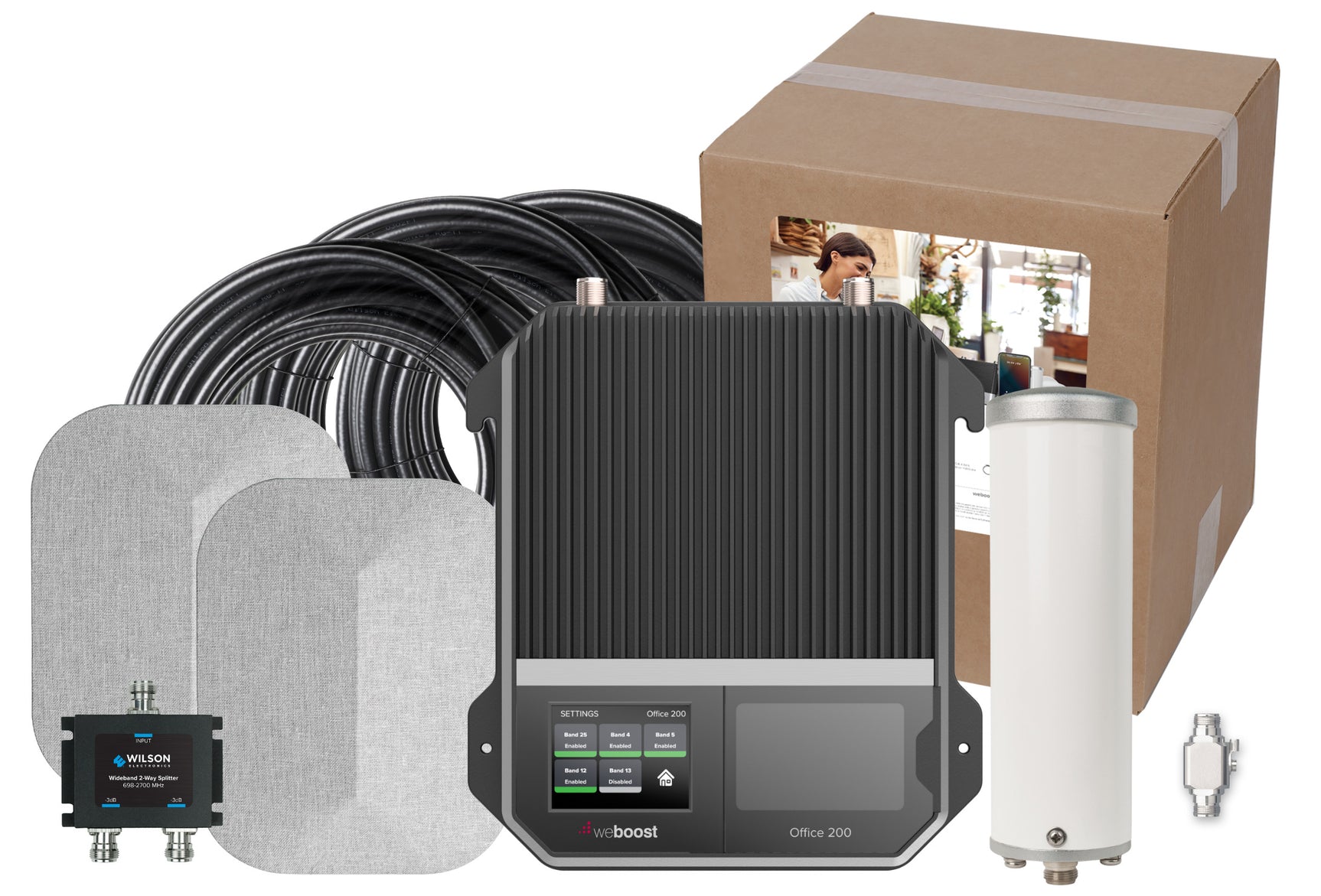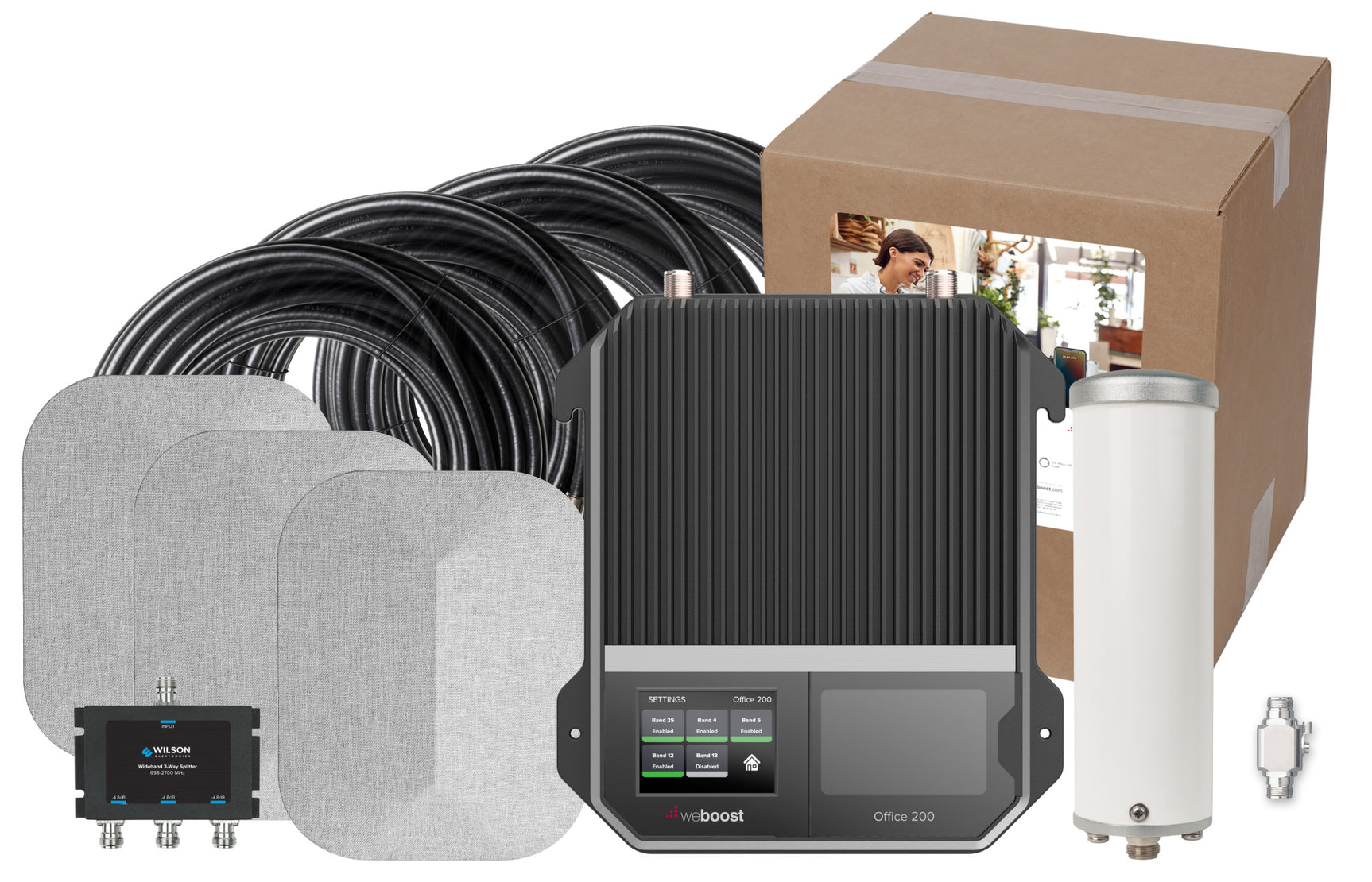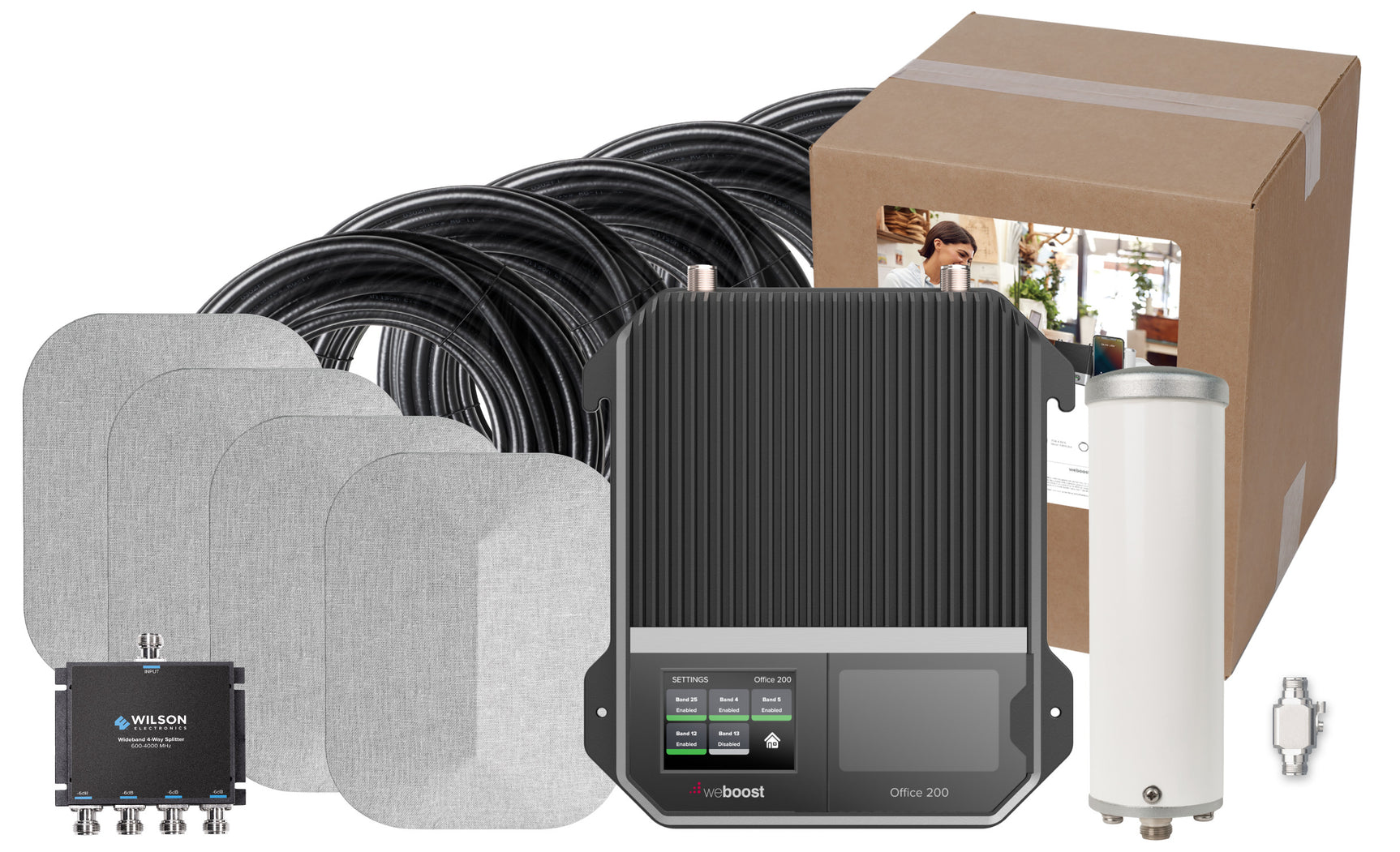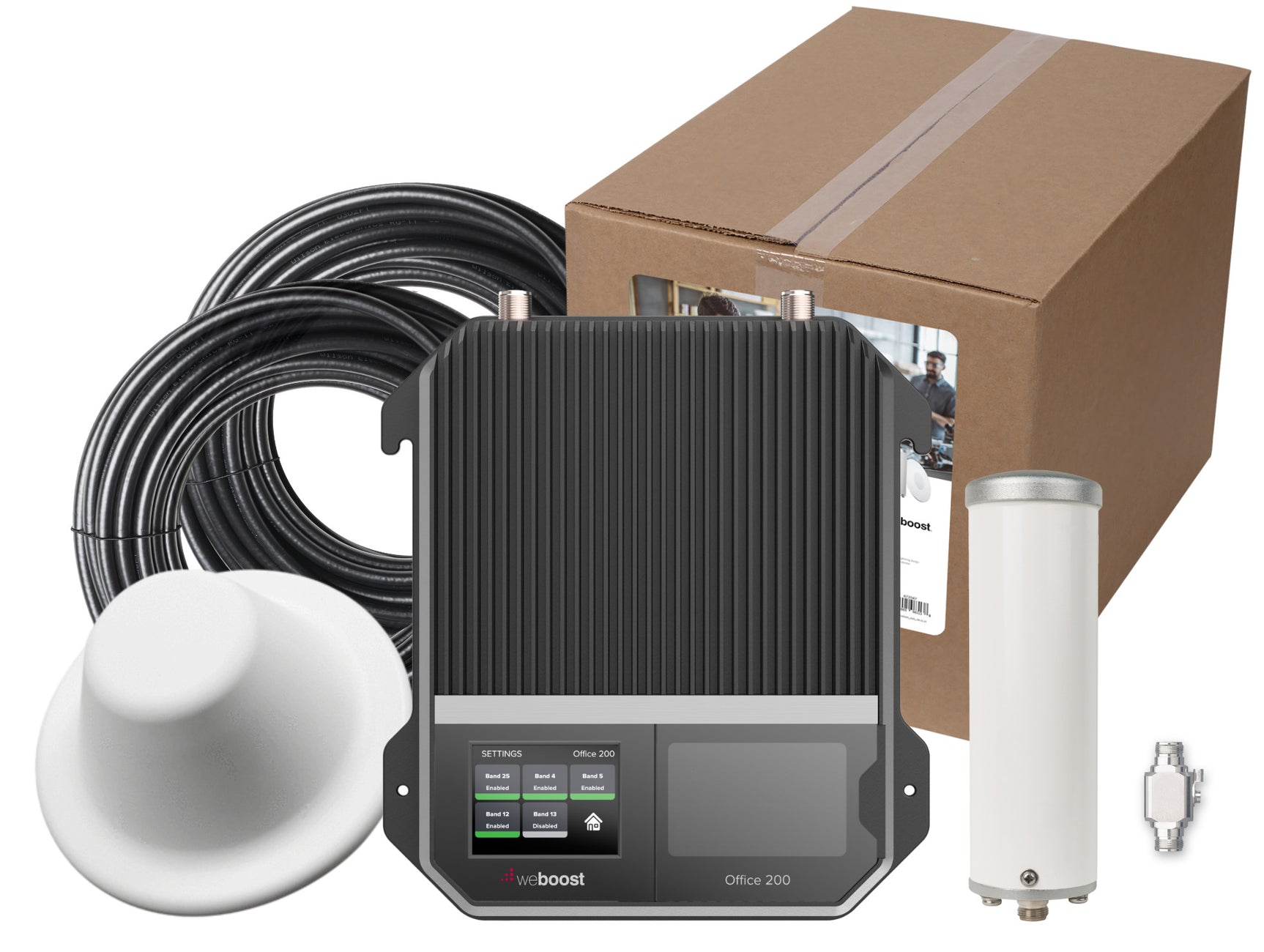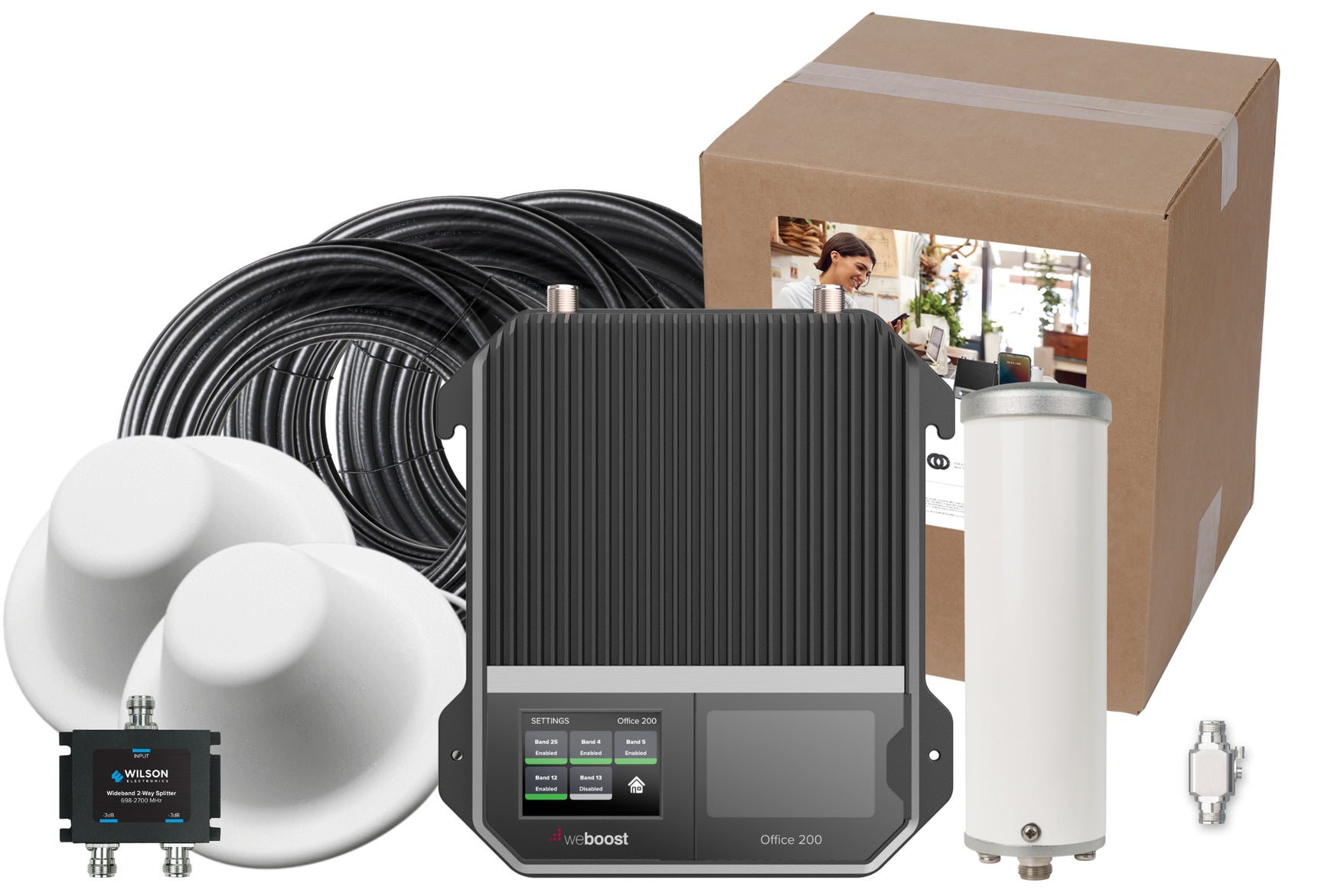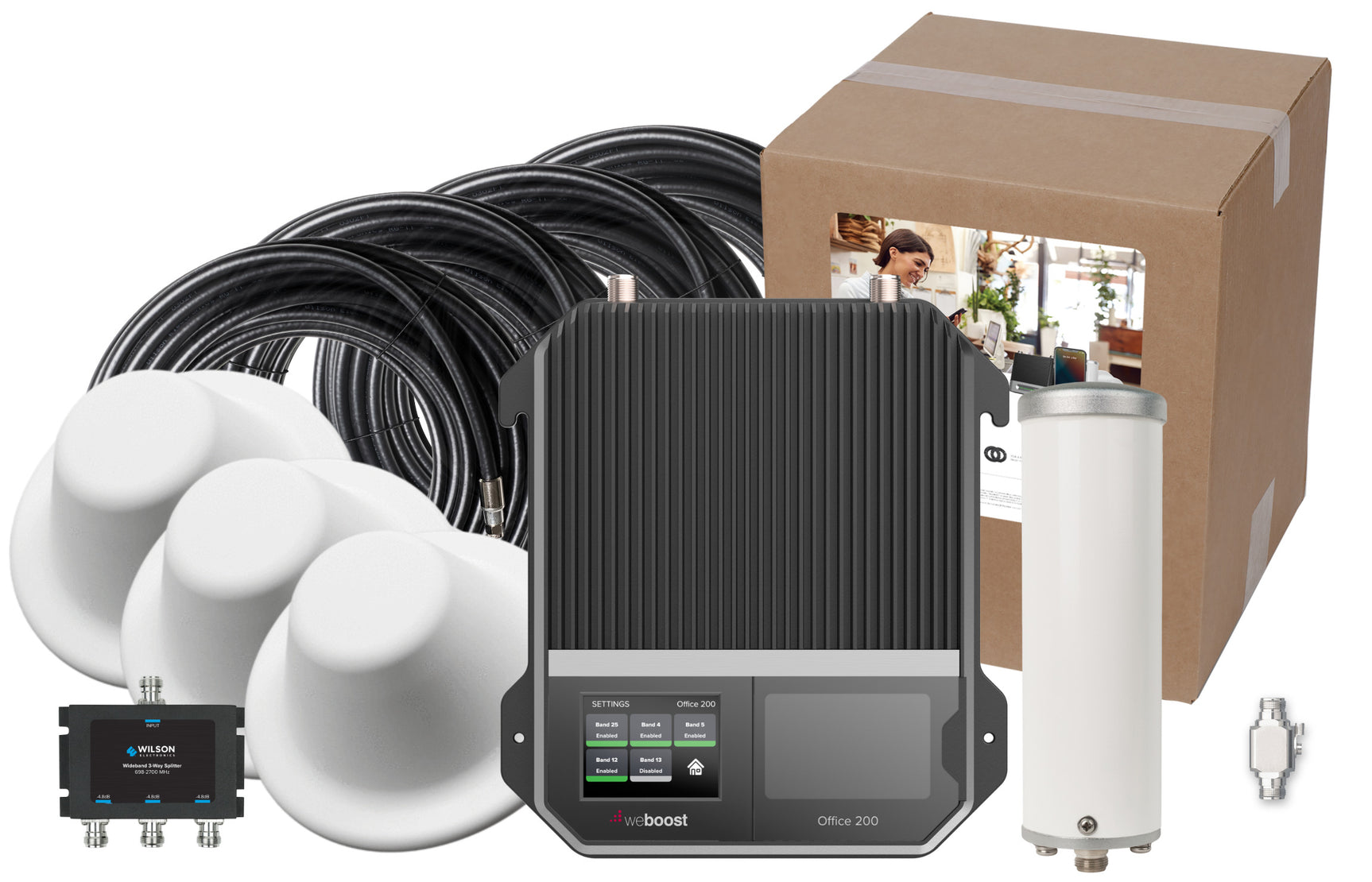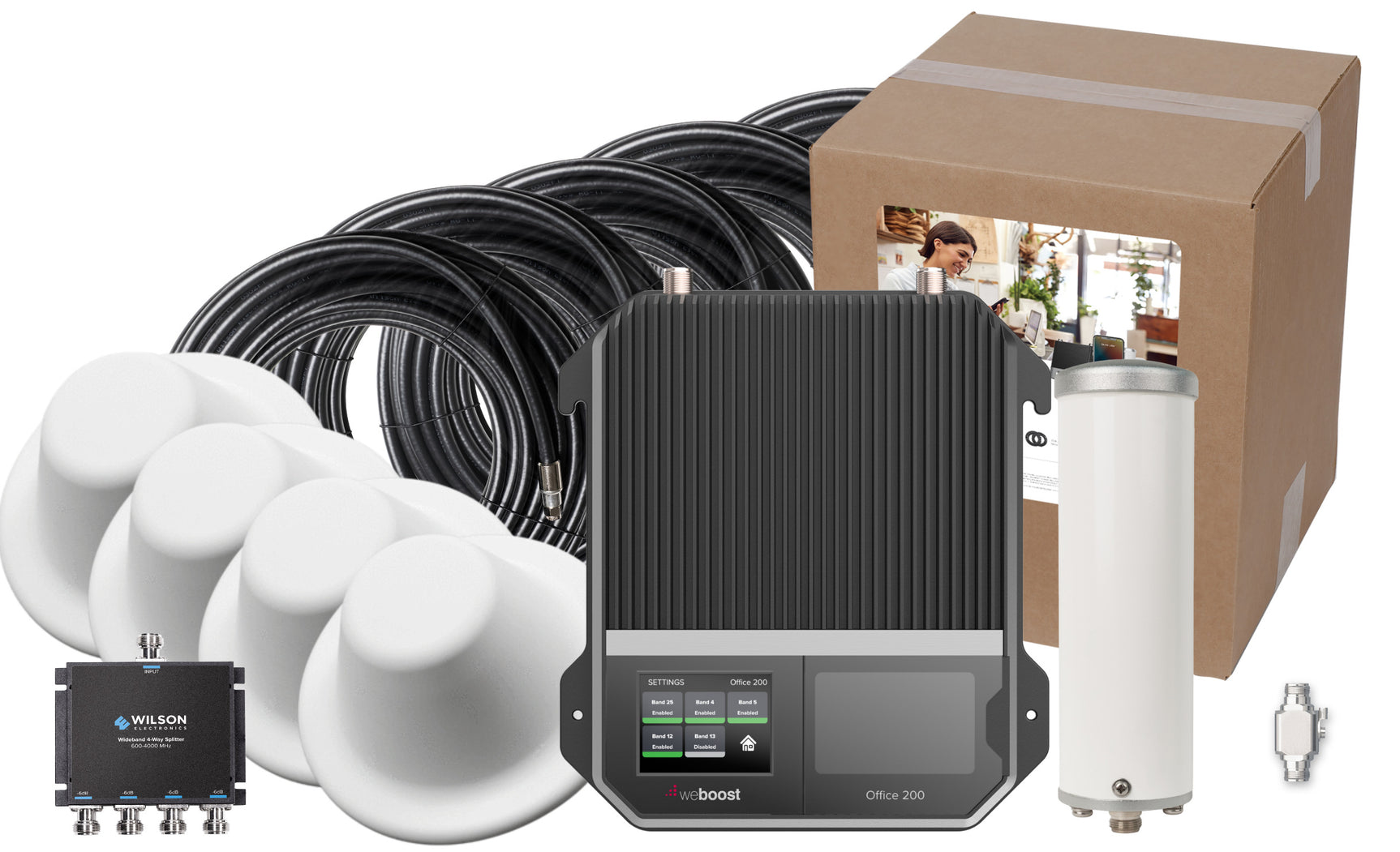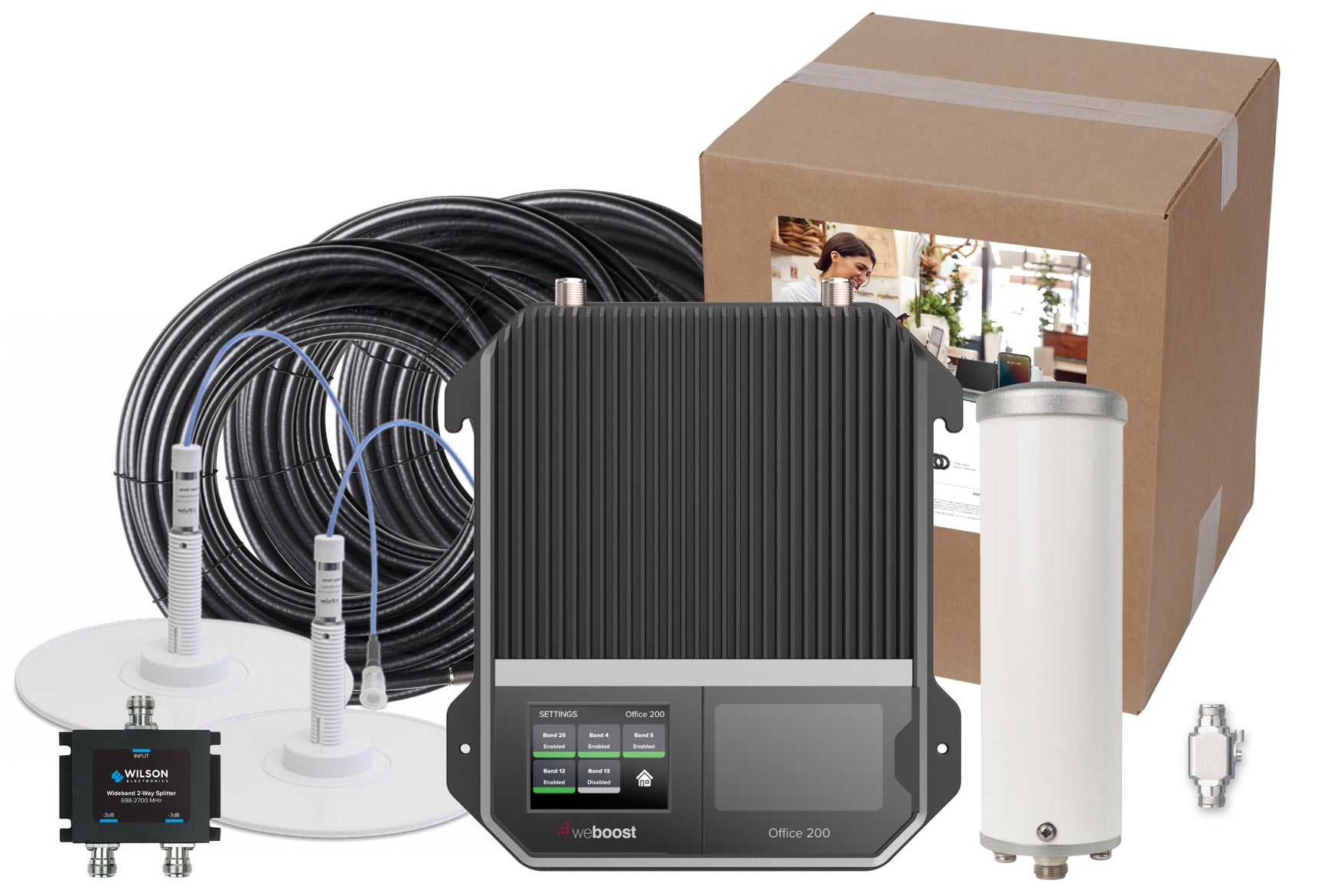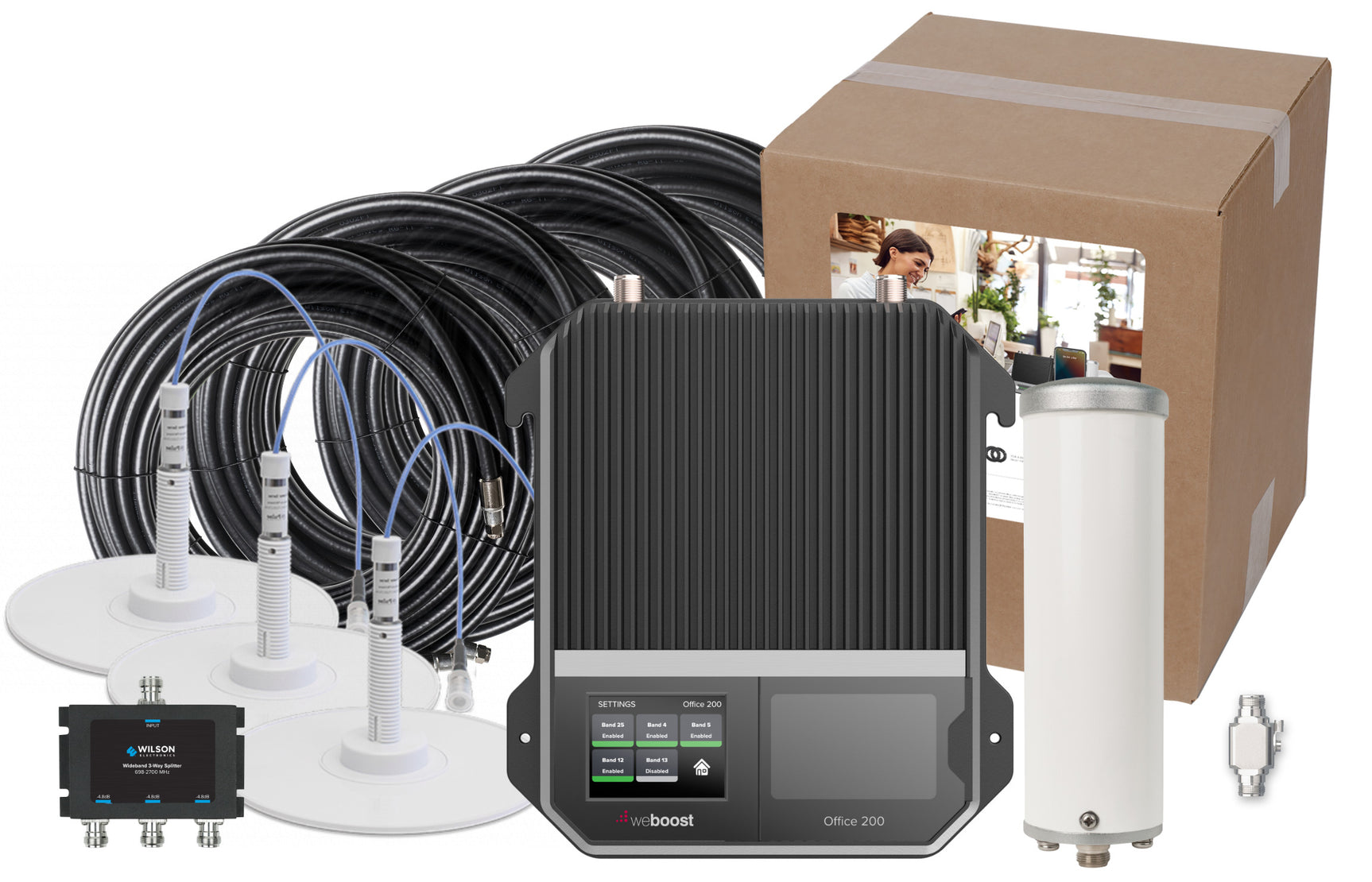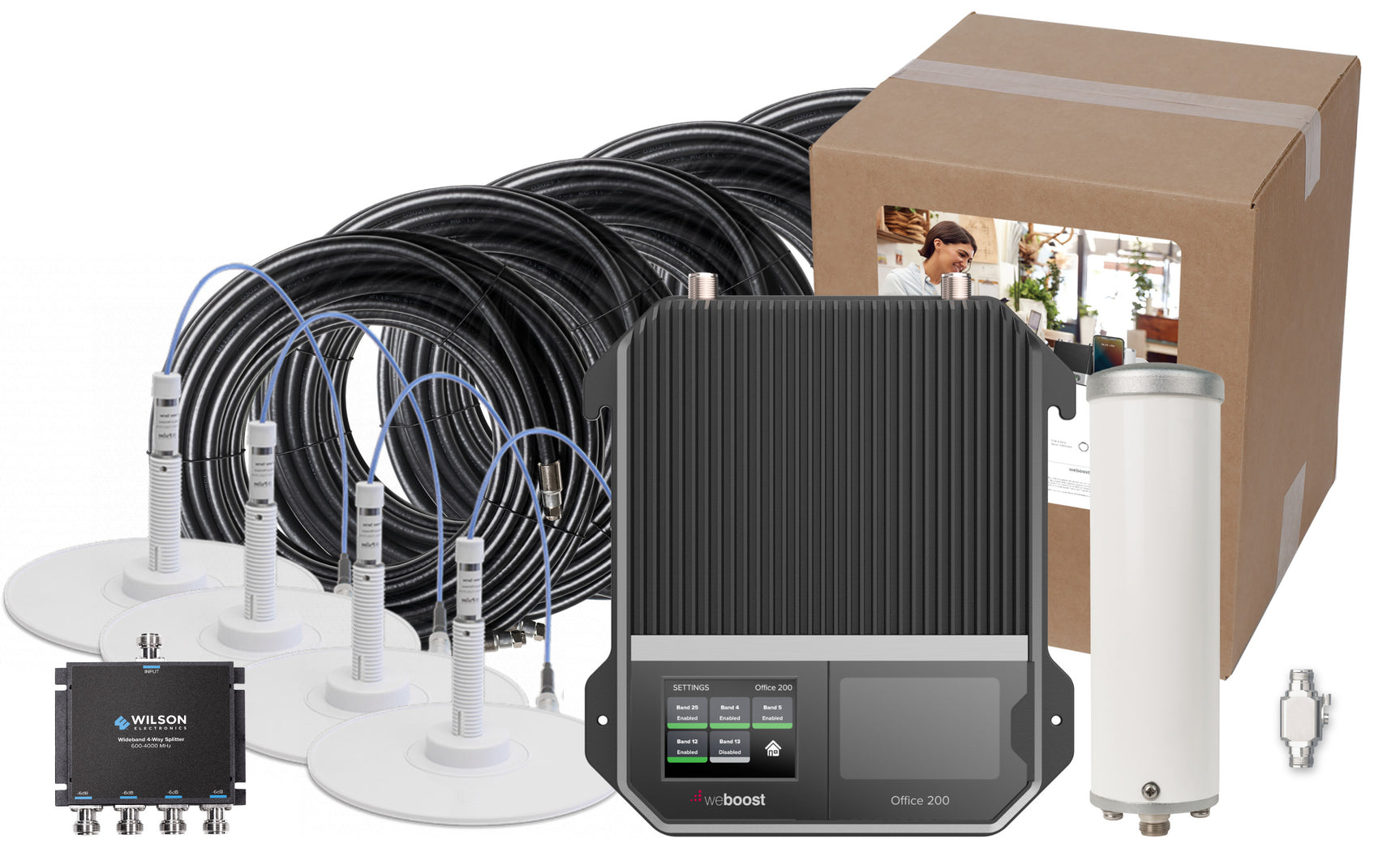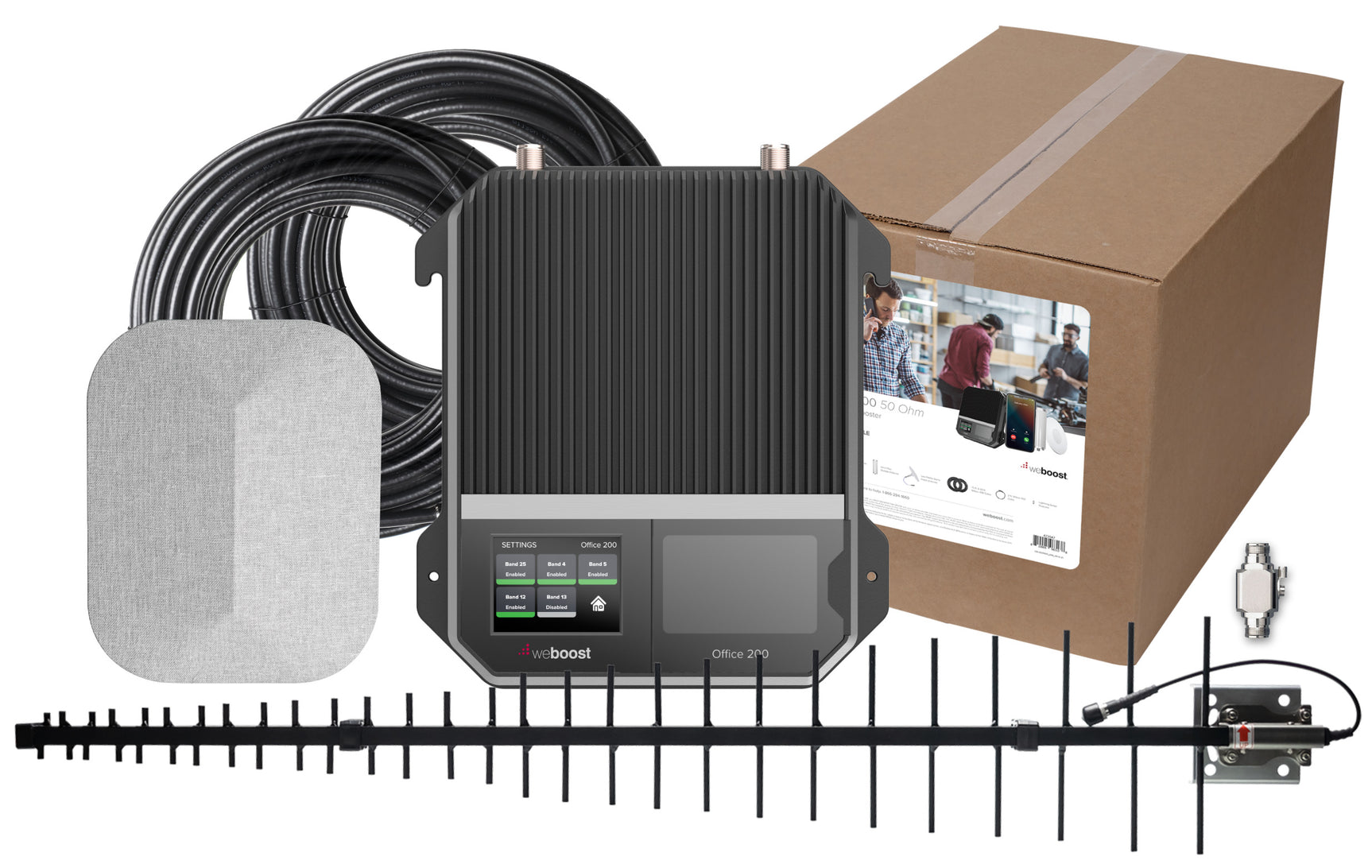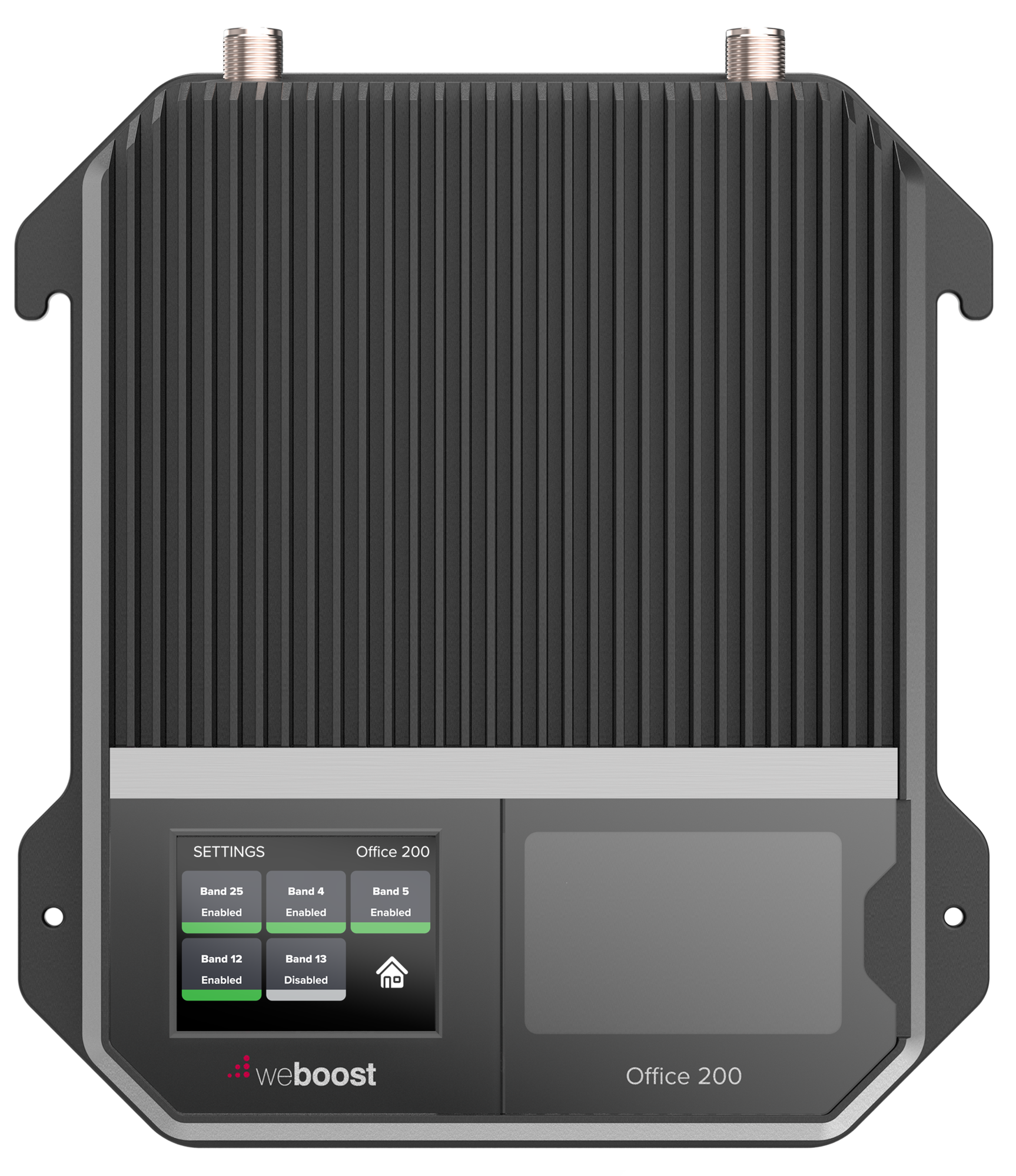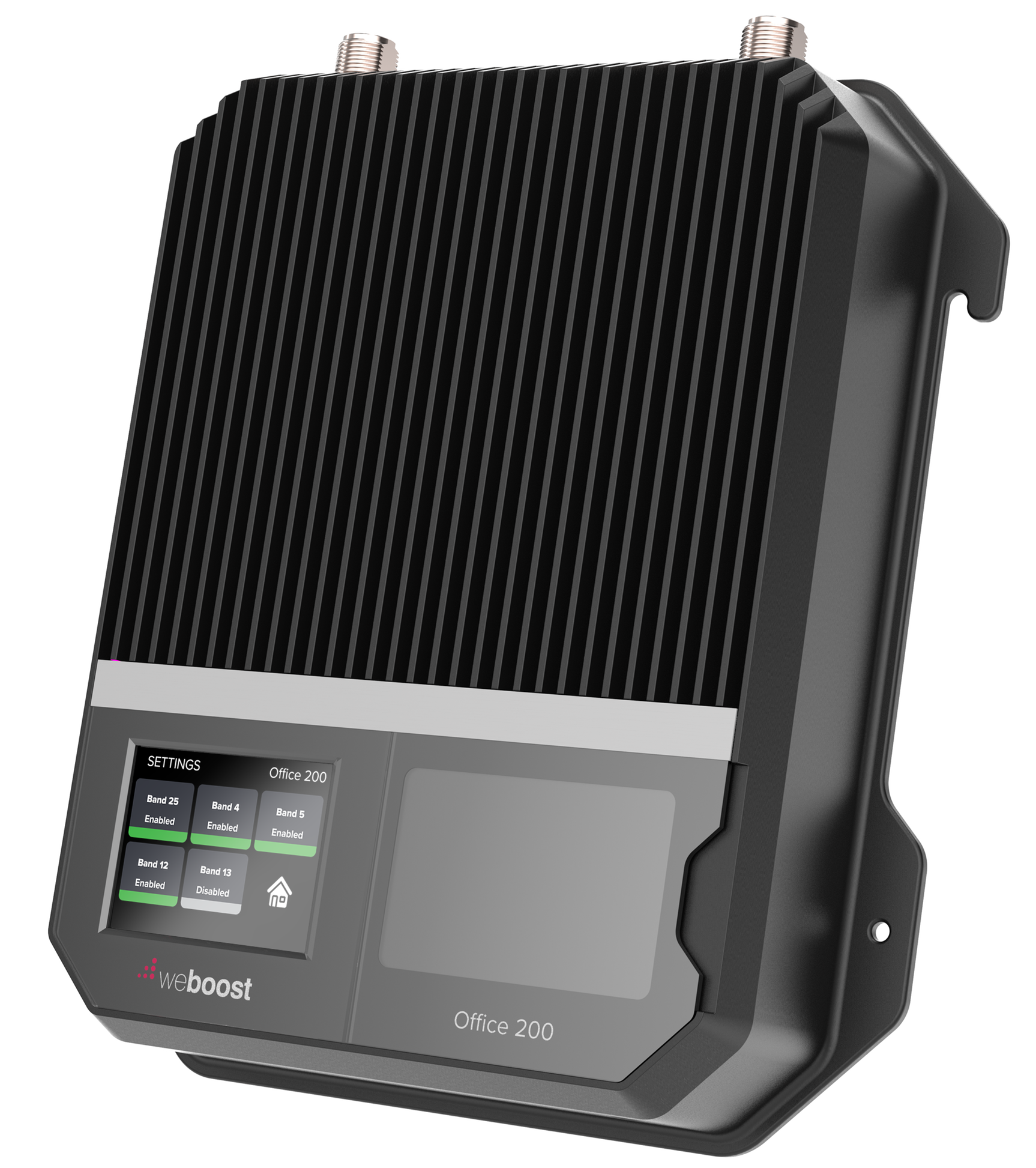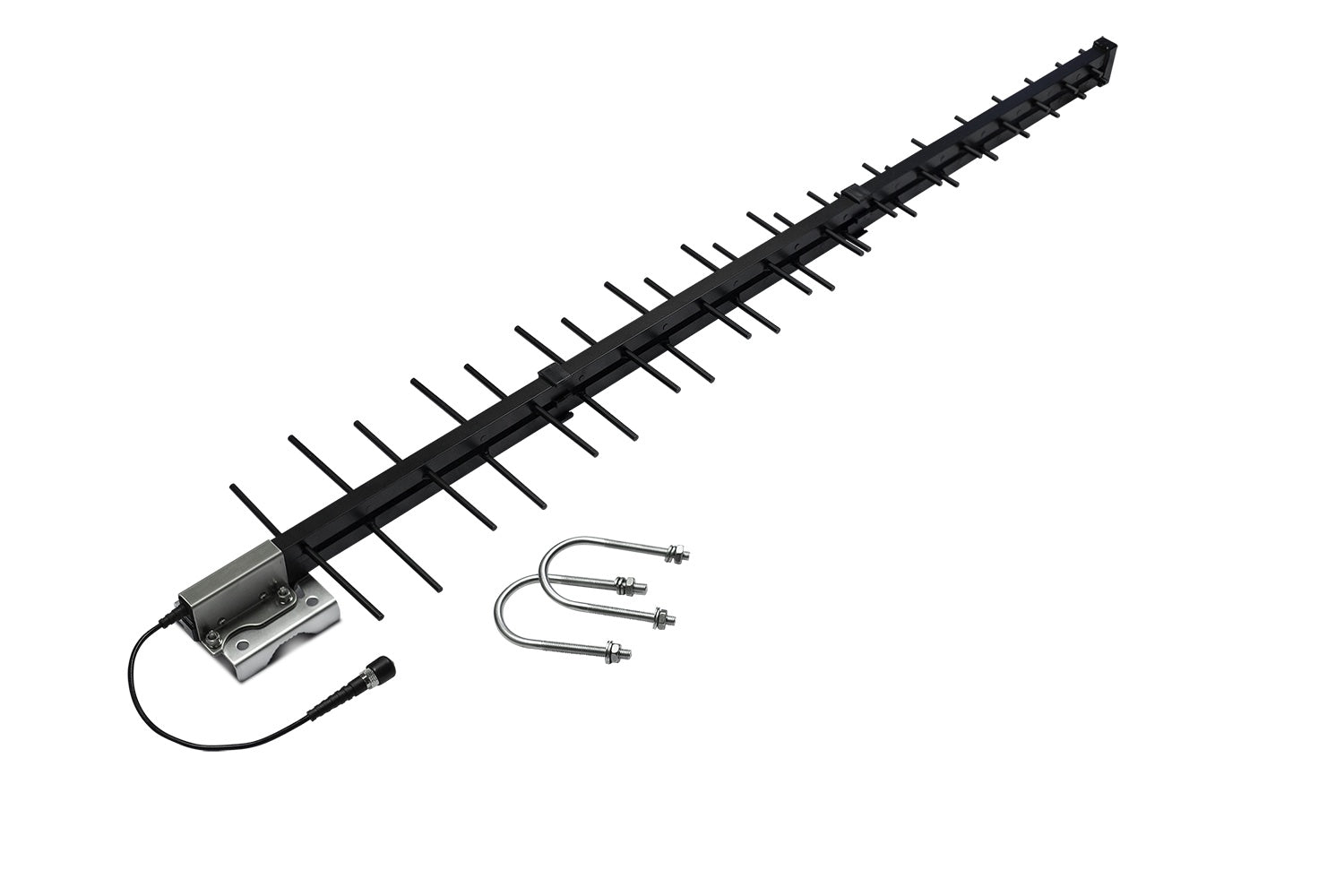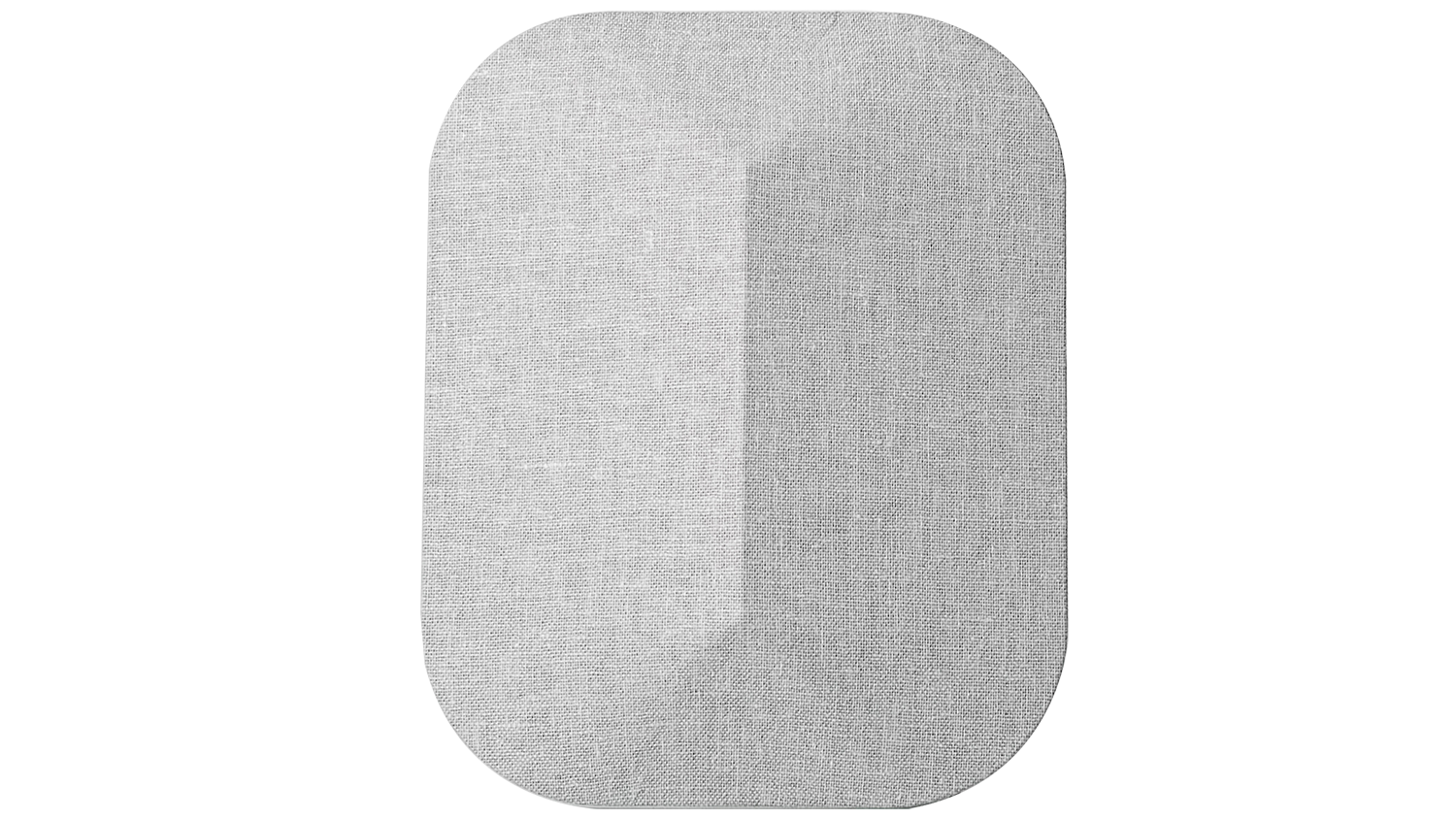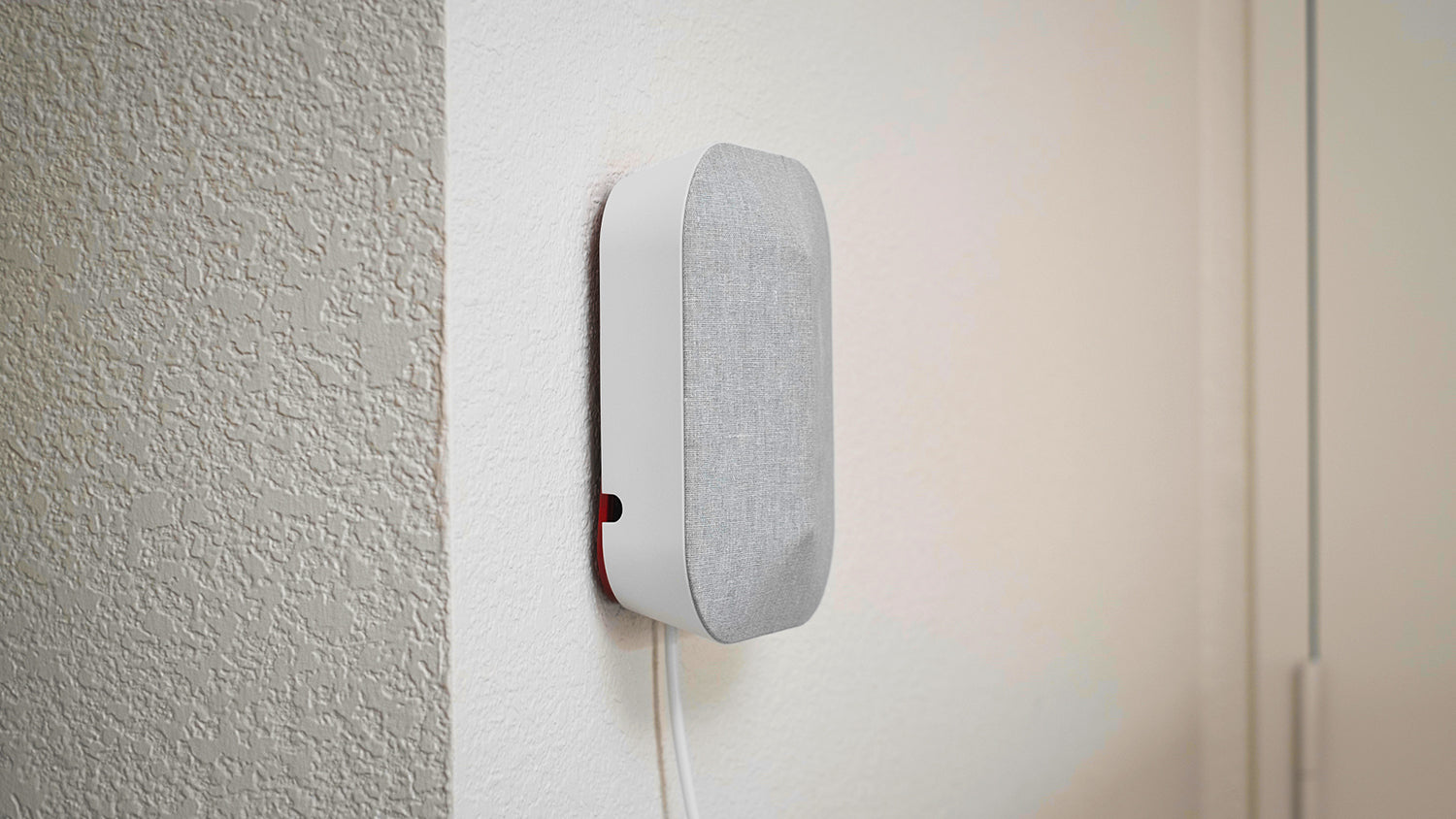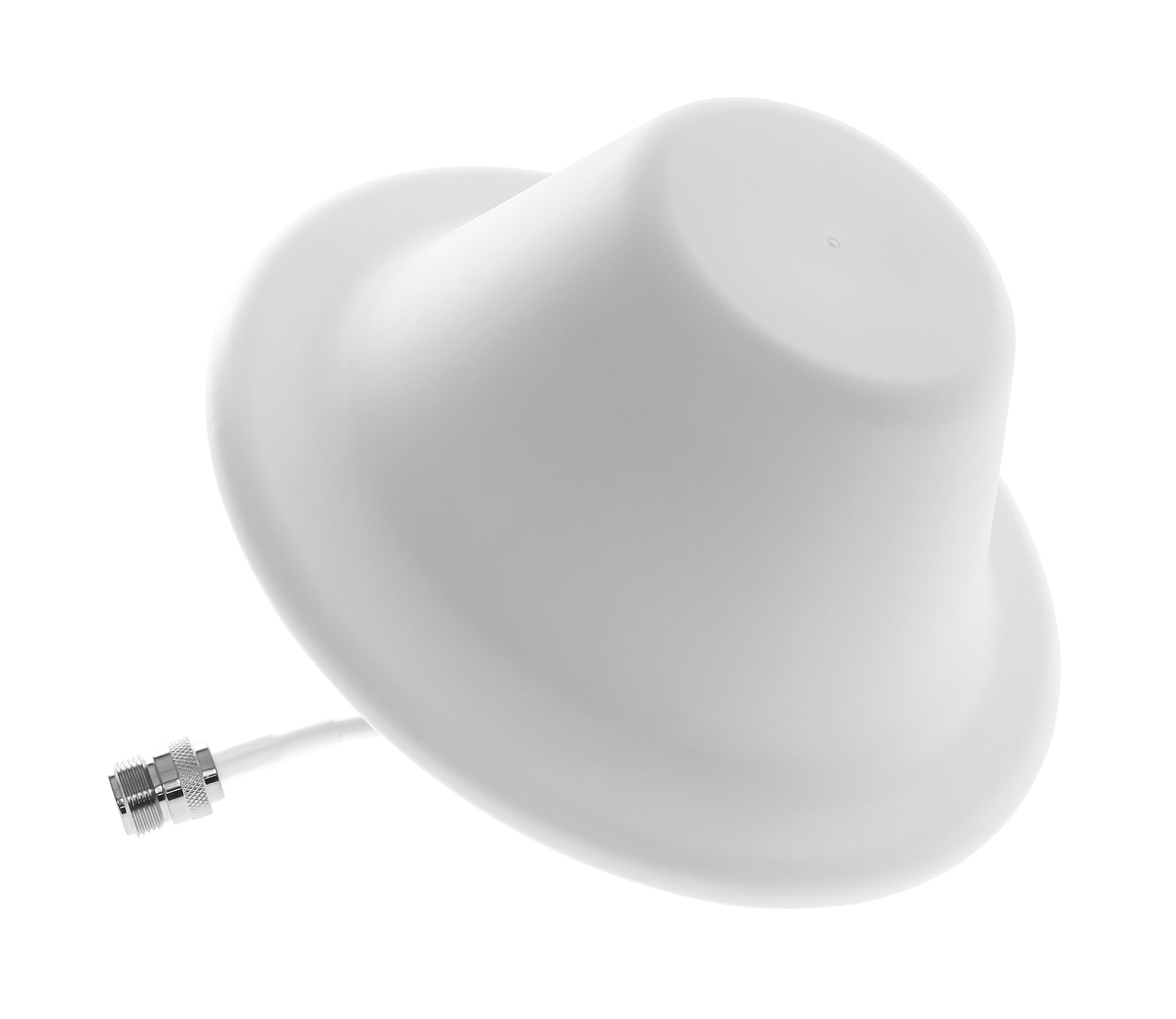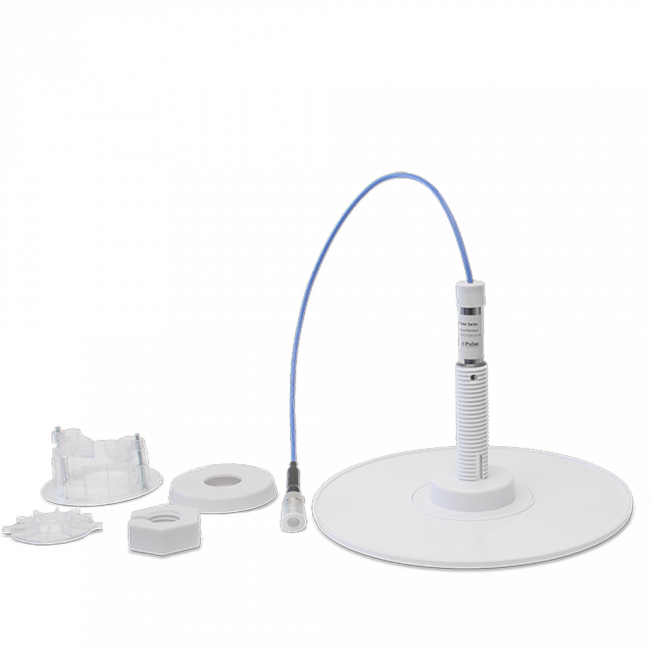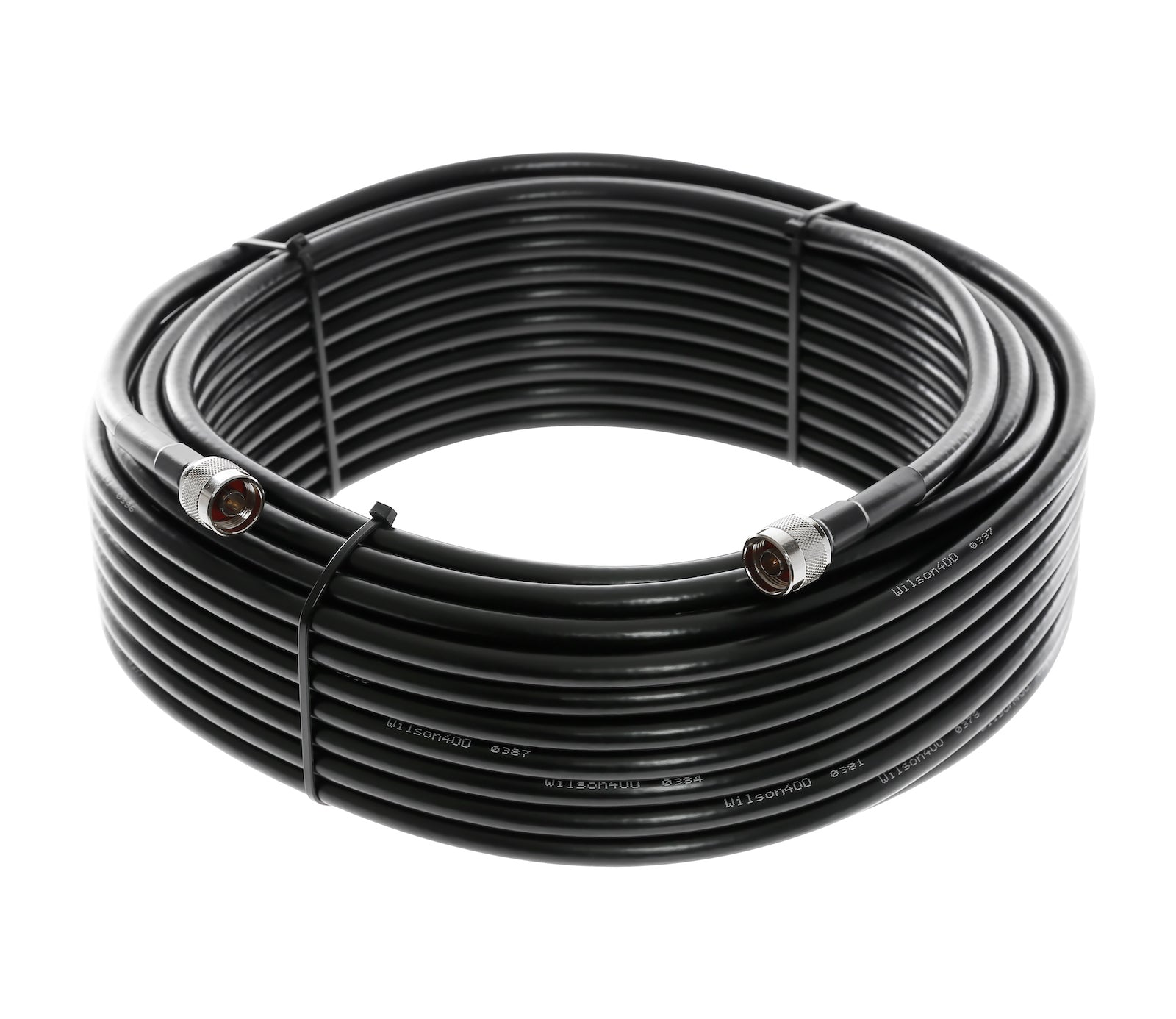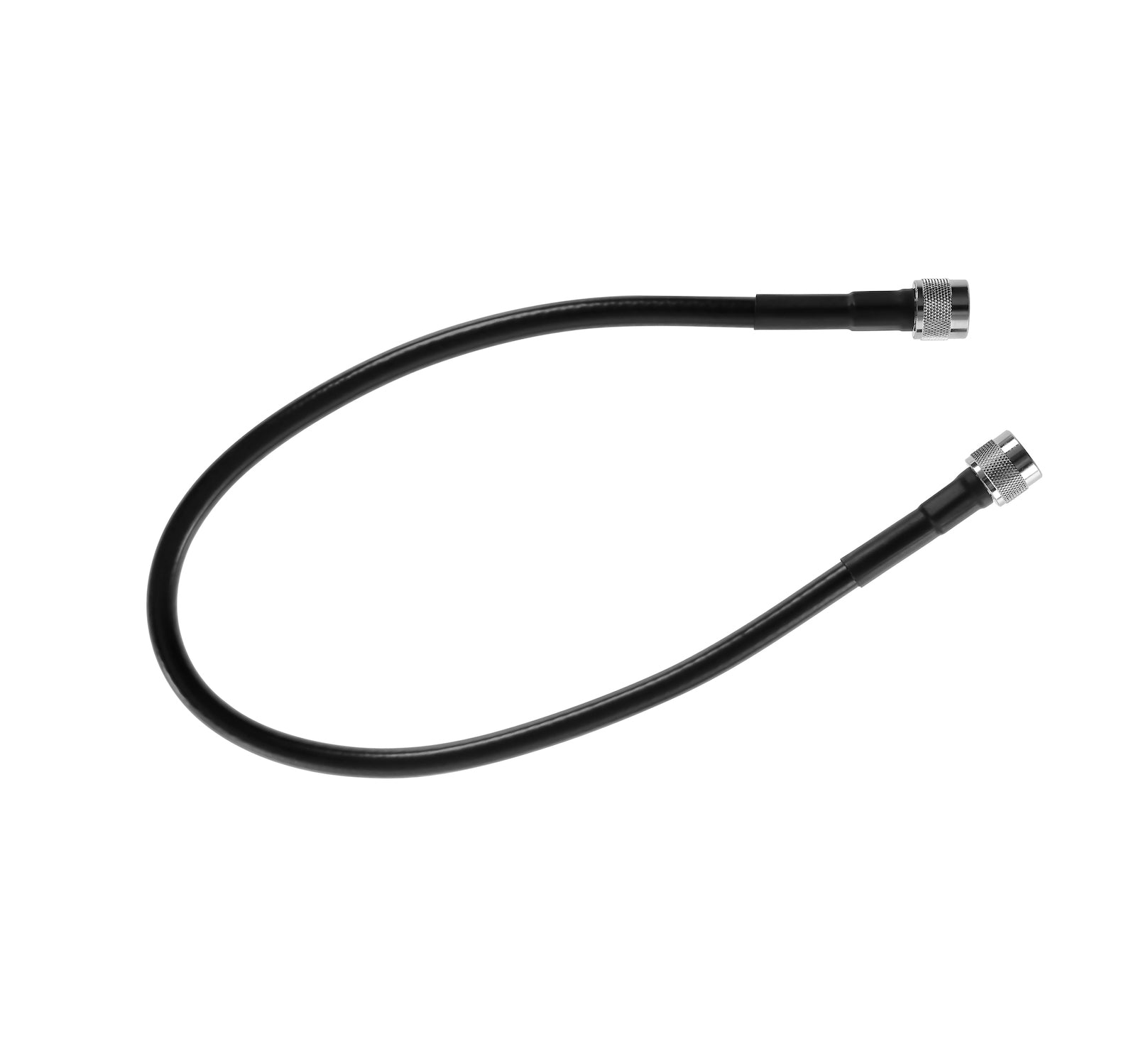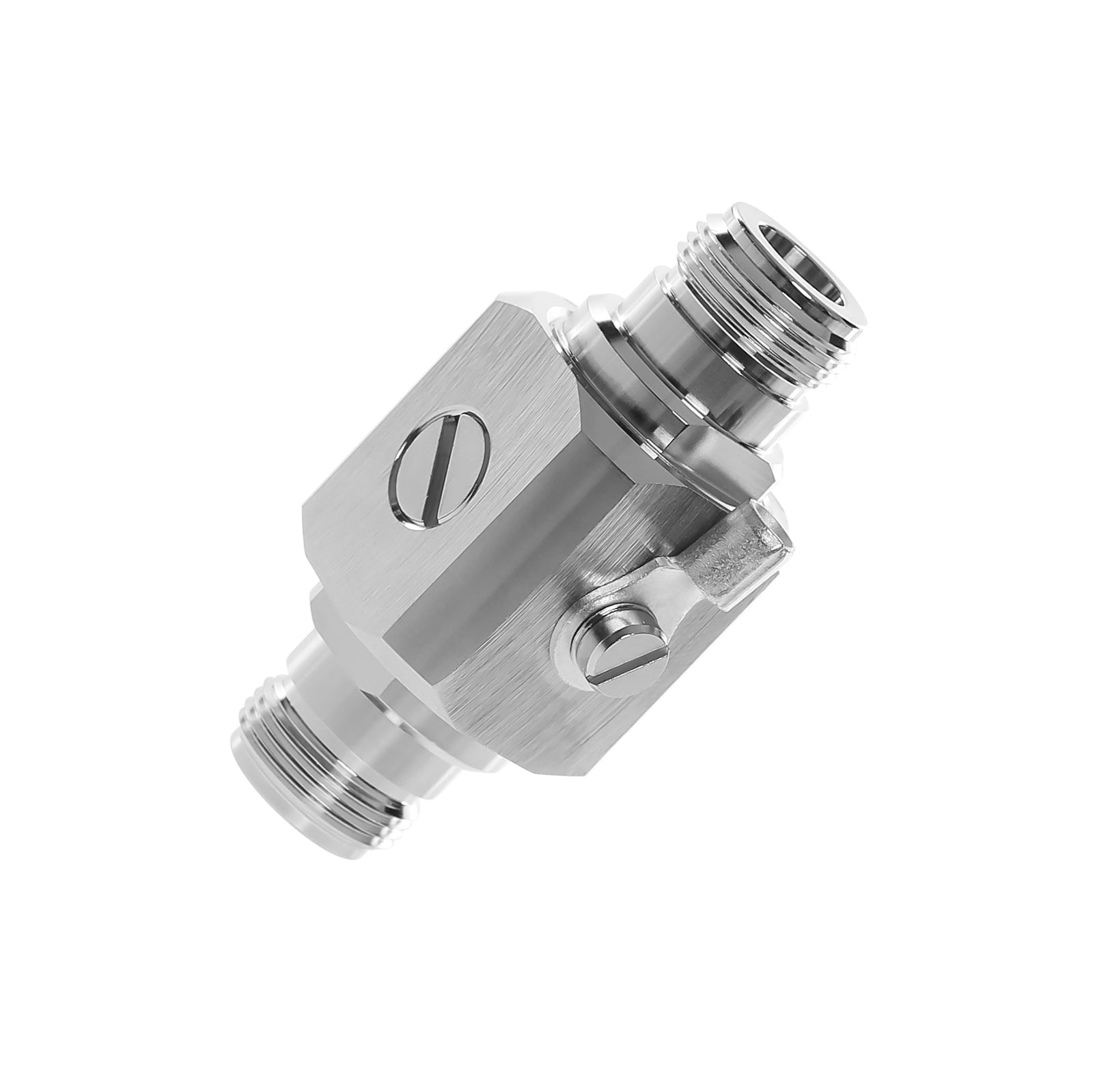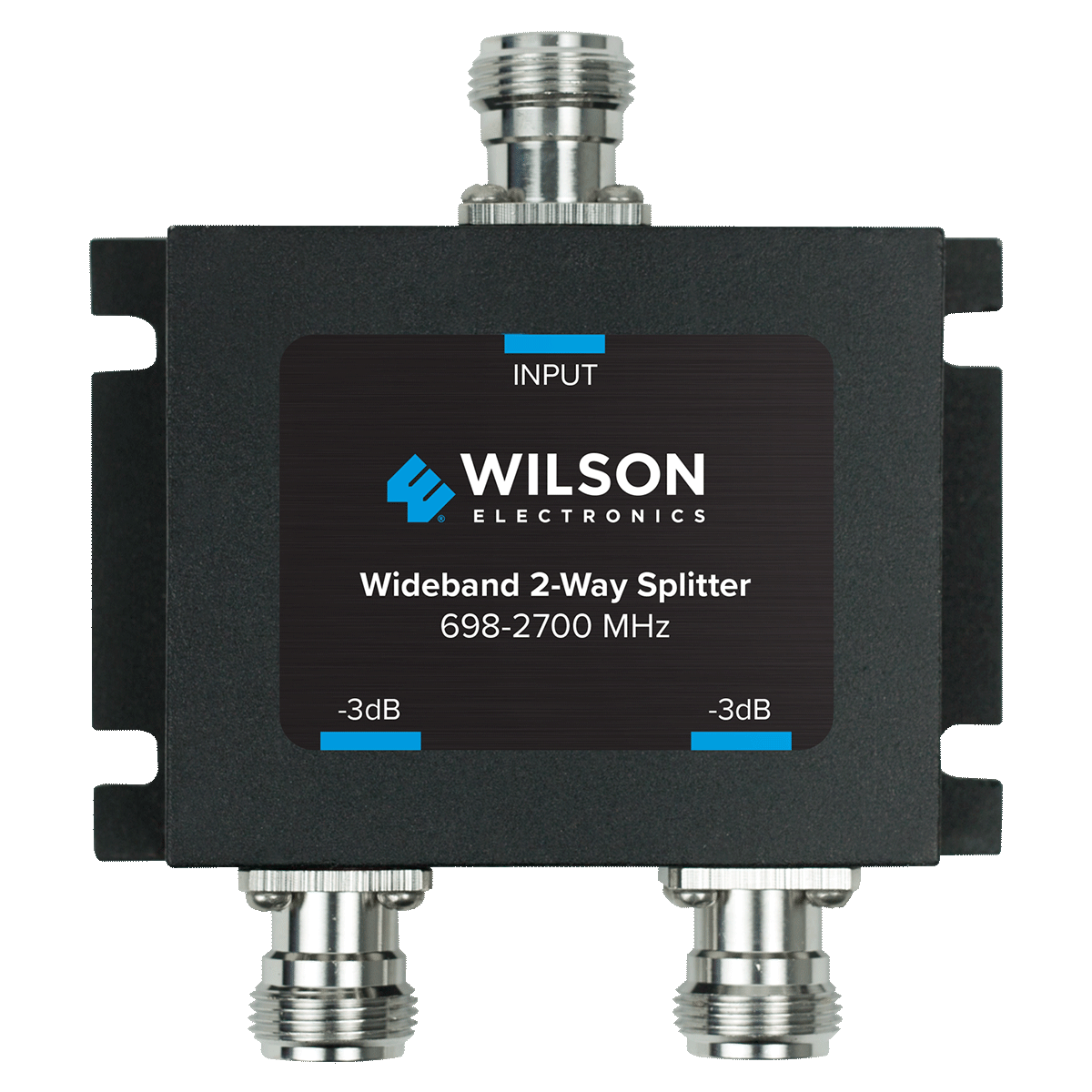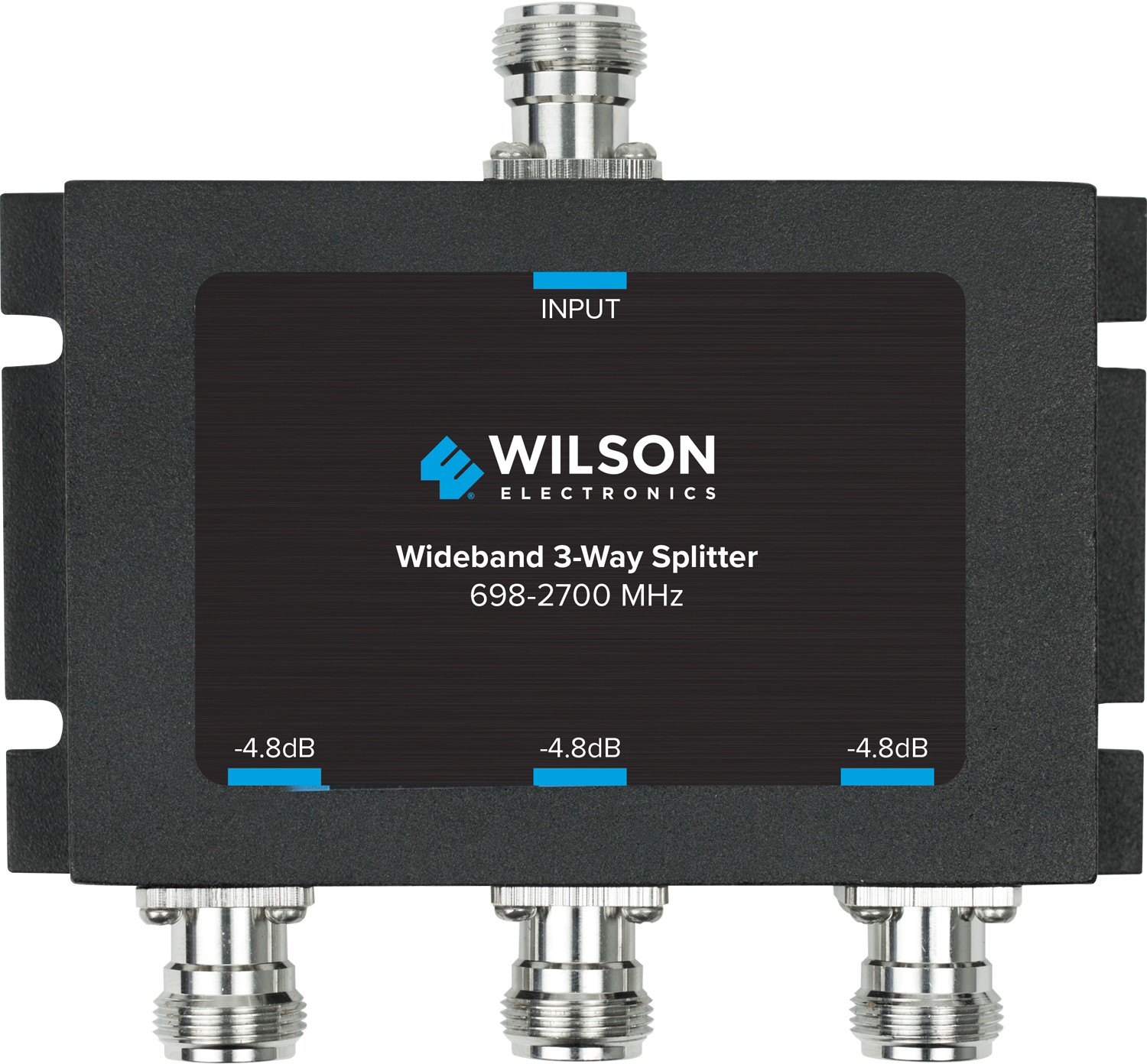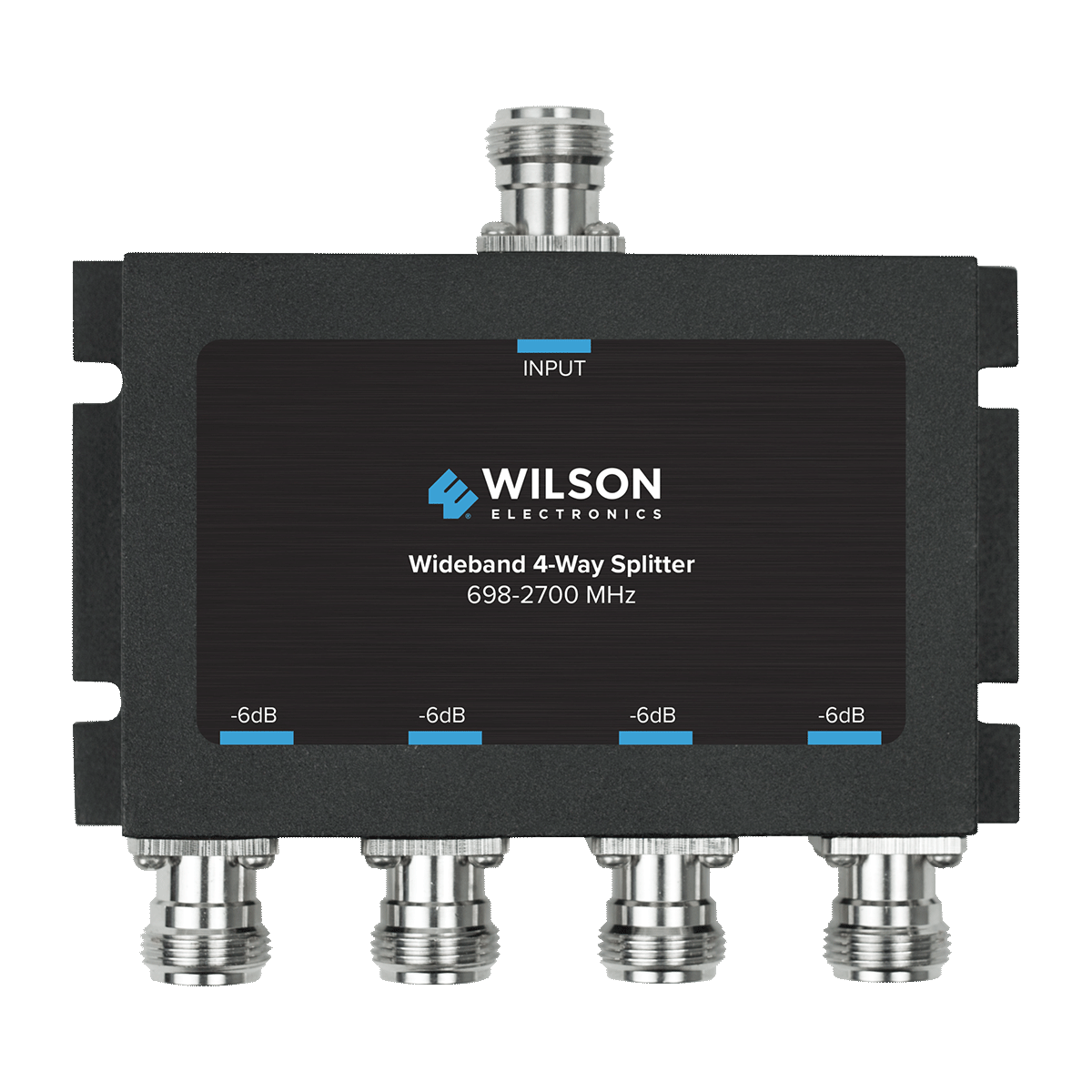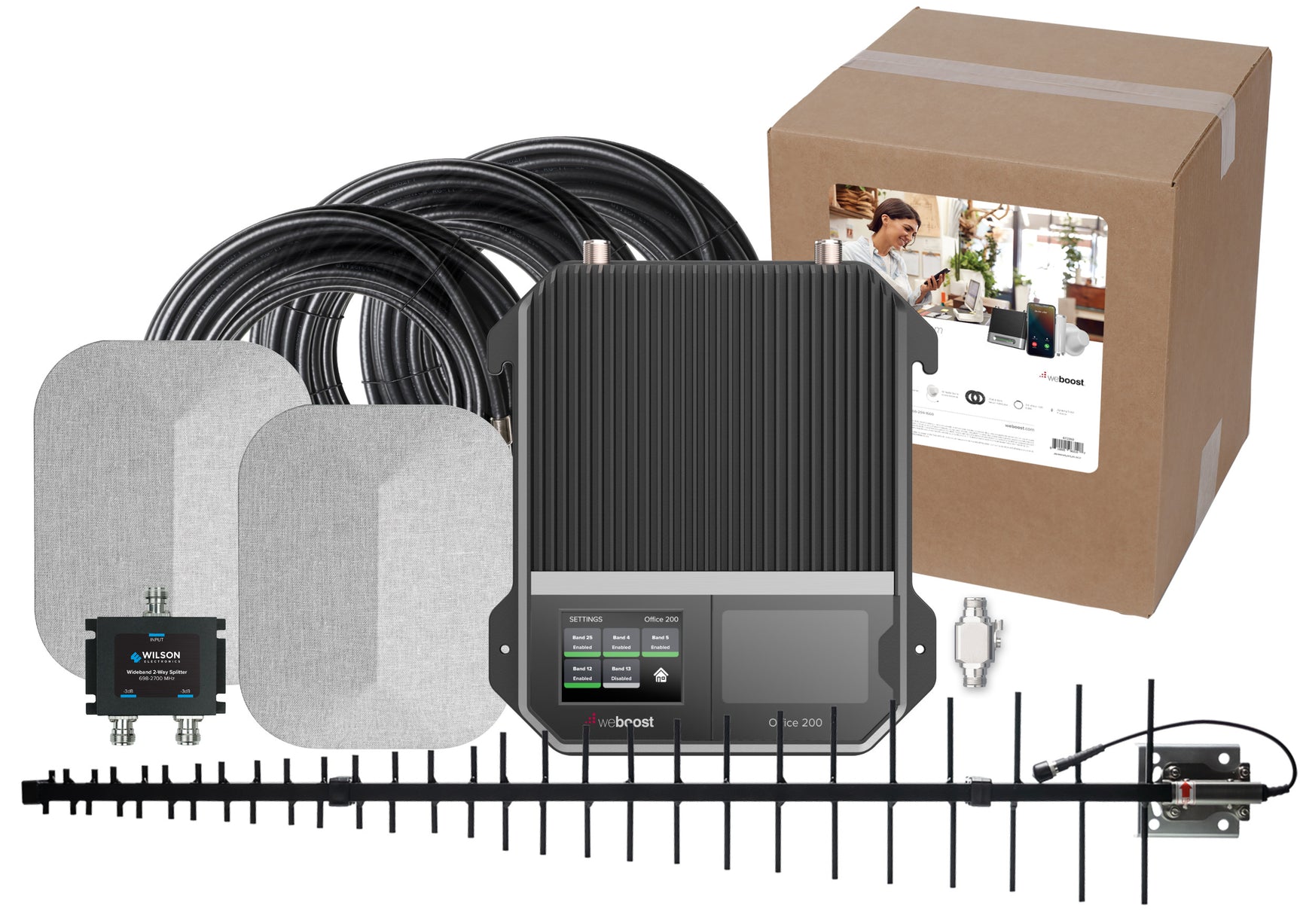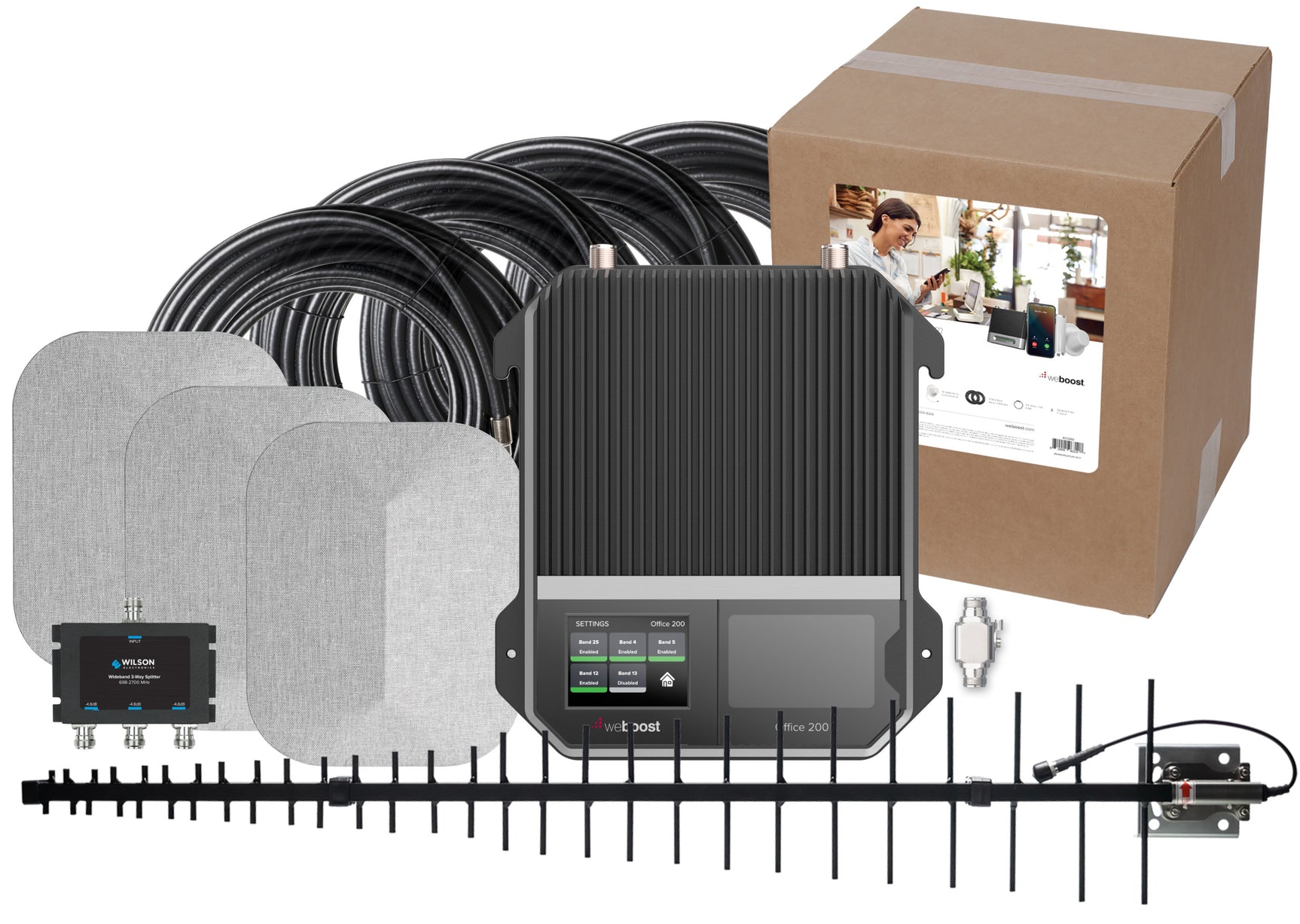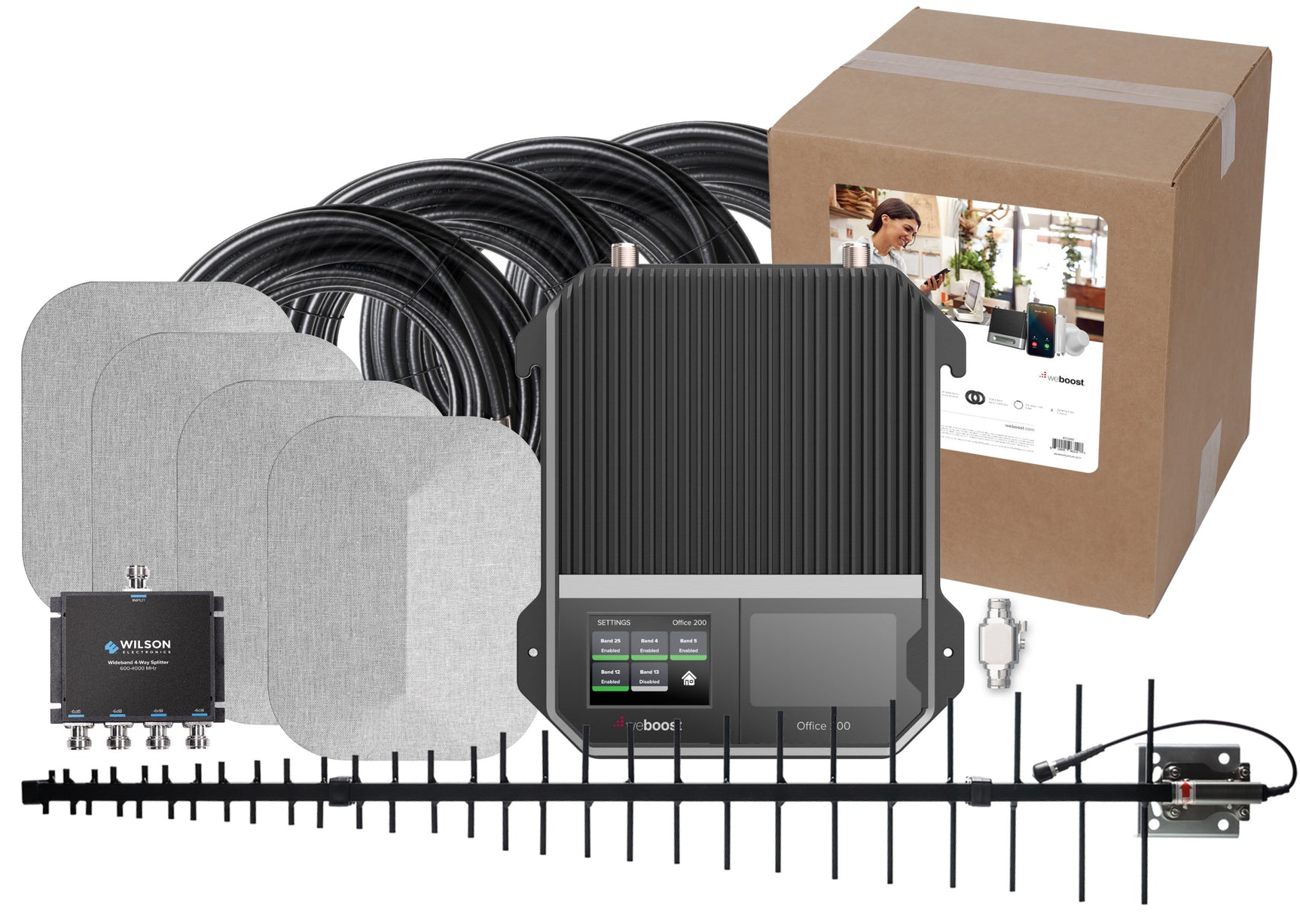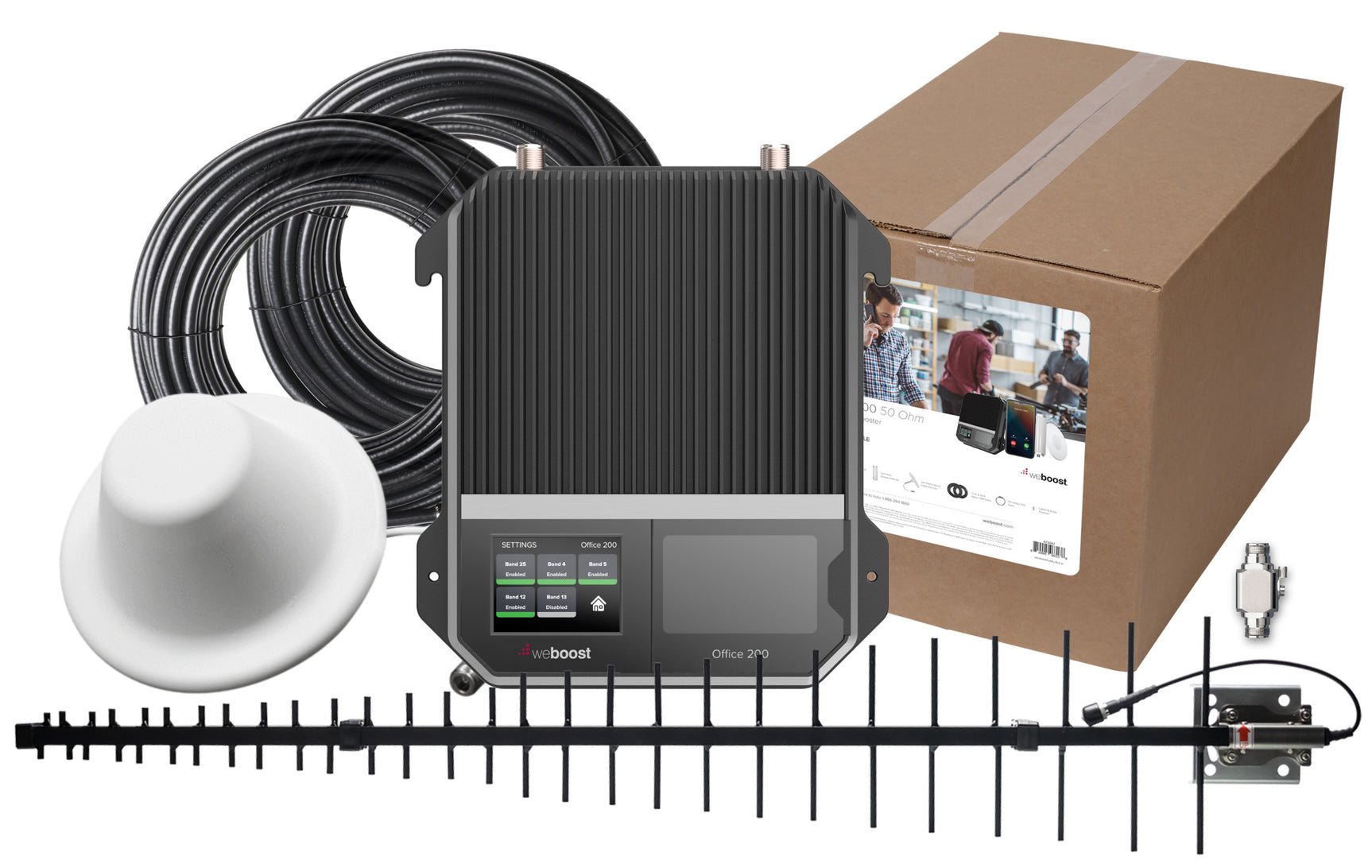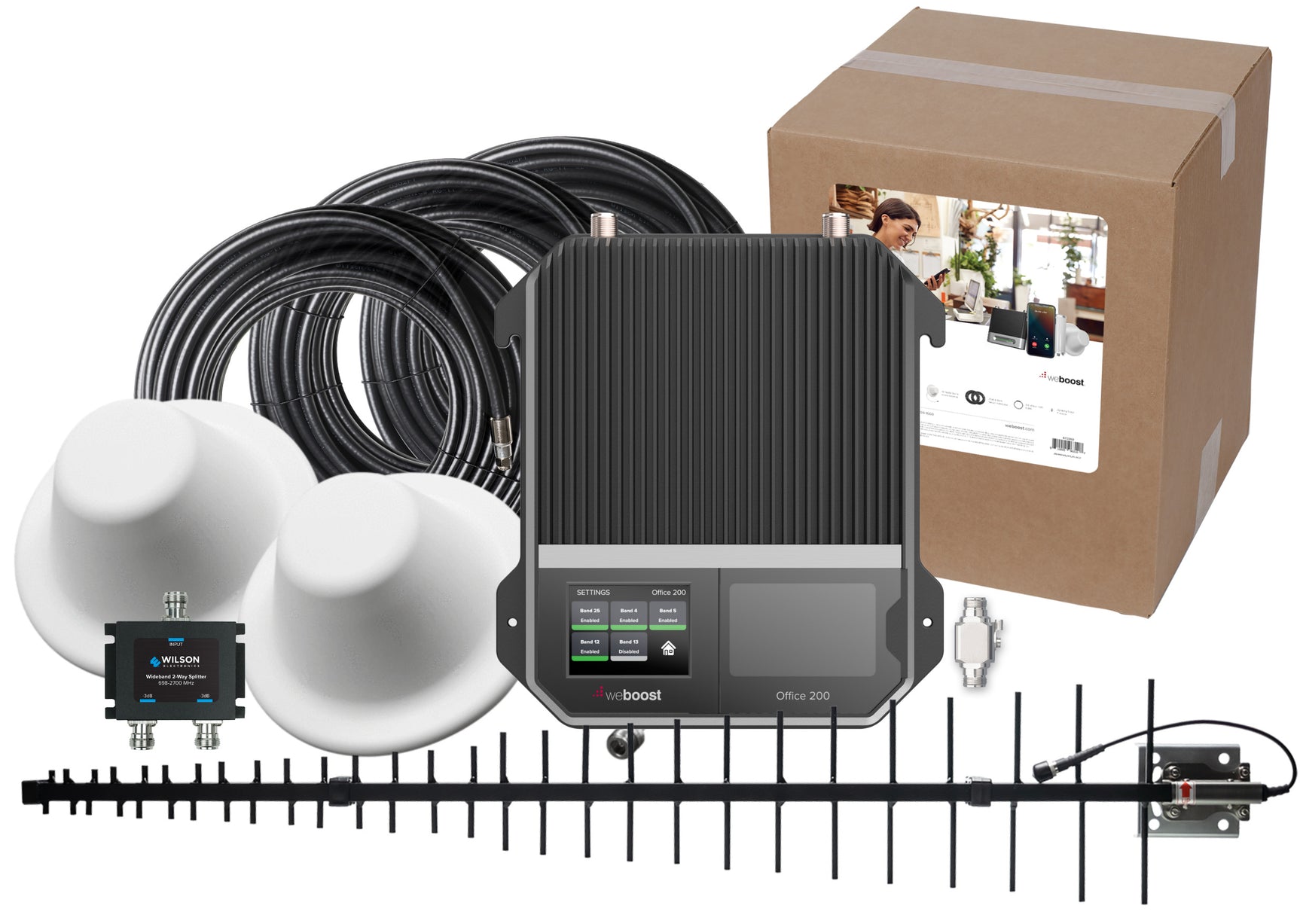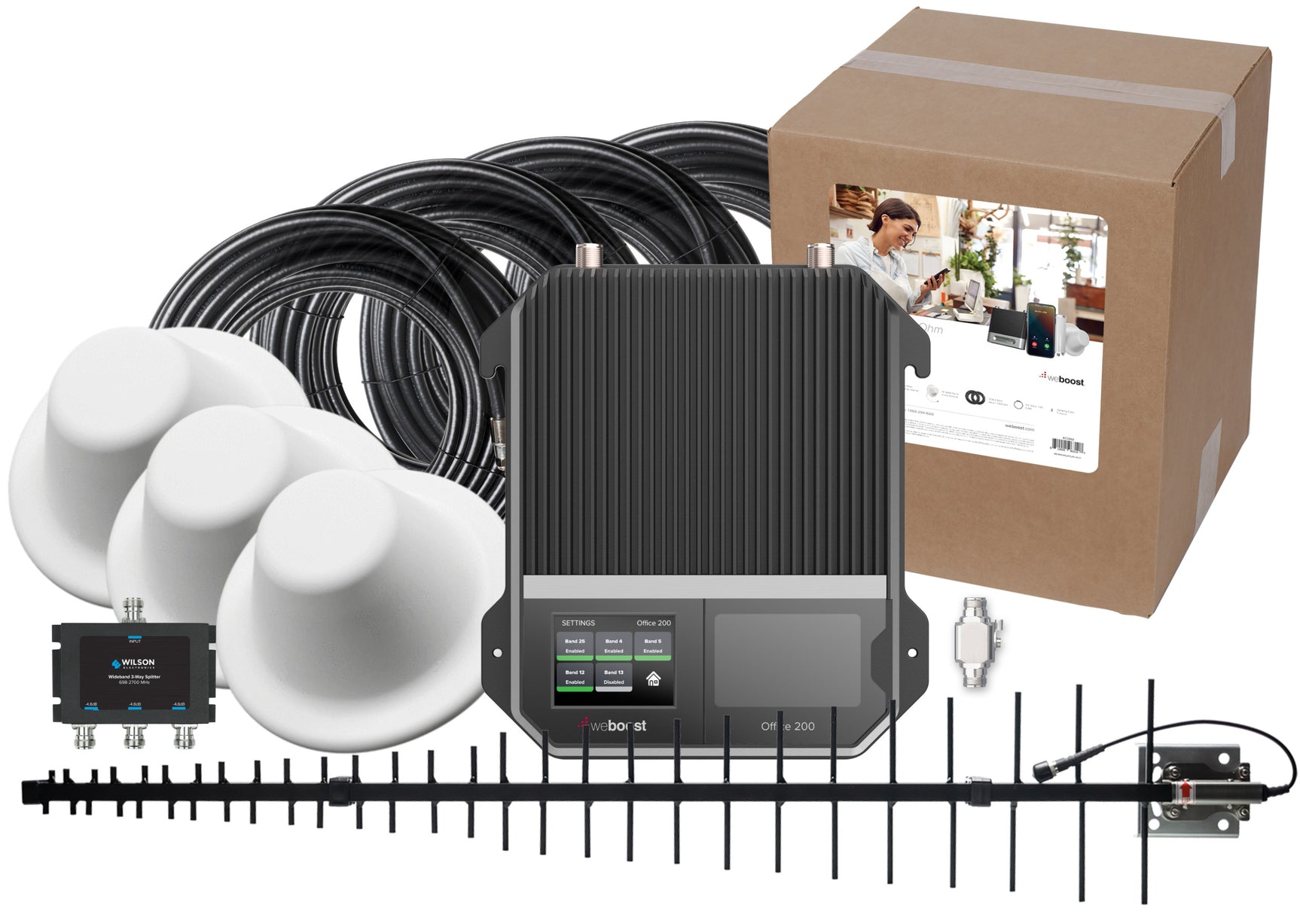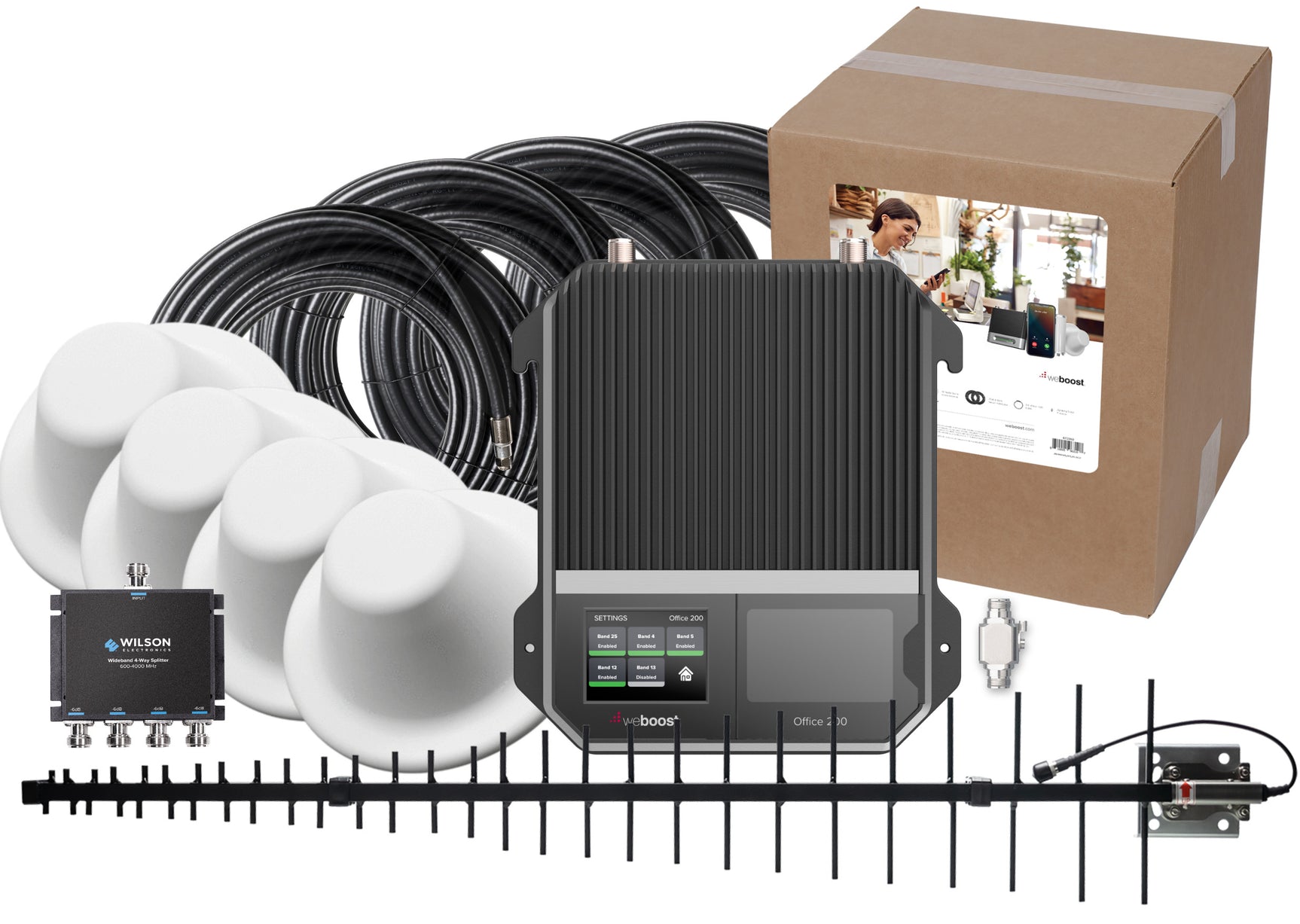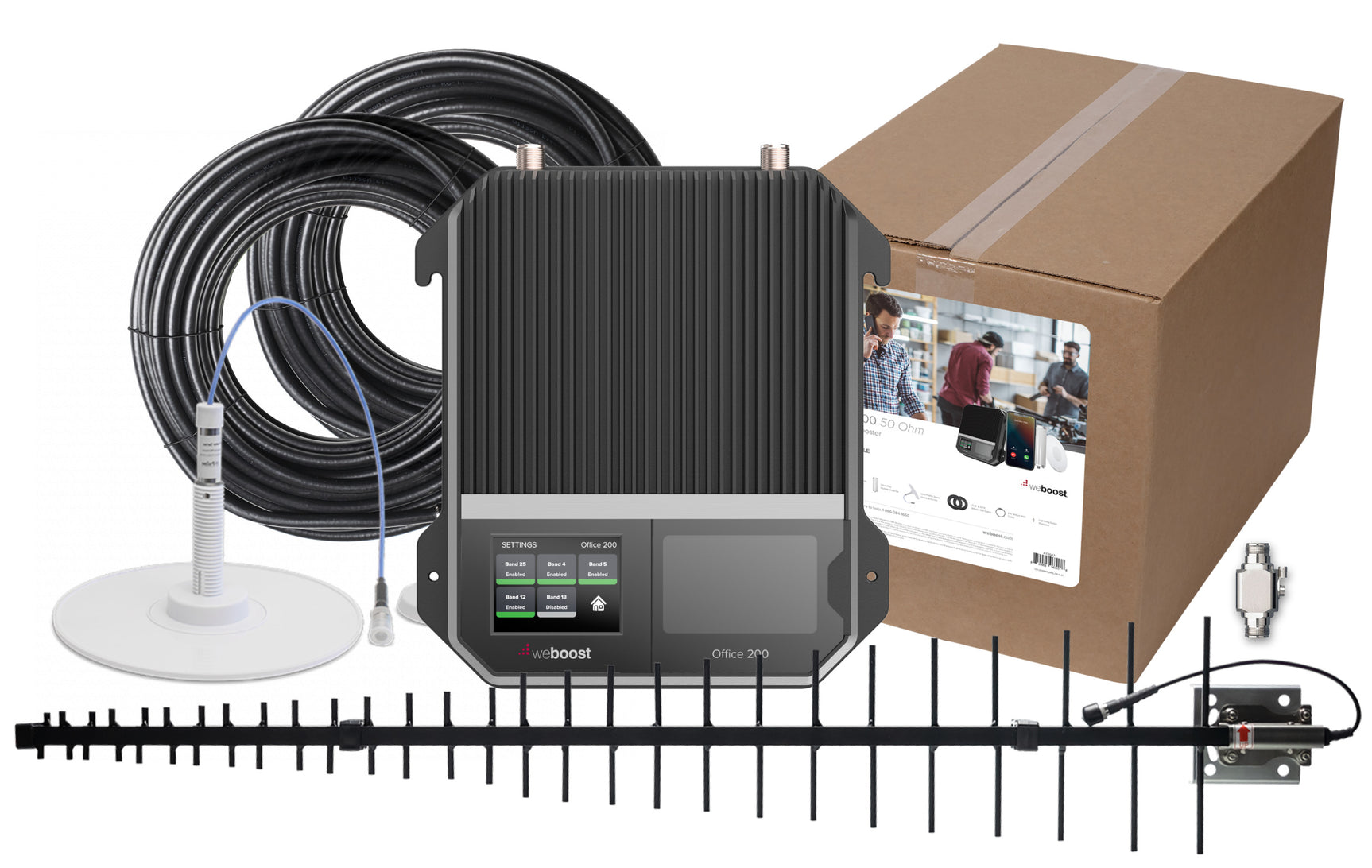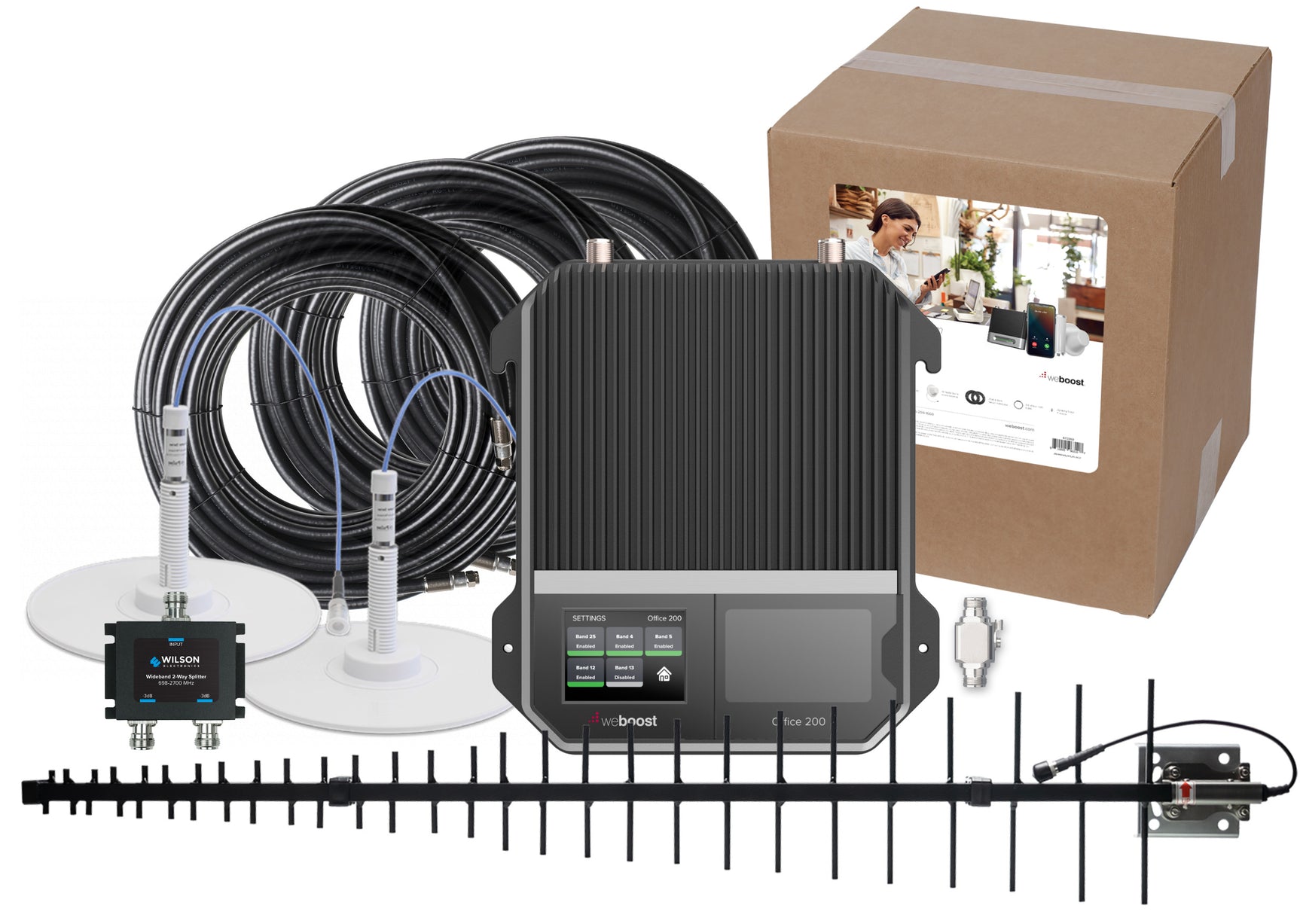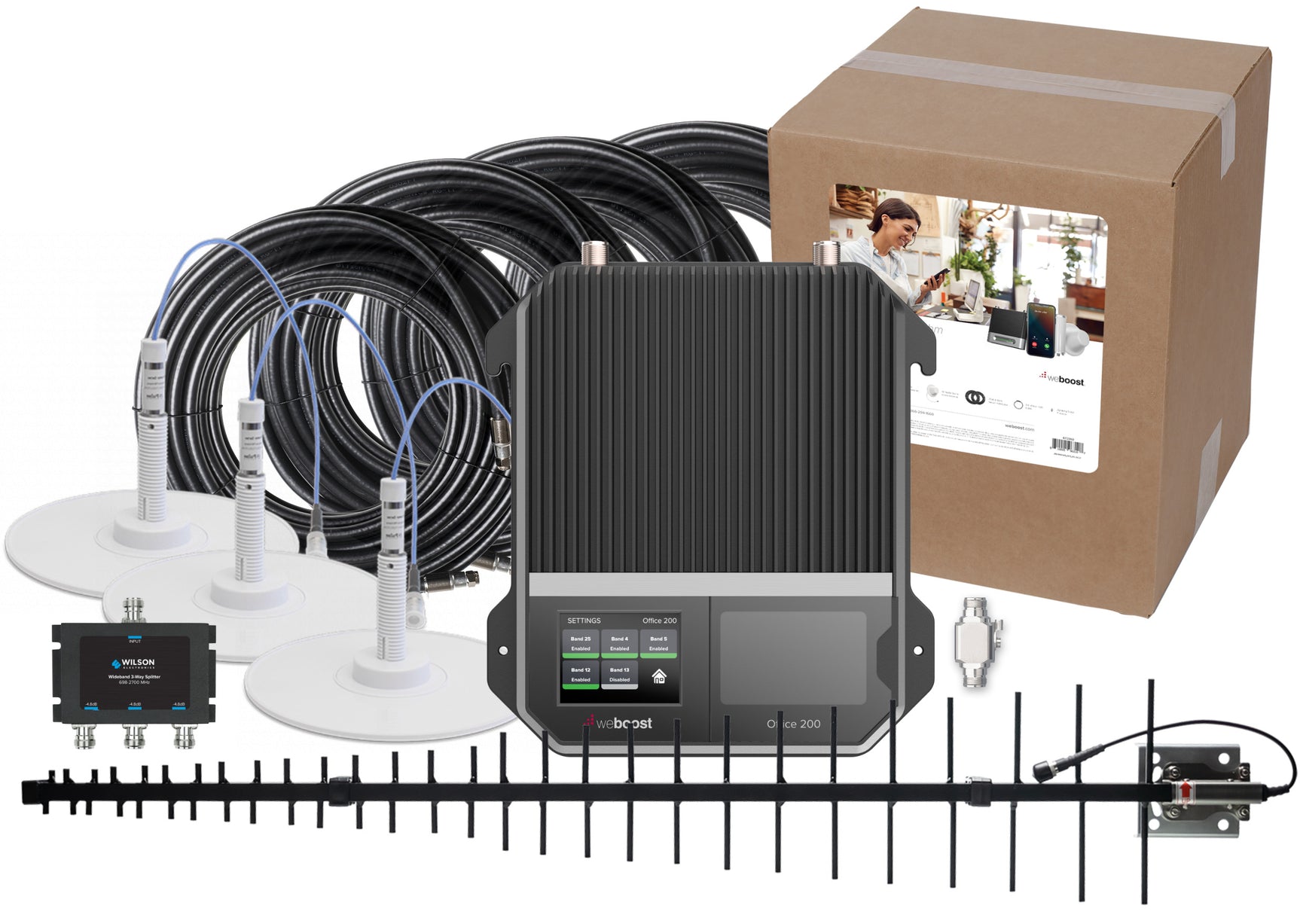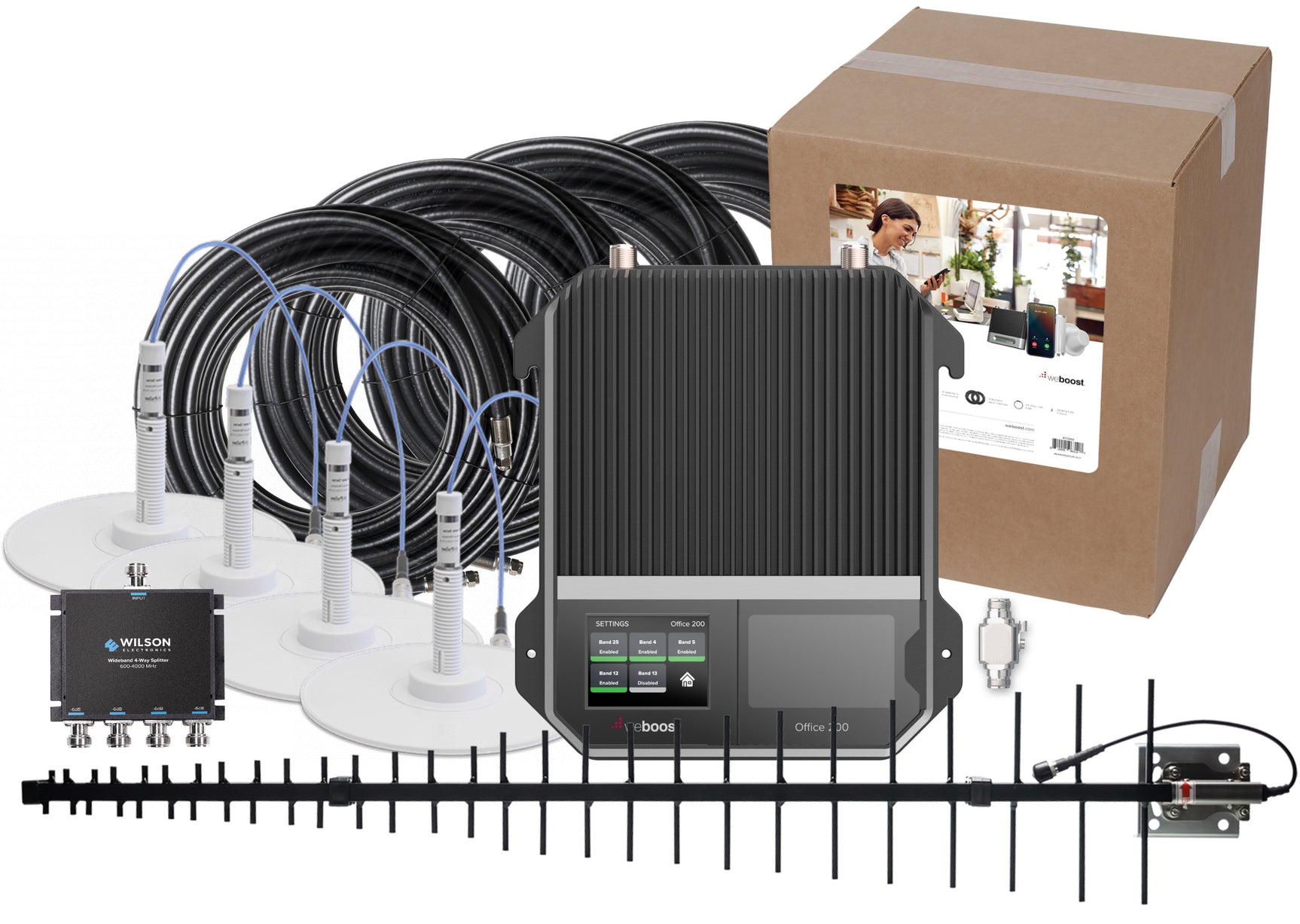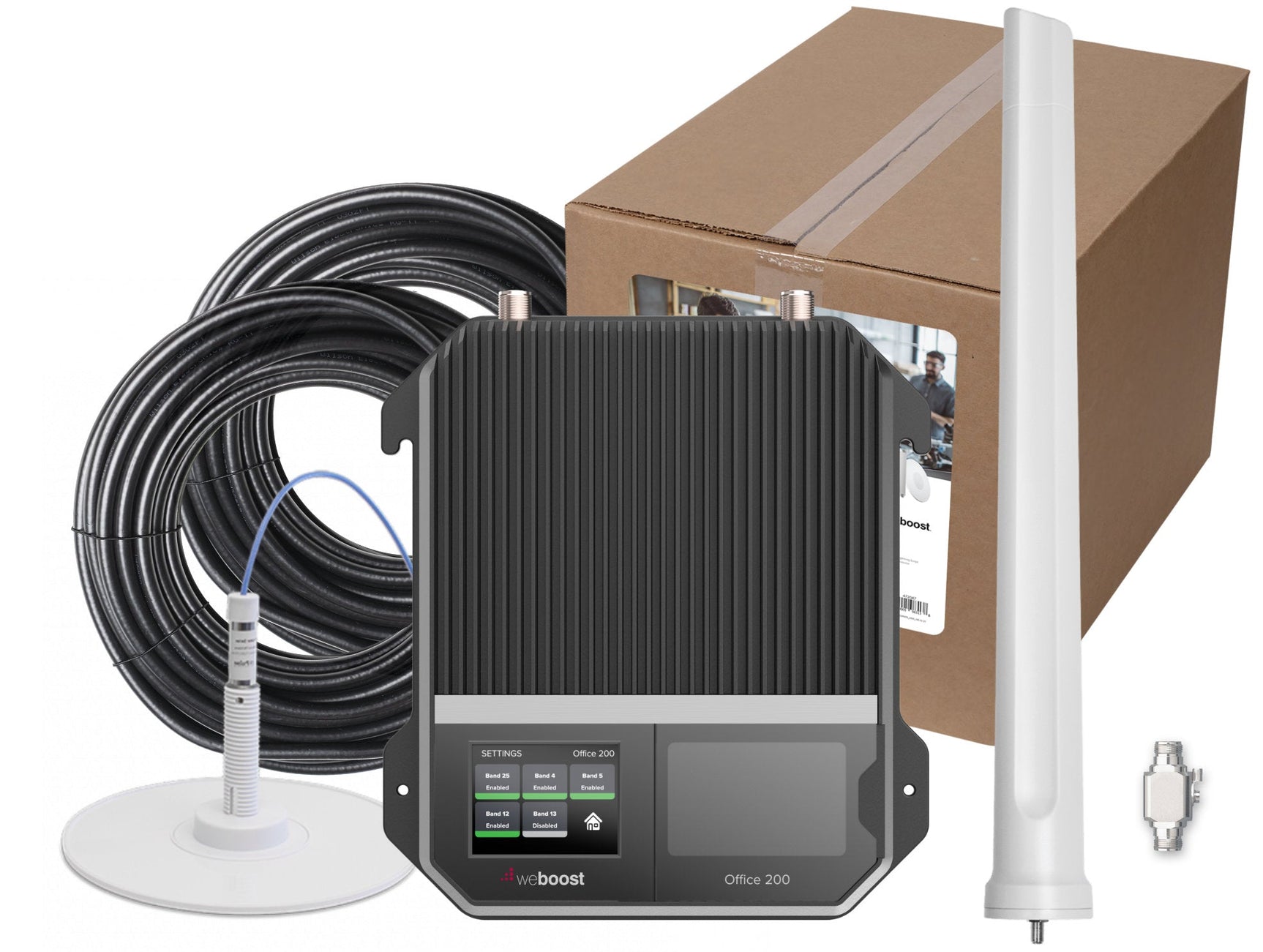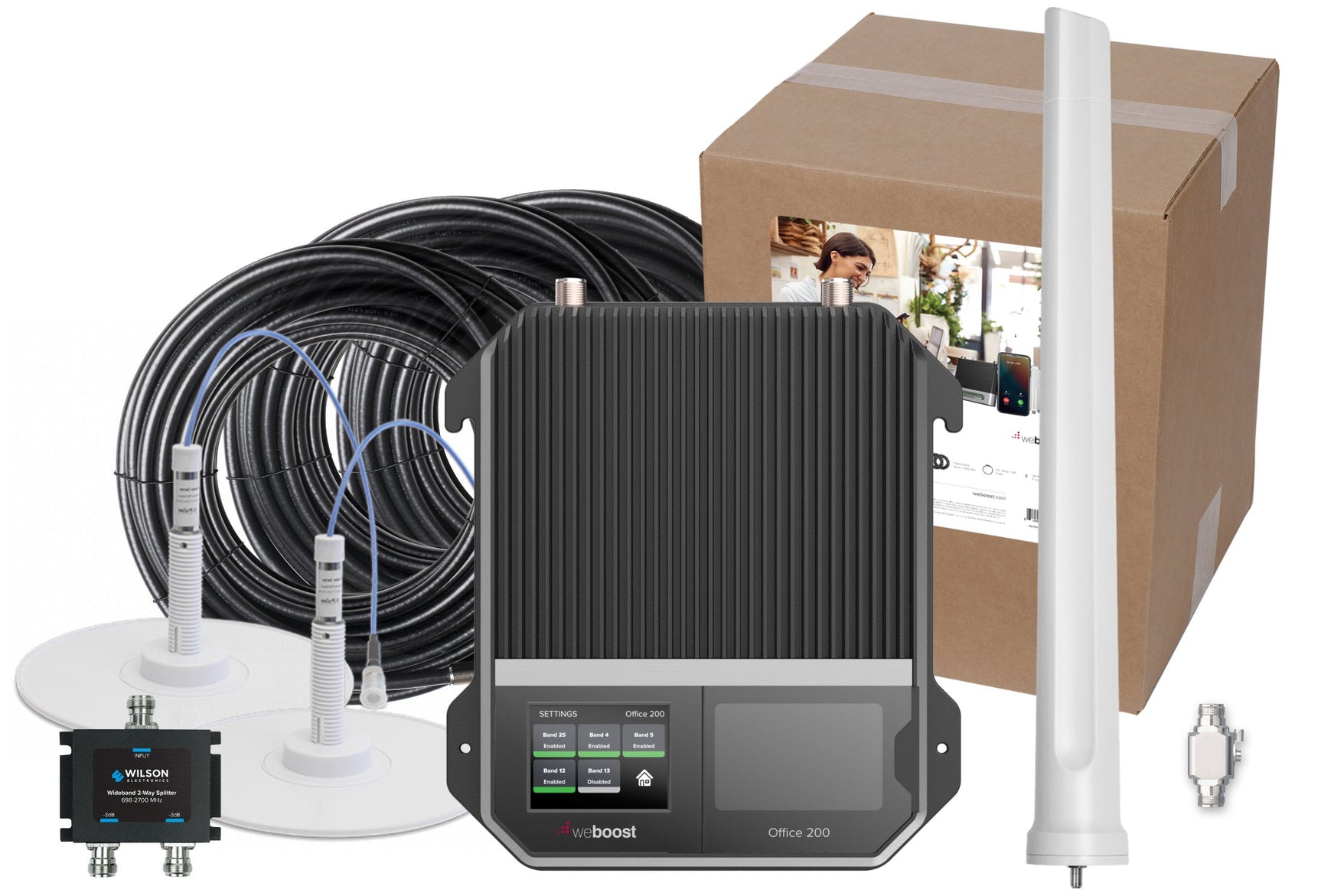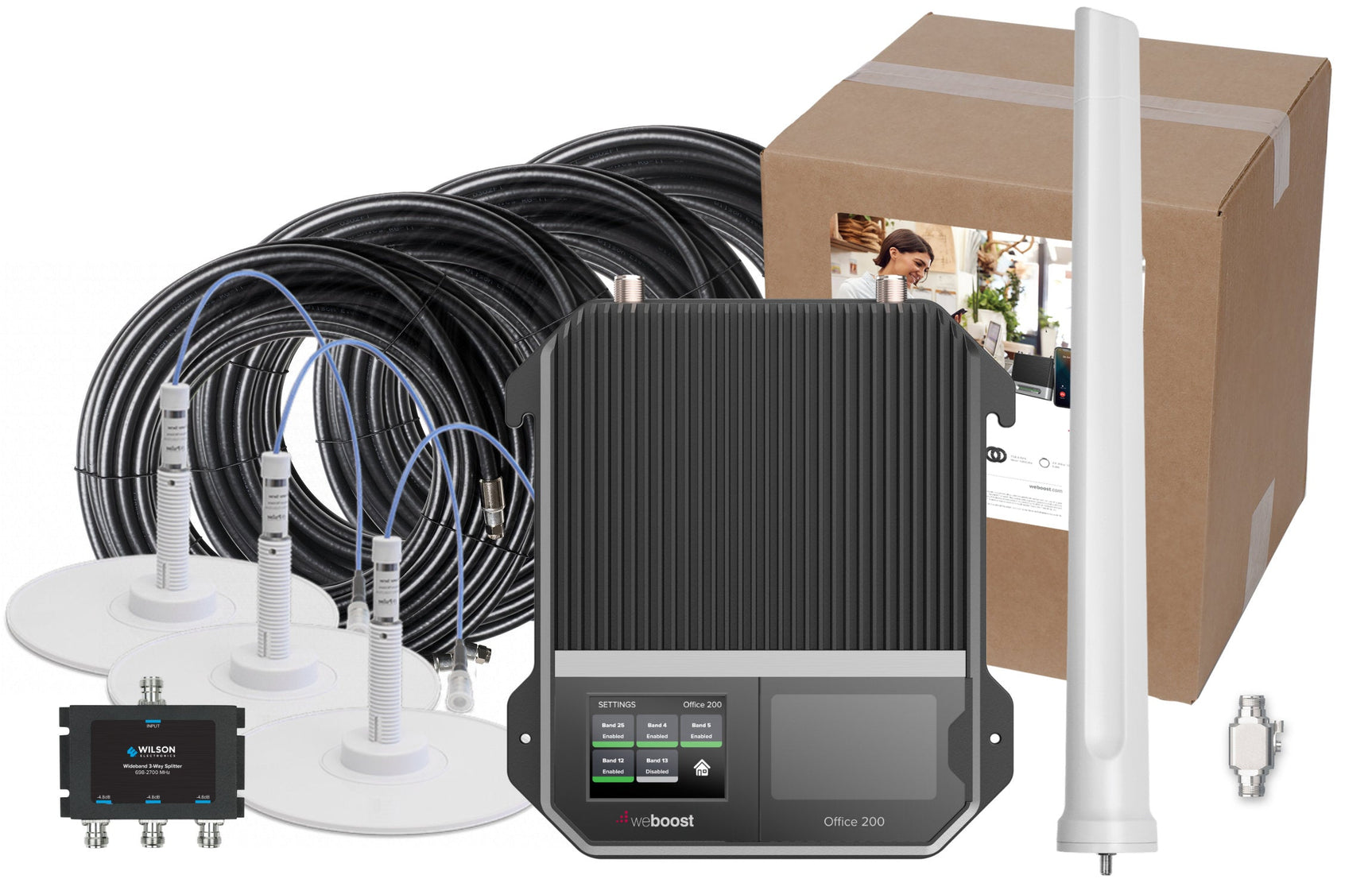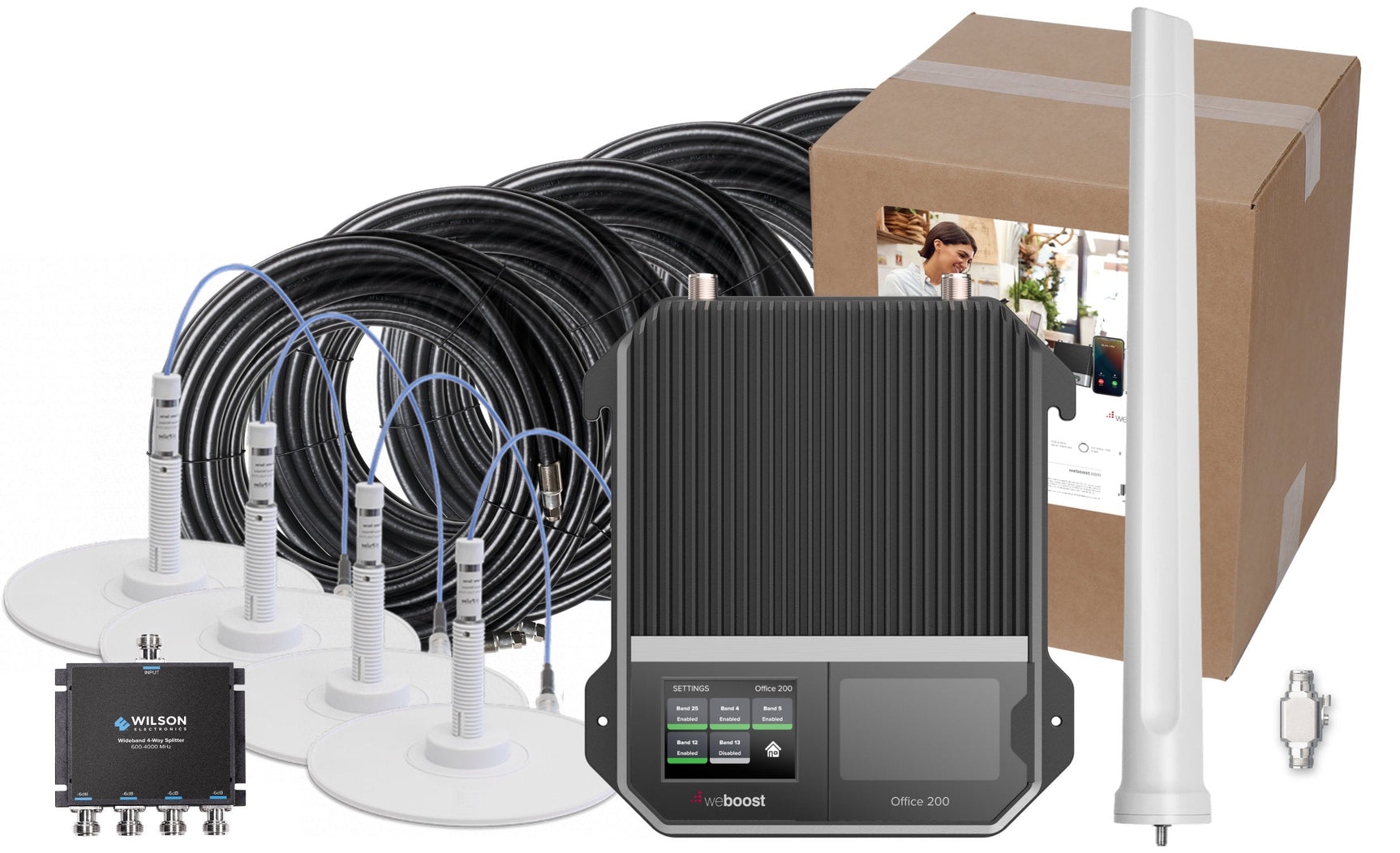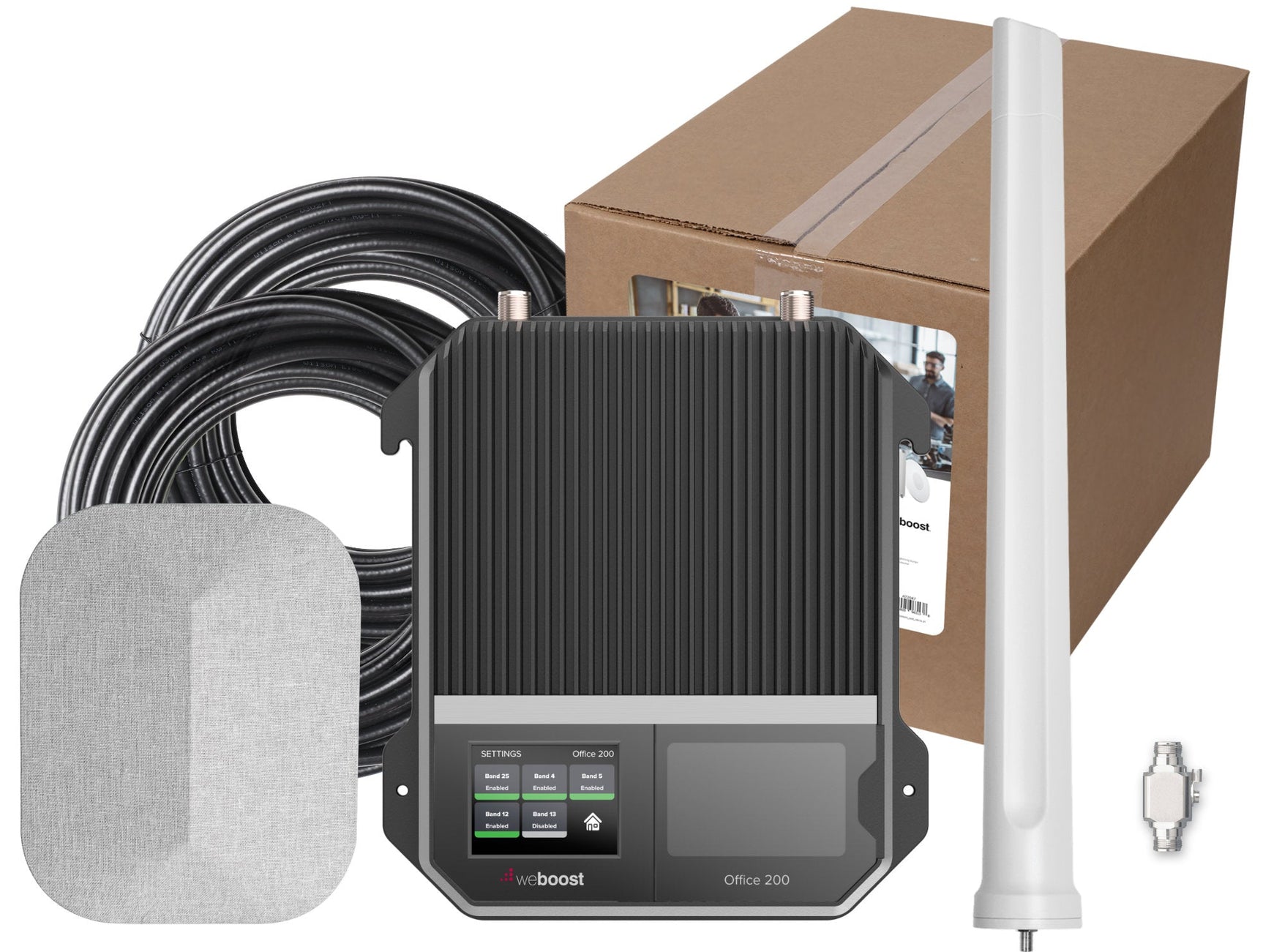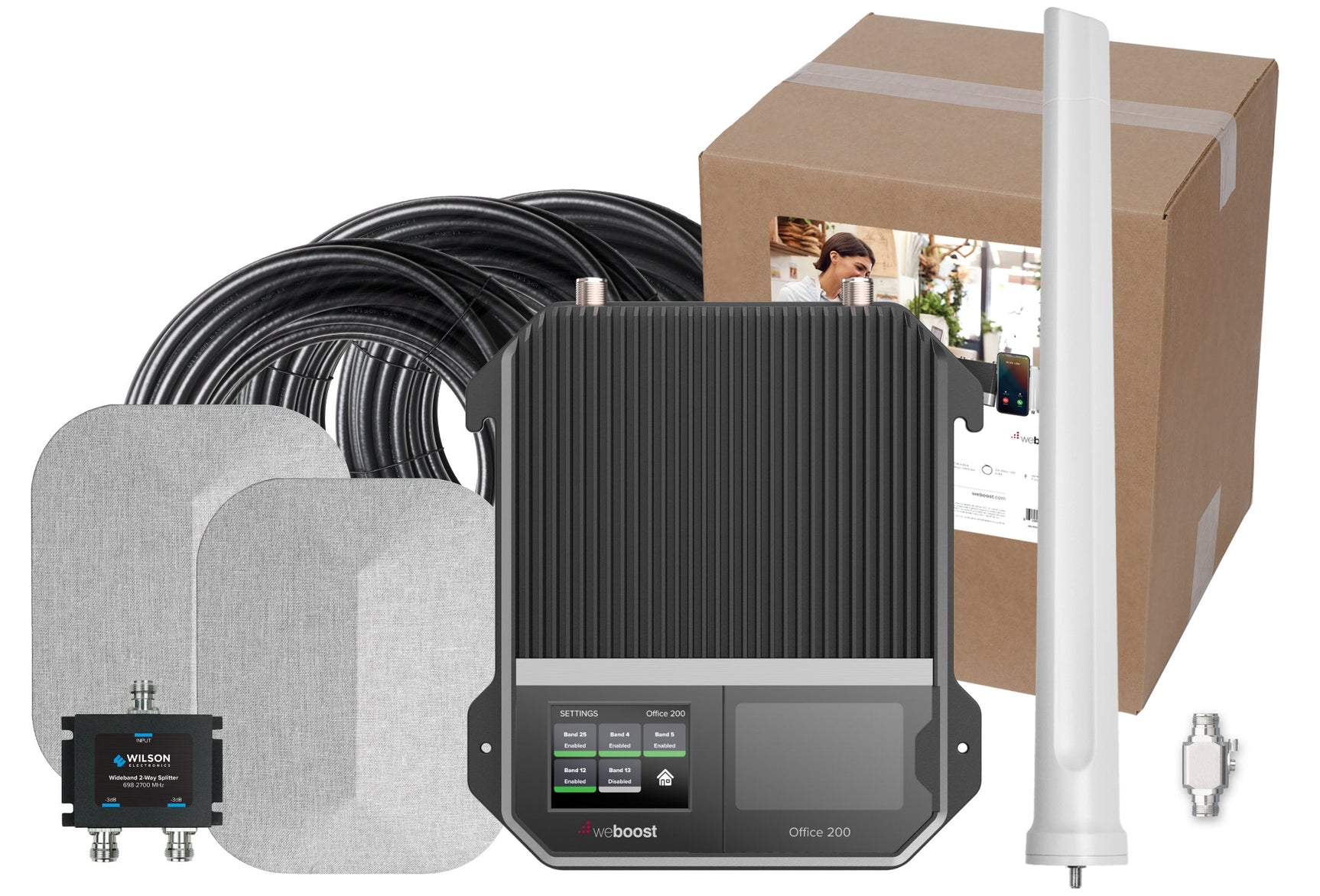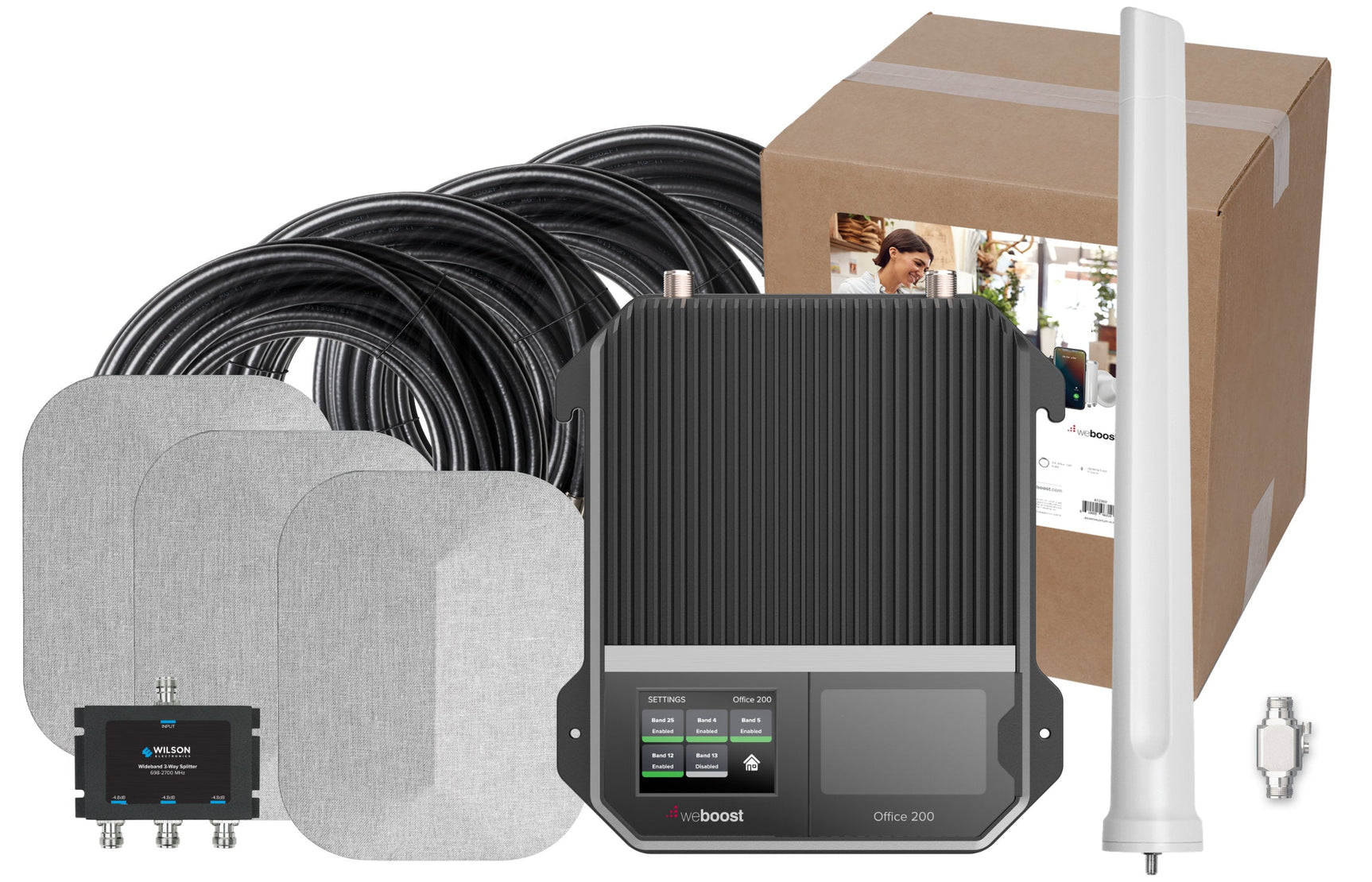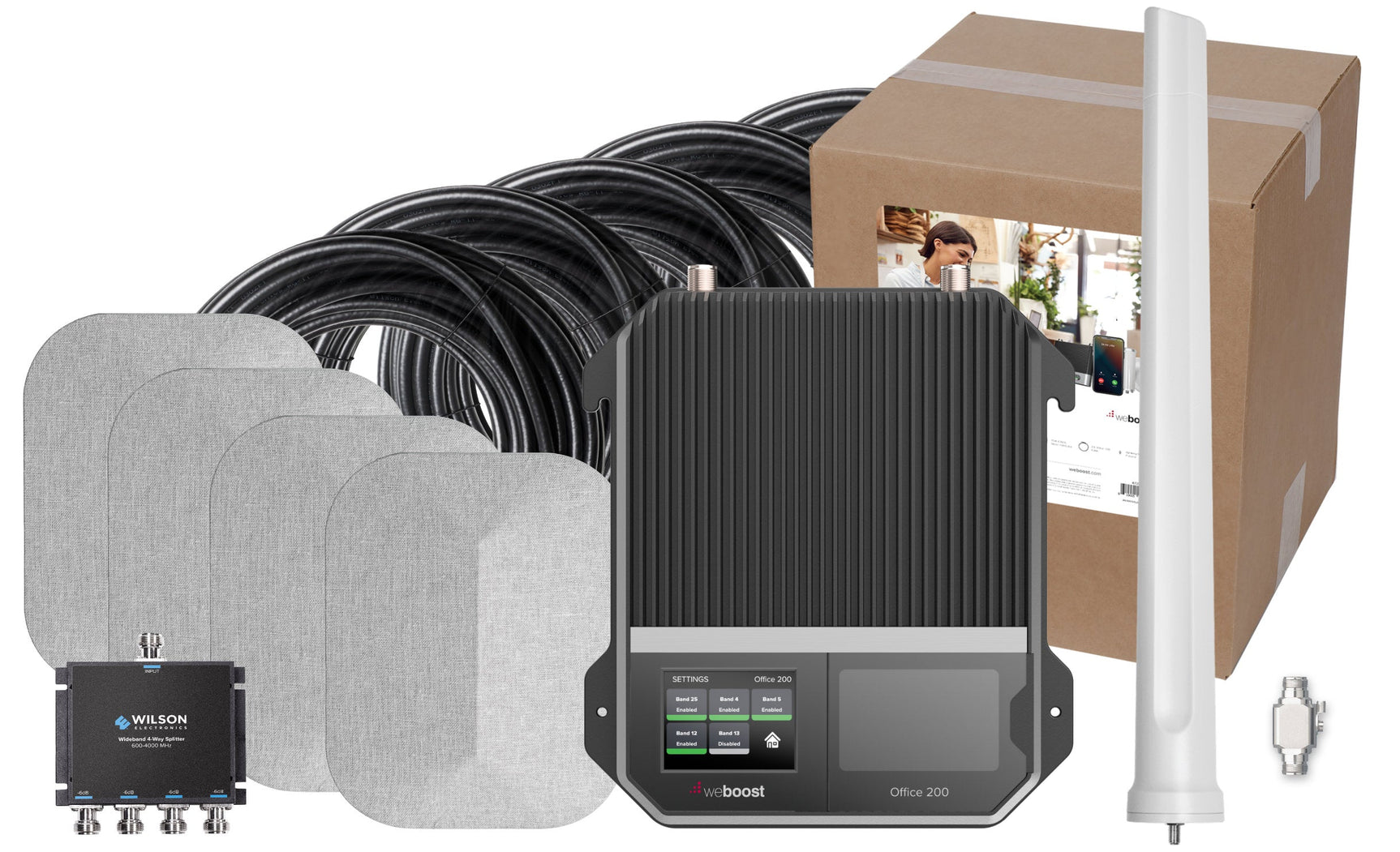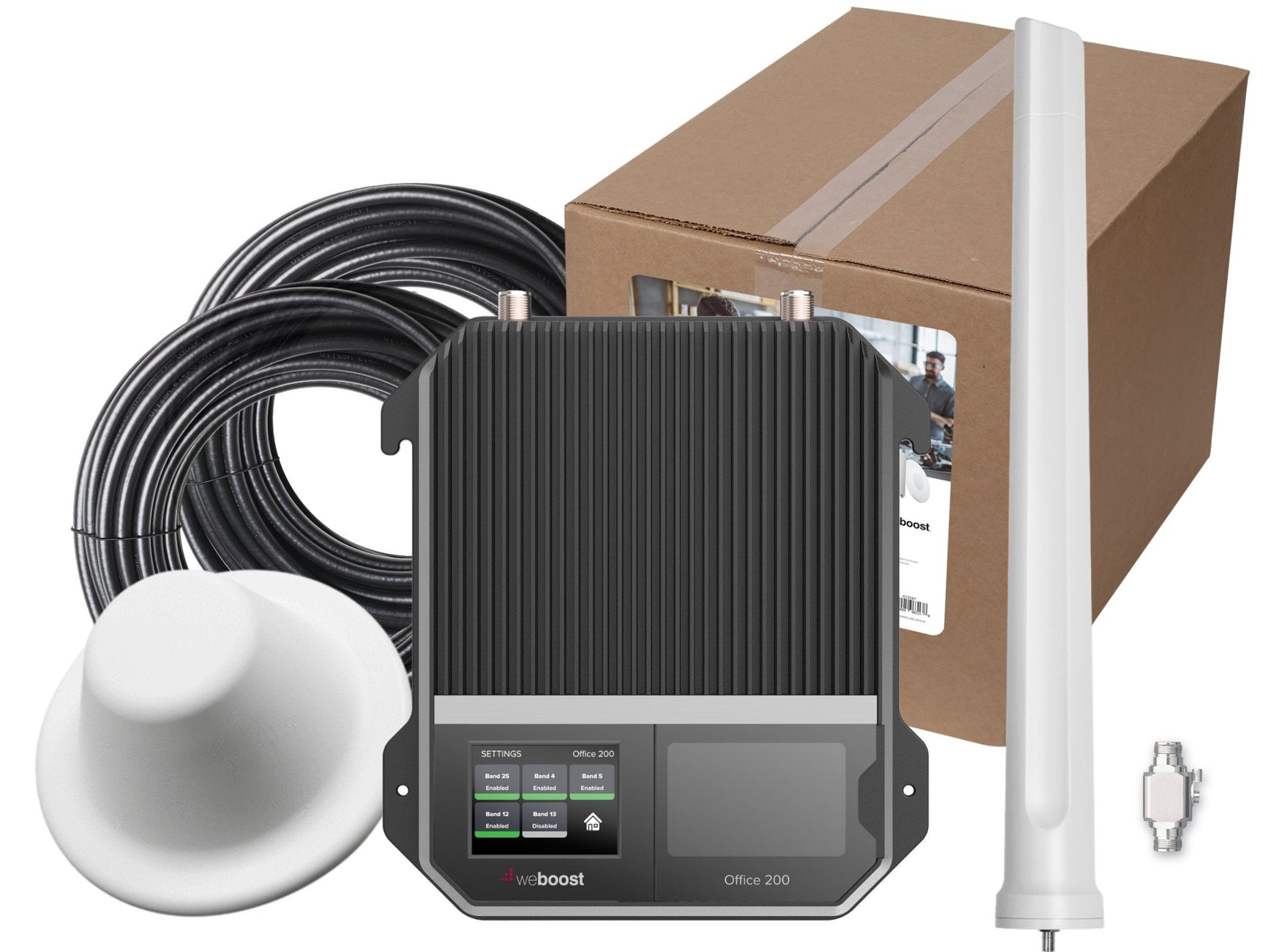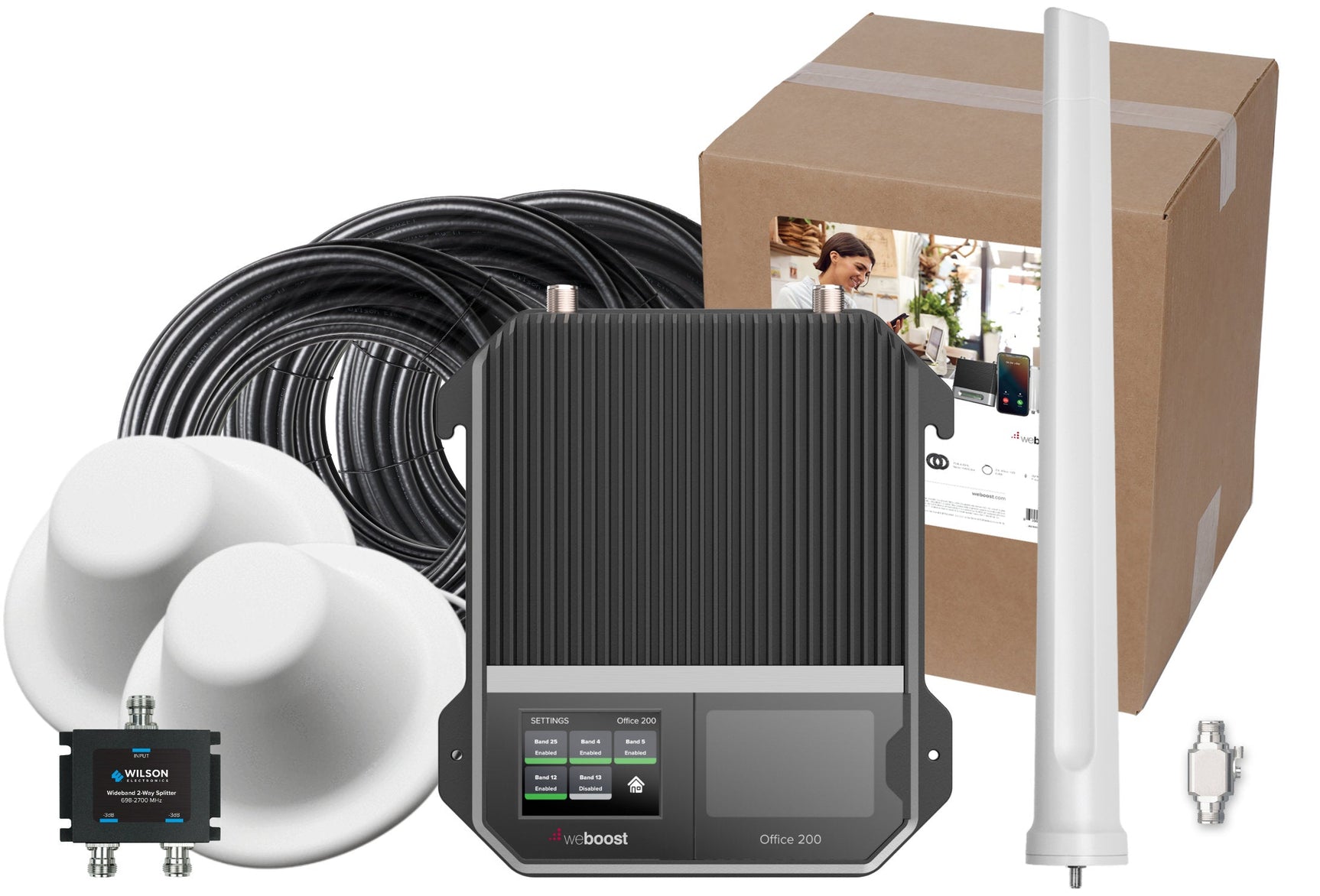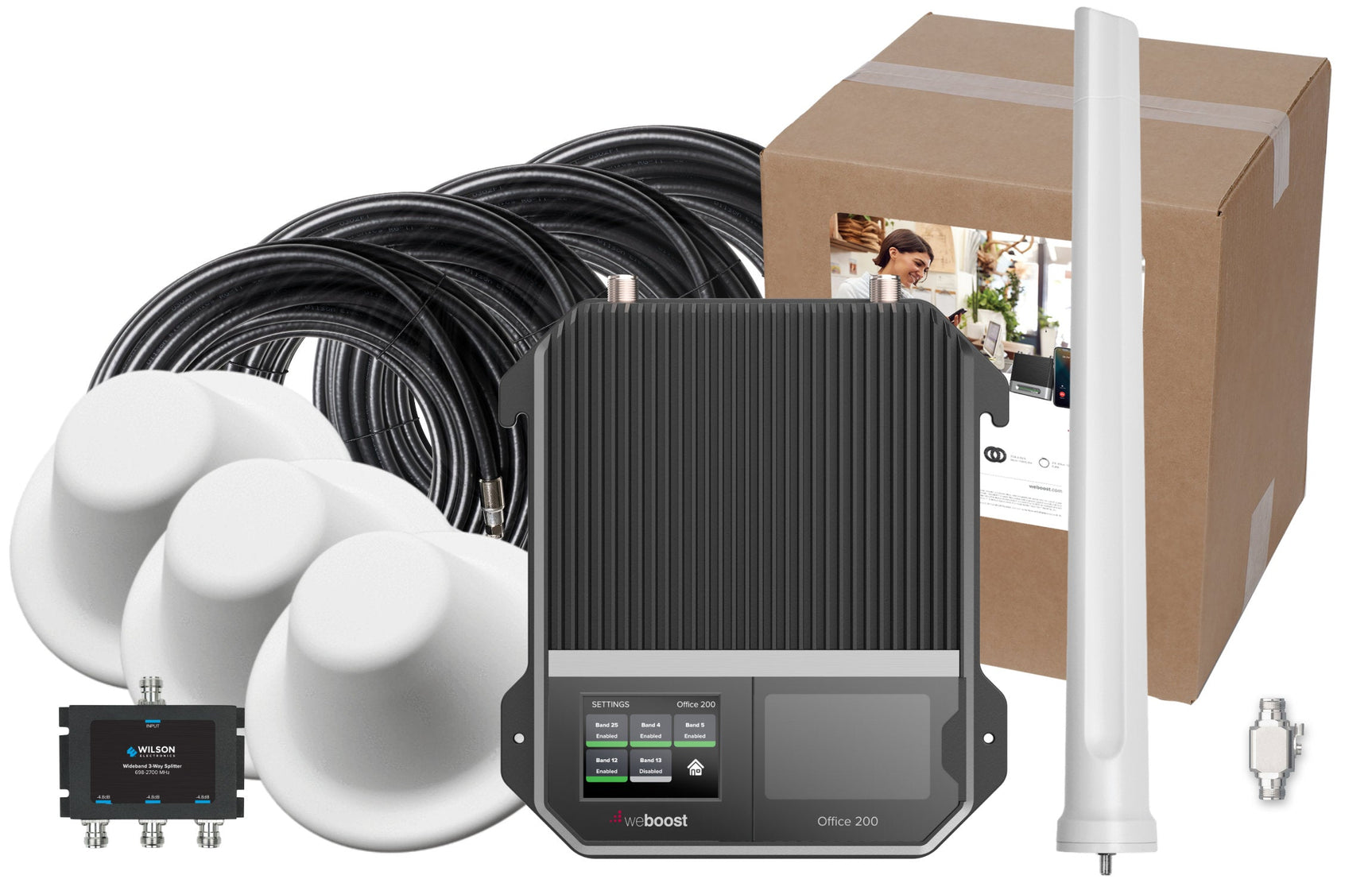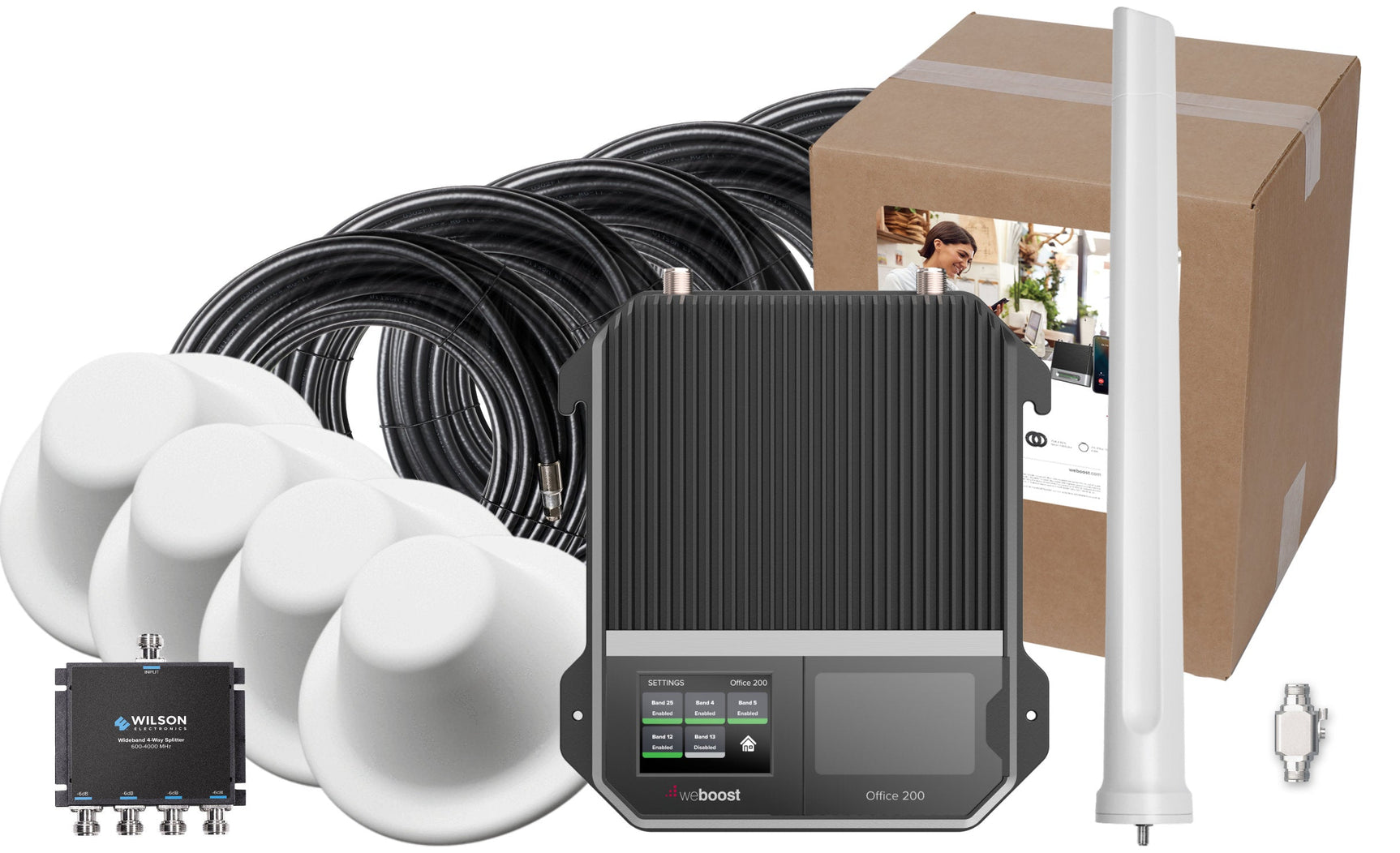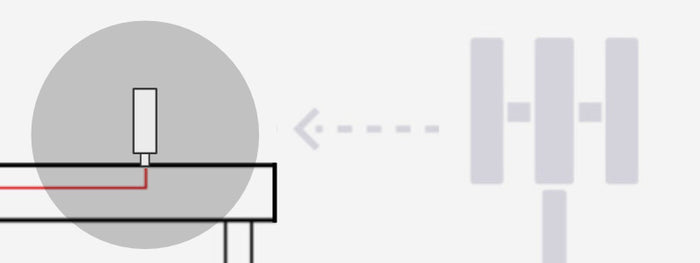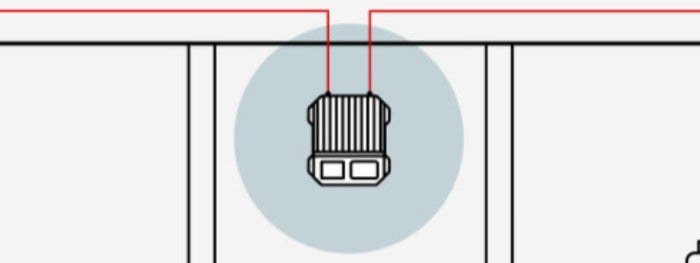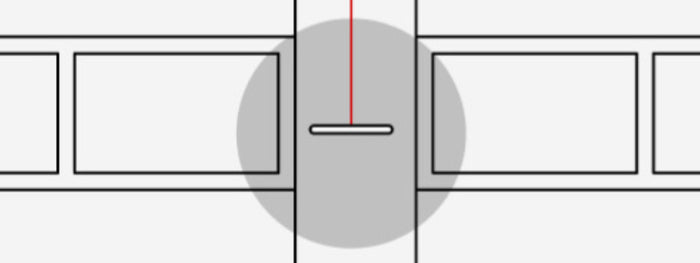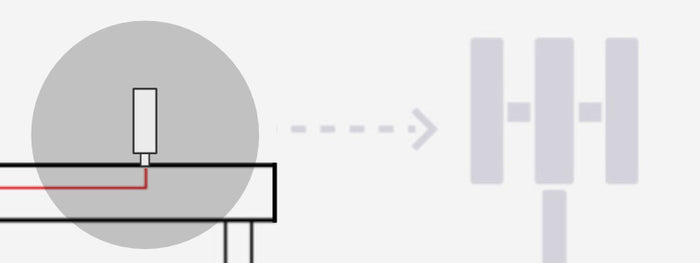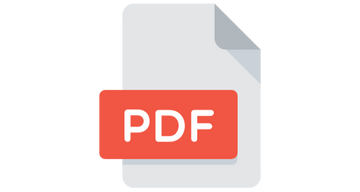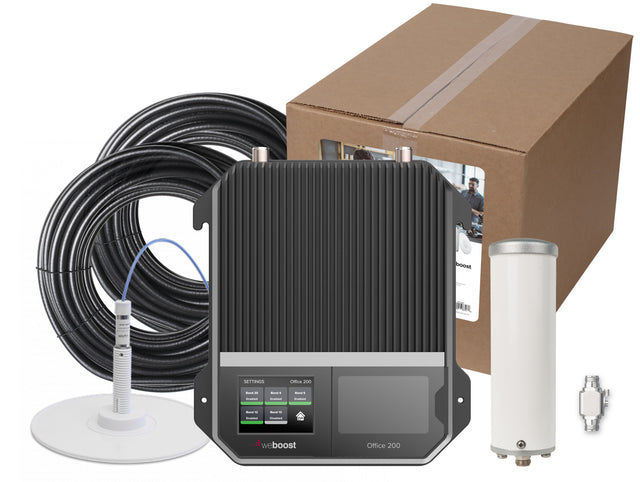weBoost Office 200 Signal Booster (50 Ohm) | 472047
90-Day Returns • Free Shipping $100+ • 3-Year Warranty
How to Choose the Right Antennas for Your Booster
Outside Antennas:
- Yagi Directional Antenna: This antenna is more powerful because it focuses on sending and receiving signals in one direction. It works best when there are no major obstacles blocking its path to the cell tower. It's not ideal for areas with large obstructions like hills or buildings.
- Omni Antenna: This antenna sends and receives in all directions, so it's better for hilly areas or if you need to support multiple carriers with towers in different directions. It doesn’t need to be aimed, but it also isn’t as strong as the Yagi antenna.
- High Gain LPDA Antenna: Perfect for areas with very weak signals, this antenna significantly boosts signal strength. It needs a clear line of sight to the cell tower and requires a sturdy mount because of its size.
- High Gain Omni Antenna: Similar to the standard omni, this antenna receives signal from all directions but delivers significantly higher gain across all supported bands. It’s a much stronger option when you want more inside coverage than a standard omni will provide, especially in areas with weaker outside signal.
Inside Antennas:
- Panel Antenna: Can be placed on walls or ceilings and directs the signal towards a specific area. This antenna is great for homes and tall ceilings in buildings.
- Standard Dome Antenna: Designed to be mounted on the ceiling, this antenna spreads the signal evenly throughout the area. It's best suited for drop ceilings or spaces where cables can be run above the ceiling.
- Ultra-Thin Dome Antenna: This slim antenna also mounts to the ceiling, but is much is less noticeable. It's much stronger than a standard dome antenna, making it a great choice for places where both looks and signal strength are important.
Tips for Choosing:
- Choose Omni Antennas for general coverage with no aiming required.
- Choose Directional Antennas (Yagi or LPDA) when you can point directly at a cell tower and need stronger signal and more inside coverage.
- Interior Size Considerations: One antenna per 750-1,500 sq ft in homes, or 1,500-2,500 sq ft in open spaces like offices and warehouses.
The weBoost 472047 Office 200 is our best professional signal booster and is the ideal choice when you need a powerful solution to provide boosted cell phone signal throughout your home or office.
Don't let the name fool you, the Office 200 is a great solution for boosting signal in your home as well as your business. It's designed to be scalable, so it can handle very large or small spaces, depending on what your situation is. It also comes with an extra year of warranty, for a total of 3 years, and a lightning arrestor to protect your investment.
In order to give you the best possible solution to improve your cell signal, we've taken the standard Office 200 kit and added more antenna options for greater power and better coverage. Read below for more information on these antenna options and how to choose the right ones for you.
If you need a powerful signal booster to provide coverage throughout your entire home or business, then the weBoost 472047 Office 200 is the solution for you.
Please Note: This is a 50 Ohm system with N-connectors. Please see the weBoost Office 200 (75 Ohm) if you need a system with F-connectors.
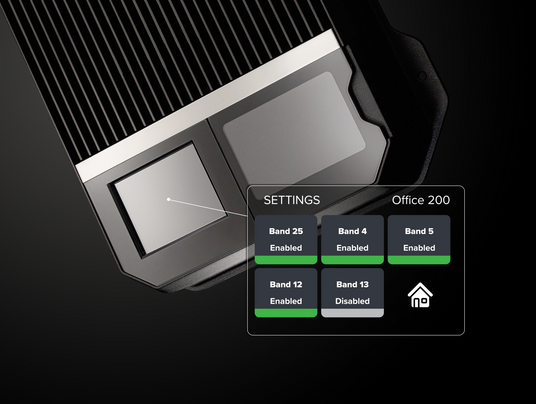
Benefits of the Office 200
- Professional-Grade Coverage: Commercial-grade equipment designed for boosting signal in large spaces. FCC-maximum uplink and downlink boosting for strong and reliable connectivity throughout your building.
- Designed to Handle Any Space: Multiple outside and inside antenna options allow you to customize the solution specifically for your space.
- Supports All Major Carriers: Boosts signal simultaneously for all U.S. and Canadian carriers, including Verizon, AT&T, and T-Mobile.
- Future-Proof Technology: Supports 3G, 4G LTE, 5G, and any future technologies deployed on FCC-approved frequency bands.
- Advanced System Monitoring: LCD screen provides real-time performance data for system monitoring, optimization, and troubleshooting.
- Free System Design Assistance: We'll customize your Office 200 system to fit your space, including a full system design, antenna recommendations, where to place antennas, cable runs & lengths, and modeling the system out to make sure it performs, at no additional cost.

Where the weBoost Office 200 Works Best
- Offices and Workspaces: Fixes signal issues in small to medium-sized offices, providing reliable coverage for employees, clients, and critical systems. Works well in standalone offices or those attached to warehouses.
- Warehouses and Industrial Facilities: Overcomes problems caused by metal walls, open layouts, and heavy machinery, making it suitable for warehouses, fulfillment centers, and workshops.
- Medical and Professional Offices: Improves signal for medical offices, clinics, and labs where communication is important for patient care, telemedicine, and daily operations.
- Hotels, Event Venues, and Conference Spaces: Provides strong, reliable signal for staff and guests in hotels, meeting rooms, and event venues, including spaces used for conferences or trade shows.
- Retail Stores and Restaurants: Ensures reliable signal for point-of-sale systems, customer service, and daily operations in retail stores, car dealerships, and restaurants.
- Large Homes and Remote Properties: Boosts signal across multi-story homes, large residences, and properties far from cell towers, including basements and other difficult areas.
How it Works
The weBoost Office 200 takes weak outdoor signal, amplifies it, and distributes it throughout your space to deliver strong and reliable coverage where you need it most. Here’s how the process works:
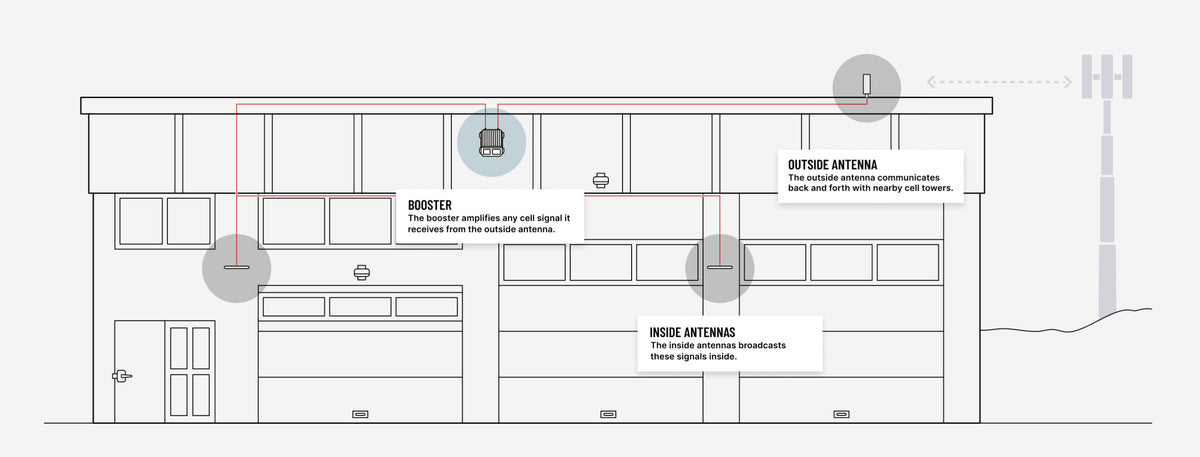
-
![]()
1. Outside Antenna Receives the Signal from the Cell Tower(s)
The outdoor antenna is mounted on your roof and receives the cell signal from the nearby towers. The antenna then passes that signal over a cable to the amplifier.
-
![]()
2. Amplifier Boosts the Weak Signal
The Office 200 amplifier, which is located inside the building, receives the signal and boosts it up to the maximum level allowed by the FCC before passing it on to the network of indoor antennas.
-
![]()
3. Inside Antenna(s) Broadcast the Strong Signal Inside
The inside antenna(s) receive the boosted signal from the amplifier and broadcasts it throughout the space. Multiple inside antennas can be used to provide more inside coverage.
-
![]()
4. Cell Signal is Boosted Back to the Tower
The system also works in reverse. When you make a call or use data, the signal is sent back through the system, gets boosted, and then sent back to the cell tower, ensuring strong signal in both directions.
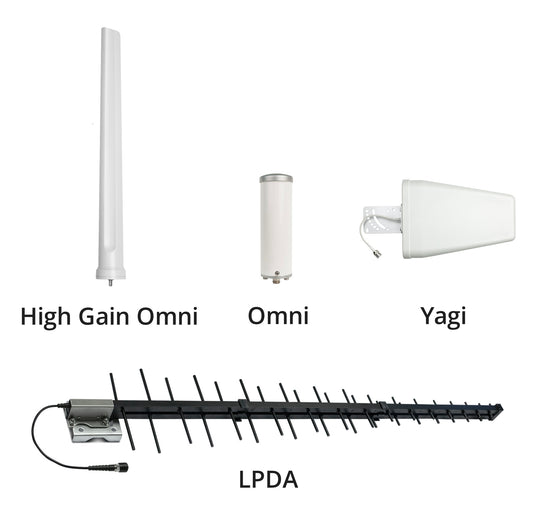
Outside Antenna Options
Choosing the right outside antenna is important for maximizing your inside coverage and maintaining a stable connection to the cell tower. Here's an overview to help you choose the right outside antenna option:
- Yagi Directional Antenna: Great for areas where you have a weak existing outside signal. With 10 dB of gain, it's second in power only to the LPDA and it offers a 75 degree view of the horizon so you don't have to be pinpoint accurate when aiming it.
- Omni Antenna: A good choice for areas with hilly or mountainous terrain and there’s no clear line of sight to a cell tower. Provides 4 dB of gain and sends & receives signal in all directions, so it can still capture bouncing or reflected signals. Will provide the least amount of inside coverage, but is the only antenna that can handle fluctuating or bouncing signal.
- High Gain Omni Antenna: For situations where you want the flexibility of an omni but with more power. Provides up to 9 dB of gain depending on the frequency, offering a major upgrade in performance over the standard omni. Best when signals come from multiple directions and the standard omni doesn’t provide enough inside coverage.
- High-Gain LPDA Antenna: Designed for remote locations with very weak existing signal. It offers 11–13 dB of gain (making it the strongest of the 3 antennas) but requires direct line of sight to the distant cell tower for best performance. It's the hardest to aim because it's so precise, but it will give you the most coverage once you have it dialed in.
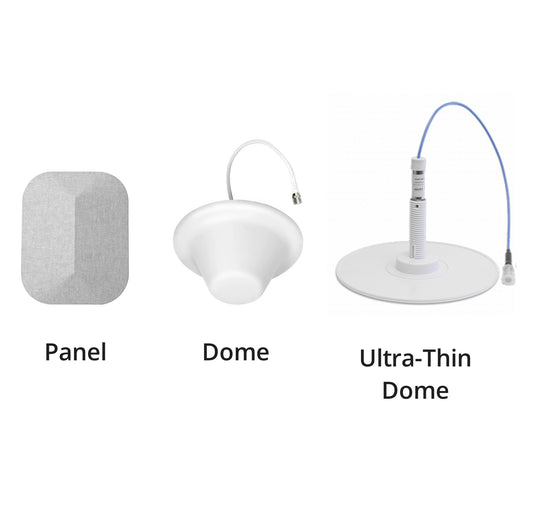
Inside Antenna Options
The makeup of your ceilings and structure of your building will determine what inside antennas you need. Here's an overview to help you choose the right type and number of inside antennas.
- Panel Antenna: This is a directional antenna that mounts to a wall, ceiling or floor and focuses signal in one direction. It's great for targeting specific areas or covering multiple floors. It offers higher gain (7-10 dBi) than dome antennas and works well for multi-story homes, long narrow spaces, or locations with high ceilings.
- Standard Dome Antenna: A ceiling-mounted antenna that broadcasts signal in all directions. It's a good option for spaces with drop ceilings where cables can be run above the tiles. With an average gain of 2-5 dBi, it’s an economical choice.
- Ultra-Thin Dome Antenna: A sleek, low-profile version of the standard dome, designed for spaces where aesthetics & performance matter. It delivers more power (4-6 dBi) and is ideal for spaces where the antenna needs to blend seamlessly with the ceiling. The cables need to be run above the ceiling for the ultra-thin dome as well.
How Many Inside Antennas do You Need?
For most spaces with walls, one antenna typically covers 750 to 1,500 square feet, while in larger, open areas without walls, an antenna can cover 1,500 to 2,500 square feet. Use this as a basis for determining the number of antennas you need.

Not only do you get the equipment to start boosting cell signal, but you get an entire time of signal experts at your disposal to make sure that you have everything you need to be successful, including:
- Custom system design and RF modeling. Request that now.
- Priority tech support for optimizing and troubleshooting your new system
- Consultation pre-installation to avoid mistakes
- Access to support materials assembled by our experts on installation pre-planning, troubleshooting, tips and more.
In the Box
-
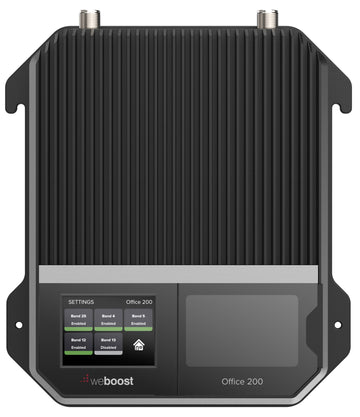
weBoost 200 Amplifier with Power Supply
-
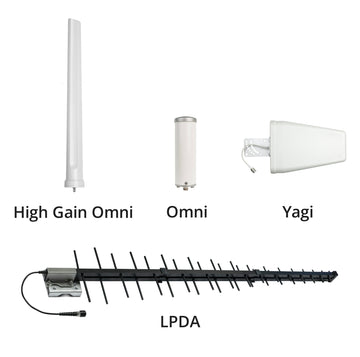
Outside Antenna
(High Gain Omni, Omni, Yagi, LDPA) -
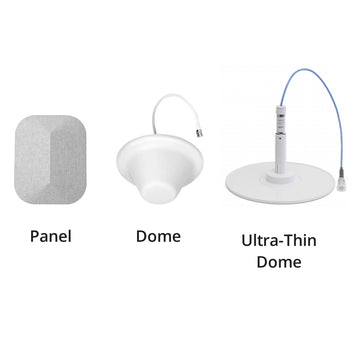
Up to 4 Inside Antennas
(Panel, Dome, Ultra-Thin Dome) -
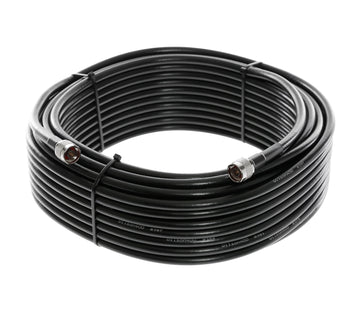
75 ft of 400 Series Cable for Outside Antenna Run
-

60 ft of 400 Series Cable - One for Each Inside Antenna
-
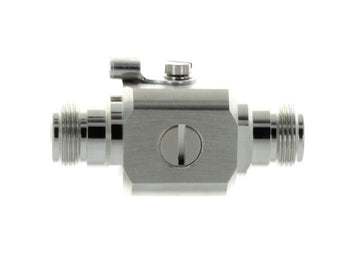
Lightning Protector
-
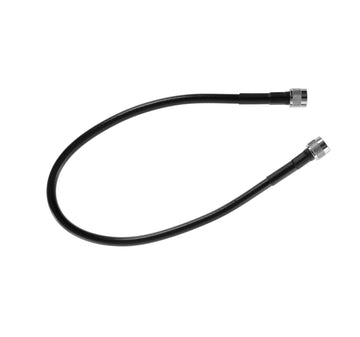
2 ft 400 Series Cable
-
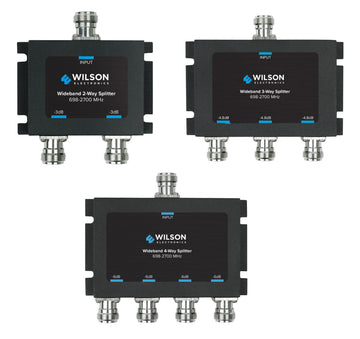
2, 3, or 4-Way Splitter for Multiple Inside Antennas
